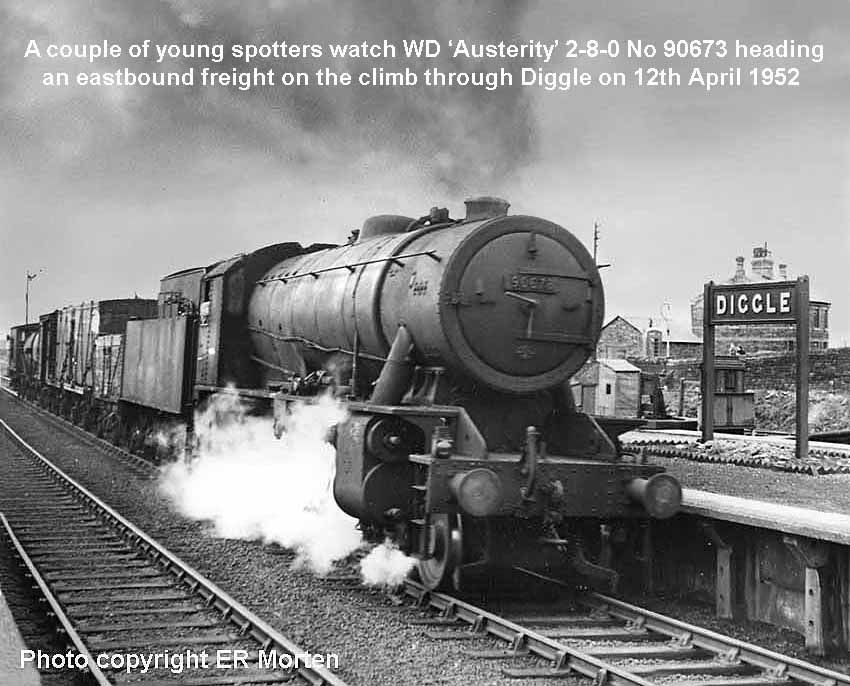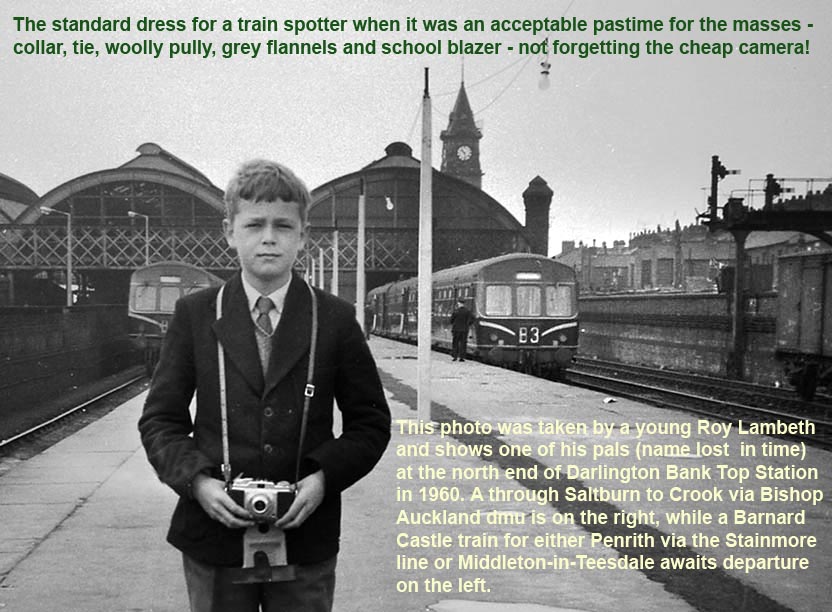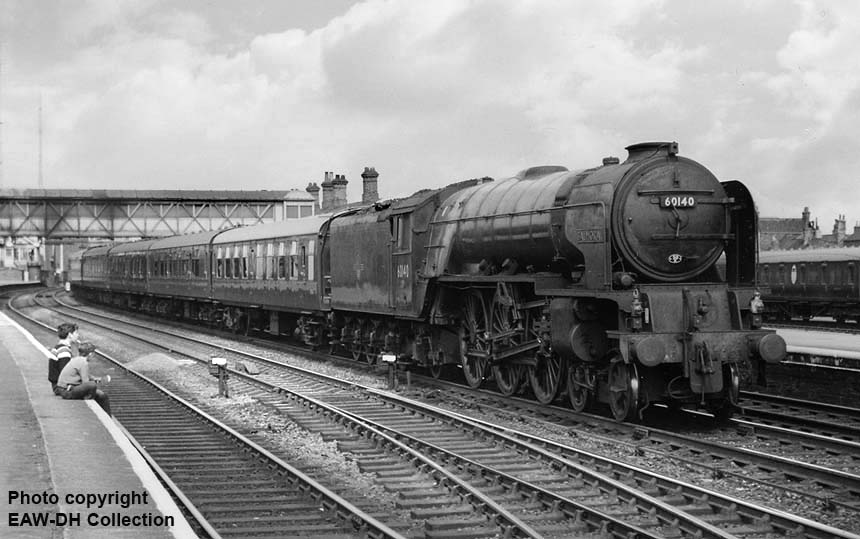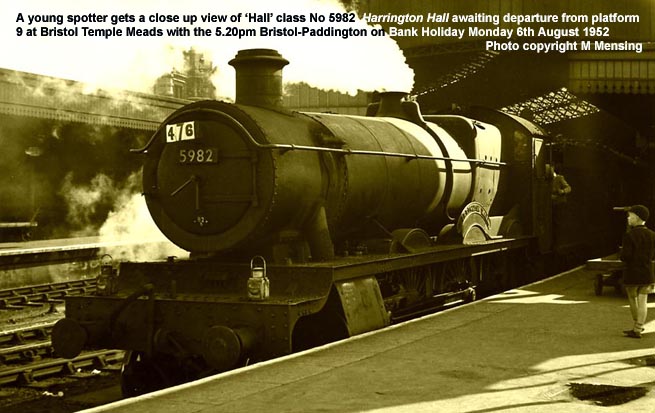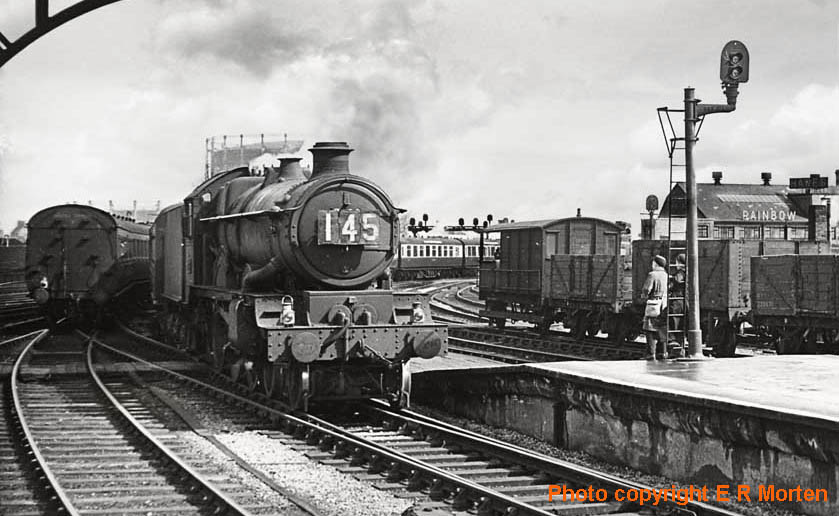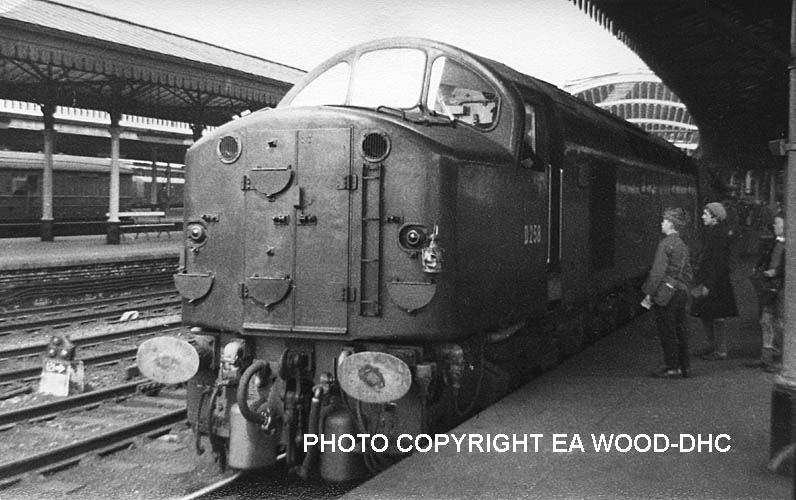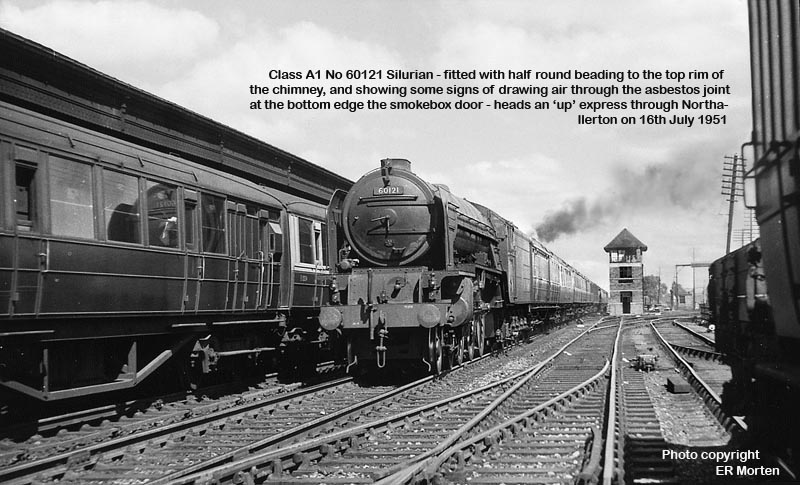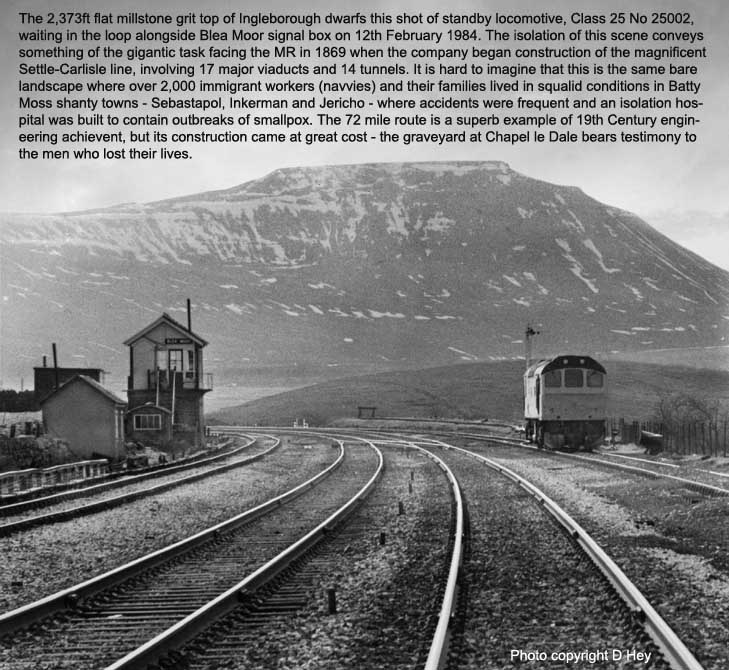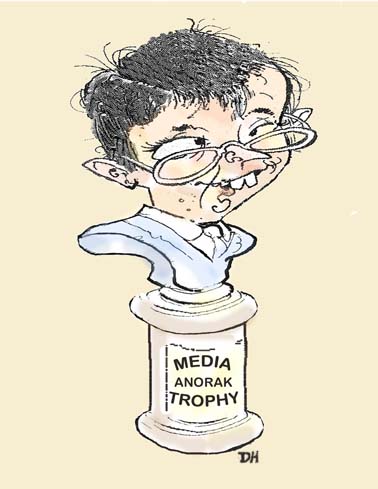 Surely I am not alone in thinking that something should be done to eradicate the cynical view the British media have of train spotters? I am fed up of the press and TV poking fun at the so-called anorak brigade who, for a variety of reasons, are perceived as a bunch of simple-minded misfits because of their passion for railways.
Surely I am not alone in thinking that something should be done to eradicate the cynical view the British media have of train spotters? I am fed up of the press and TV poking fun at the so-called anorak brigade who, for a variety of reasons, are perceived as a bunch of simple-minded misfits because of their passion for railways.
Well, if the media are entitled to an opinion, then we have every right to reply, and since the media have made a mockery of anoraks we have every reason to complain too. Moreover, train spotting is such a complicated subject to delineate, I have deliberately pitched this retrospective of it between a parody of the Sixties and a potted history of Britain's railways - and, in case anyone misses the point, the style is meant to be jokey. Even so, it is no laughing matter that train spotters have become the most risible group in the land.
Regrettably, anorak-bashing now comes with the territory, and although it means diddly-squat to me 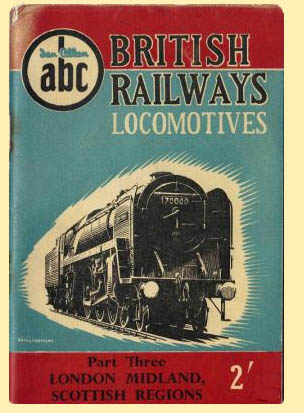 personally, I set no store by people who ride rough-shod over the unguarded, especially children. After all, the kids grow up too quickly nowadays, so they have a pretty clear idea of what is meant by discrimination - it is about taking prejudices a step too far. Take bullying at school, for example - a child may suffer a stammer, wear spectacles, be fat or skinny, but their encumbrance is not the issue here. It is just an excuse for the school bully to humiliate their victims in the cruelest way possible. But these jibes are not confined to the playground; they continue into adulthood too. The Irish are regarded as thick, the Scots tight-fisted, fat people lazy slobs, plummy-voiced Etonians upper-class twits, soccer supporters beer-swilling thugs, Essex girls blonde bimbos - yet seldom can anyone have suffered so grievously from stereotyping than train spotters. Whoa! What on earth is going on? It smacks to me of bullying of the worst kind...
personally, I set no store by people who ride rough-shod over the unguarded, especially children. After all, the kids grow up too quickly nowadays, so they have a pretty clear idea of what is meant by discrimination - it is about taking prejudices a step too far. Take bullying at school, for example - a child may suffer a stammer, wear spectacles, be fat or skinny, but their encumbrance is not the issue here. It is just an excuse for the school bully to humiliate their victims in the cruelest way possible. But these jibes are not confined to the playground; they continue into adulthood too. The Irish are regarded as thick, the Scots tight-fisted, fat people lazy slobs, plummy-voiced Etonians upper-class twits, soccer supporters beer-swilling thugs, Essex girls blonde bimbos - yet seldom can anyone have suffered so grievously from stereotyping than train spotters. Whoa! What on earth is going on? It smacks to me of bullying of the worst kind...
In fact the hobby became the focus of the National Railway Museum at York where an exhibition of ![]() spotting anecdotes was dsplayed from September 2014 to March 2015. What a brilliant idea! Let's face it, train spotters have some great tales to tell.
spotting anecdotes was dsplayed from September 2014 to March 2015. What a brilliant idea! Let's face it, train spotters have some great tales to tell.
Click HERE to visit the spotting page on the NRM's website. 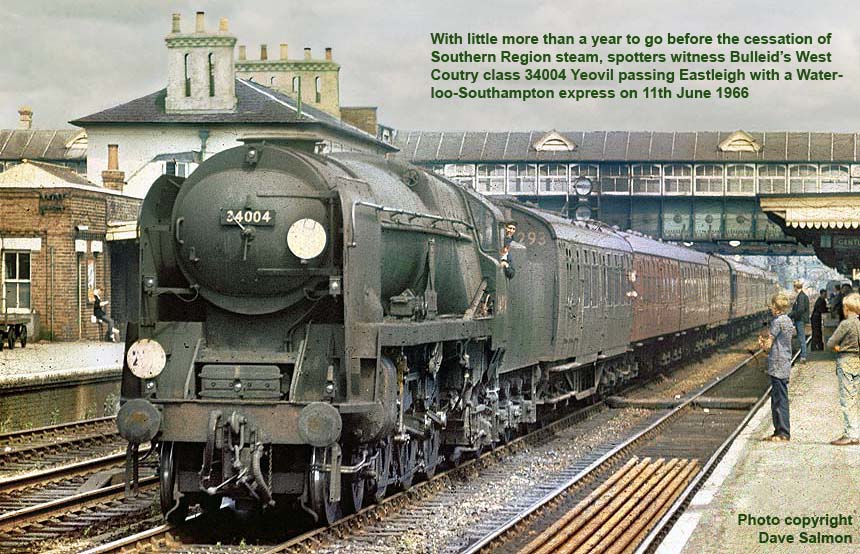

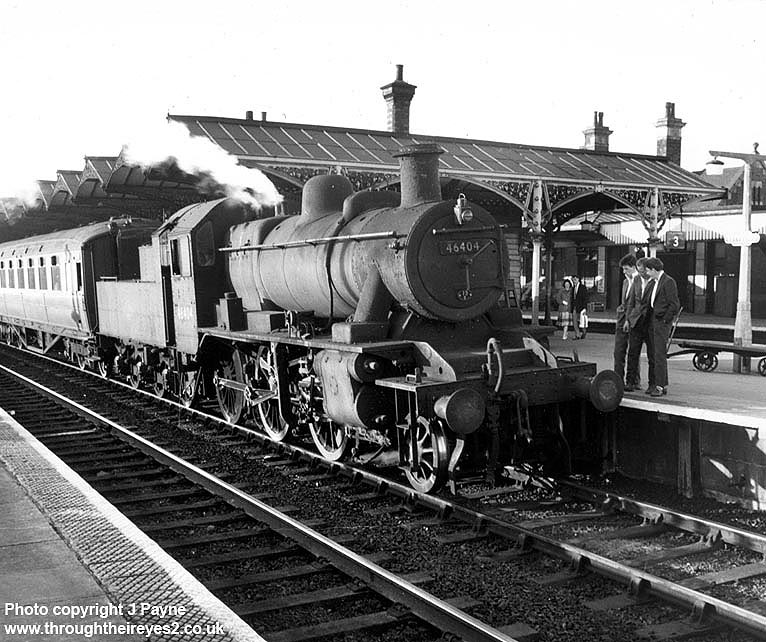
(Above) Studious-looking spotters examine the valve gear of Ivatt's Class 2 2-6-0 No 46404 at Kettering in 1960.
A DATABASE OF SPOTTERS' NOTEBOOKS
I have received an interesting email from Dave KH, who writes - 'Hi David, as a spotter from mid-60s to the mid-70s, I have been looking through your web pages and enjoyed the photos held there - you also have a number of images of pages from spotting notebooks which is why I am dropping you a line. Has anyone ever thought about creating a database of spotters' books enabling the people (who still have them after all these years) to poat all relevant information they contain into a database on a website?
This idea came to me when looking at my old books and I realised that there must be countless thousands of notebooks being lost to skips and dumps rather than being kept for future historians For example, a database has the potential of documenting the movements, existence and accuracy based on a wide range of past observations across the country; I'm thinking of basic things, such as the date; location; engine; train identification and headcode etc - plus any other information that may be considered relevant.
Needless to say, it would take a well-organised person or a team to get something like this together, but I feel it is important that something is done before we lose yet more knowledge of the past.
I must admit that my idea came from my other hobby Amateur Radio, for there is such a system where people can upload logs of contacts, enabling searches and confirmation whether or not a contact did happen! I wonder what your thoughts are or if you can pass it onto others who may be interested.
Regard, Dave...'
Good idea! I'm sure there must be someone out there who is willing to take on such a task.
Doubtless there will be plenty of ex-spotters more than happy to submit the data from their notebooks. Dave can be contacted at davekh@gmail.com Please note this is not a clickable mail-to link via Outlook Express….you will have to email manually.
(Below) In the days before absurd health and safety regulations came into play, a favourite spotting haunt was Five Arches Bridge at the north end of Derby Midland; a couple of spotters jot down the number of 'Jubilee' class 45564 New South Wales arriving with an express from Manchester Central in September 1959. 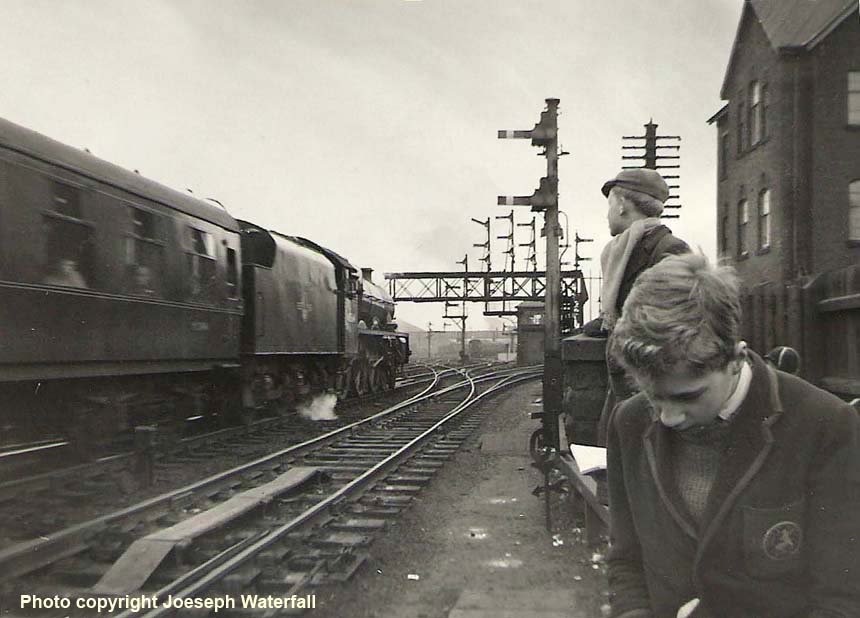
 (Left) 'Cinders and ashes!' gasps Thomas - 'That's me!' In the normal way people hate having their childhood memories messed around with, but when the 'Thomas and Friends' TV series was launched in the 1980s it surpassed all expectations and railway enthusiasts (Doubting Thomas's - if you'll forgive the pun!) were bowled over. Thomas is a registered trademark of Gullane (Thomas) Limited 2004; a HIT Entertainment Company, and I have used this poster - 'A Day out with
(Left) 'Cinders and ashes!' gasps Thomas - 'That's me!' In the normal way people hate having their childhood memories messed around with, but when the 'Thomas and Friends' TV series was launched in the 1980s it surpassed all expectations and railway enthusiasts (Doubting Thomas's - if you'll forgive the pun!) were bowled over. Thomas is a registered trademark of Gullane (Thomas) Limited 2004; a HIT Entertainment Company, and I have used this poster - 'A Day out with 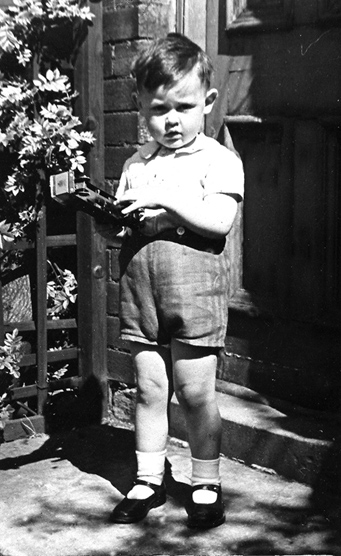 Thomas' - on the Embsay & Bolton Abbey Steam Railway to promote both the line and the Rev. W Audrey's stories, which are a huge hit with children today. Click HERE to visit the Embsay & Bolton Abbey Railway.
Thomas' - on the Embsay & Bolton Abbey Steam Railway to promote both the line and the Rev. W Audrey's stories, which are a huge hit with children today. Click HERE to visit the Embsay & Bolton Abbey Railway.
(Inset Right) Who's the kid with sticky-out ears? Hey! - it's me, if you don't mind! The only reason I've included this snapshot of a small boy clutching a tinplate toy train in the early 1950s is to show an allegiance to trains very early on in life. I spent my childhood in Horsforth within sight and sound of the Leeds-Harrogate line and one of the earliest memories is watching the stately procession of 'woo-woos' from my bedroom window, long before the 'doh-dohs' came onto the scene! That's childspeak for steam and diesels, in case you're wondering?
(Below) A group of young spotters pose for Dave Baldwin’s photo of Holbeck’s ‘Jubilee’ class No 45568 Western Australia awaiting the ‘off’ at Skipton with the Up ‘Thames-Clyde Express’ on October 11th 1958. Dave writes – ‘The identity of the boys from left to right start with Robert Gaines whilst the short lad at the front is Martin Ackroyd, with his elder brother, John, behind him with his face partially hidden; the lad at the centre back is currently unknown but I’ll work on it, whereas at the front right is Peter McKie (in his school blazer) and finally on the right is Alan Midgley…’ Happy spotting days!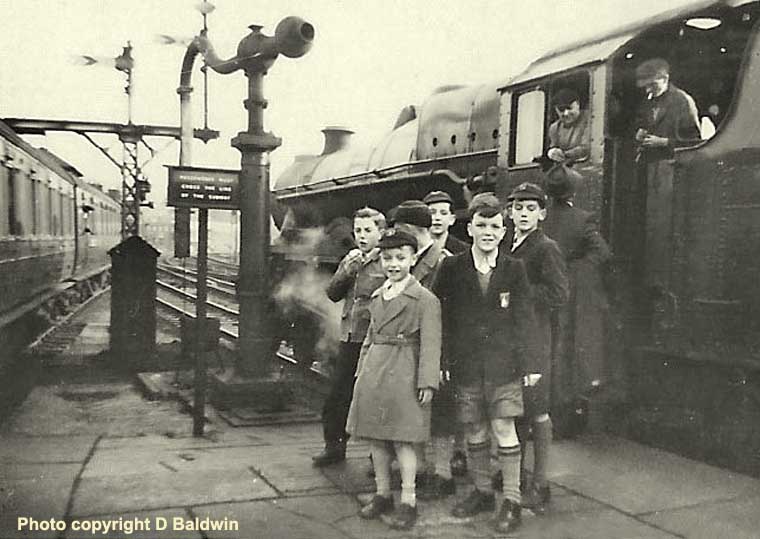
TONY PEART REMEMBERED
by
Dave Baldwin and Kevin Howley
Dave Baldwin, an ex-pupil of Keighley Boys' Grammar school, recently contacted the site to tell me about Tony Peart, one time English master at Keighley Boys' Grammar school (KBGS) and driving force behind the school's 'Railway Society'. Dave describes Tony Peart not only as a wonderful teacher, but also the 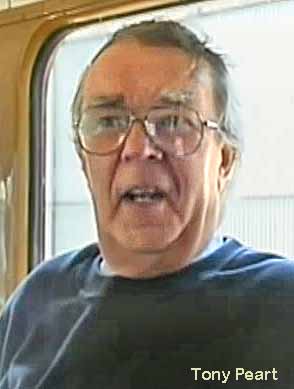 founder of the Doncaster Grammar School's collection of railwayana and the greatest contributor of the museum's artefacts.
founder of the Doncaster Grammar School's collection of railwayana and the greatest contributor of the museum's artefacts.
This superb collection is held in the tower of the Hall Cross School, now the Hall Cross Academy, originally the Doncaster Grammar School, where Michael Portillo recently paid a visit during the making of the BBC's excellent 'Great British Railway Journeys'; see Page 7 on the left hand menu.
In our exchange of emails, Dave describes how during numerous KBGS Railway Society's visits to loco depots, Tony Peart would wander off on his own whilst the boys toured the shed scribbling engine numbers in their notebooks then rejoin them later with one or two 'artefacts' which had somehow 'fallen-off' old locomotives! Indeed, Tony Peart's fellow teacher, Ian 'Rusty' Fearnside, one time metalwork master at the school, posted a comment on the Keighley Boys' Grammar School website in 2006. He writes - 'I remember Tony well 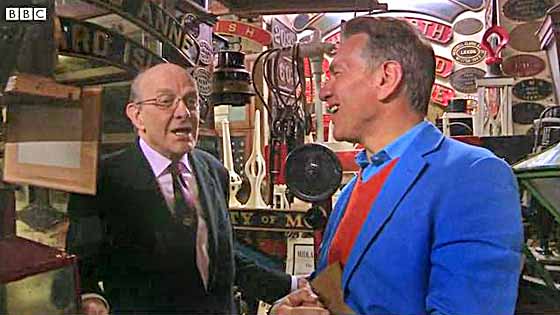 because he made great use of 'my' metalwork room. If he ever had cause to keep a pupil in for bad behaviour he brought them to the metalwork room, gave them a steam whistle from a locomotive and some emery cloth and got them to clean them up. He had boys queuing to be kept in! At Kirkcudbright (the school camp) he used to disappear every morning and return in time for the evening meal laden with pickings from closed railway stations. I remember sheaves of documents and at least one
because he made great use of 'my' metalwork room. If he ever had cause to keep a pupil in for bad behaviour he brought them to the metalwork room, gave them a steam whistle from a locomotive and some emery cloth and got them to clean them up. He had boys queuing to be kept in! At Kirkcudbright (the school camp) he used to disappear every morning and return in time for the evening meal laden with pickings from closed railway stations. I remember sheaves of documents and at least one  station clock!'
station clock!'
These quite remarkable stories about Tony Peart rekindle fond memories of my own schooldays, and I suspect there must be countless thousands of boys who remember a 'Sir' or perhaps a 'Miss'; a teacher who, for one reason or another, greatly influenced the rest of their lives...mine was the girls' gym teacher, who had big 'snog-me' eyes and legs to die for, but I won't go into that right now.
Dave's memories of Tony Peart, who sadly passed away in 2006 at the age of 72, leads me to posting some old photos and anecdotes, but I'll let Dave and Kevin take up the story...
In Memory of David Anthony Peart
I originally became aware of David Anthony Peart, or 'Percy' as he was affectionately known by the boys of Keighley Boys' Grammar School, after passing my 11-Plus exam and I entered the school as a 'First Year' pupil in September 1959. All 'new boys' were given a two-day introduction to their 'new' school plus they were encouraged to join the various School Societies' and Clubs, one of which was an immediate 'essential' for many pupils - 'The Railway Society'!
As an introduction to this celebration of 'Percy' I have copied the following articles from the 'Clubs and Societies' section of the School's six-monthly magazine 'The Keighlian' published in December and July.  This is an excerpt from the December 1959 issue, in which David Anthony Peart (DAP) writes about the School's Railway Society...
This is an excerpt from the December 1959 issue, in which David Anthony Peart (DAP) writes about the School's Railway Society...
'Although the resuscitated Railway Society is comparatively youthful it continues to thrive and members can look back on a most successful year. There were some changes in organisation at the end of the summer term and Kynnersley * (see below) has the thankless task of organising the year's programme of indoor meetings and of bullying the shyer and more retiring spirits into making some contribution to this programme. Swallow keeps a record of all our doings and if the exploits of one Funnell feature in this it should make amusing reading in years to come.
Meetings are held each week, and this, the largest of the school societies, has the additional distinction of being the only one able to keep in constant touch with its members. Shed and Works tours have continued as a very popular attraction, and, but for the difficulty of keeping a check on the large number of boys involved, it would be possible to run two coaches on many of these excursions. During the term members have enjoyed visits to locomotive sheds throughout the West Riding, to Doncaster, York and Lancashire depots. We all look forward to the return of Spring when we can once more venture farther afield.
We were sorry to say goodbye to Benson at the end of the summer term. He departed for Leeds University about the same time as the last of his favourite 'Midland Compounds' left the area for the Derby scrap yard. It would be unfair to compare him to a camel, for, after all, that was a Great Western engine, but I think we can safely say that this was the last straw. We are most grateful, however, that he found the time to come and talk to the Society on Compound locomotives and this lecture was most enjoyed. DAP.'
*In the above article David Anthony Peart (DAP) speaks warmly of Dave Kynnersley, Secretary of the Railway Society, who coincidentally left a message on this website's guest book page on April 11 2015. He writes - 'Amazing to remember the Railway Society at KBGS! A lot of trains have passed under the bridge since then. Still a passionate railway enthusiast…'
Since making contact, Dave adds - 'I was never taught by Percy, but I owe him a lot, in retrospect. I have absolutely no idea how I got to be Secretary of the Railway Society. All I remember about the job was sending off for shed permits for the trips. I recall 'Percy' giving me Festival of Britain stamps - with George the 5th head on them - to use for the purpose - ten years after the King died!
Percy also encouraged me to join the RCTS. During one such RCTS trip I encountered him rummaging through a pile of old documents in a filthy disused shed; in fact I still have, somewhere, a pile of similar documents he sent to me.
I watched the BBC's 'Great British Railway Journeys' when Michael Portillo visited the museum at Doncaster Grammar School, but I'm afraid I hadn't picked up on the fact that Percy was in some way responsible for any of the collection - but it fits!
I'm sending you these photograph my father took of Society members gathering on North Street, Keighley at the start of one of the Society's shed bashes…' 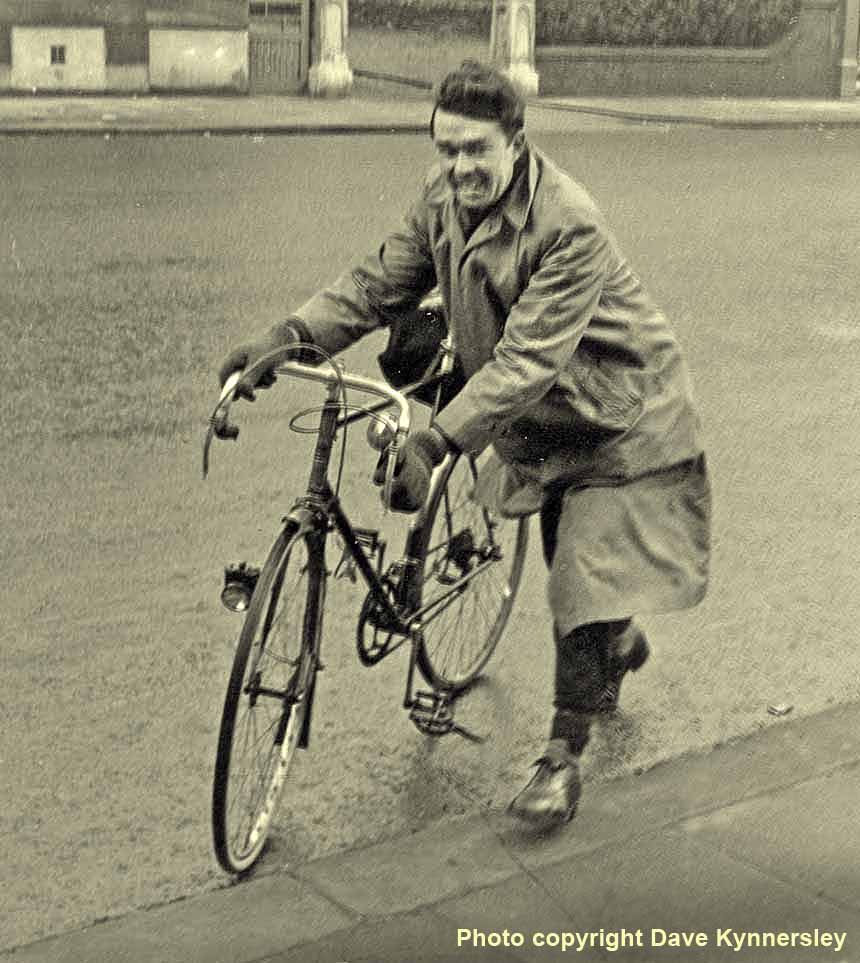
(Above-Below) A unique photograph of Tony Peart arriving on his bike ready for the 'Grand Depart' and one of Dave Kynnersley (below) wearing the obligatory anorak along with other Railway Society members with their duffel coats, haversacks and duffel bags, awaiting the arrival of the Bronte bus.
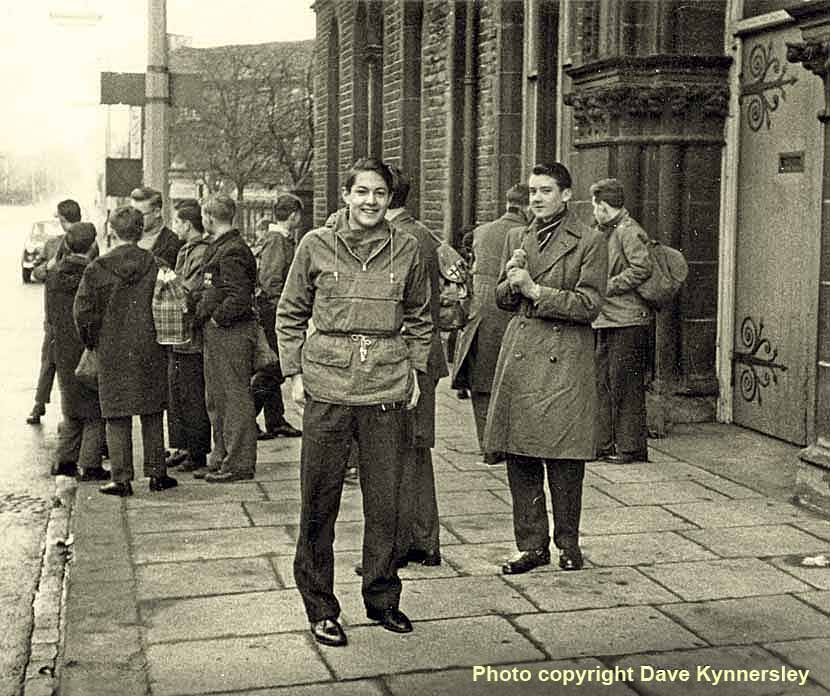
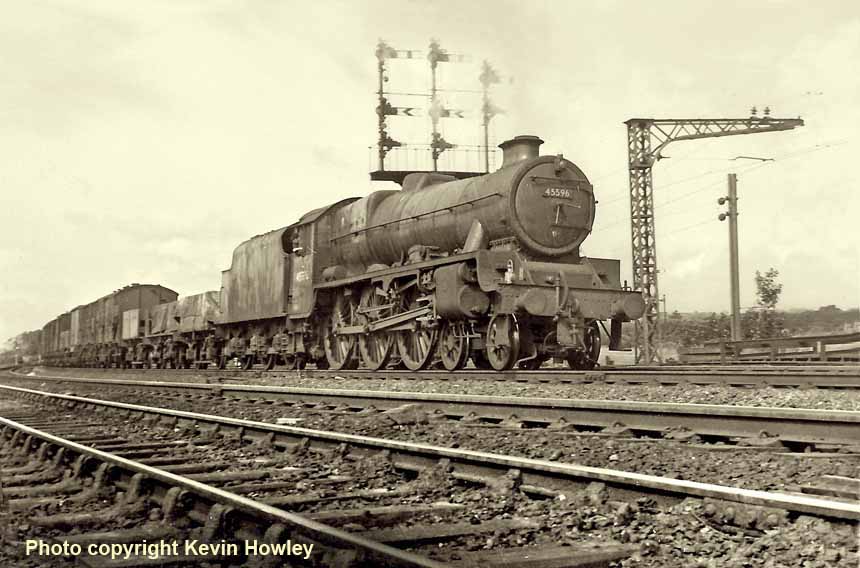
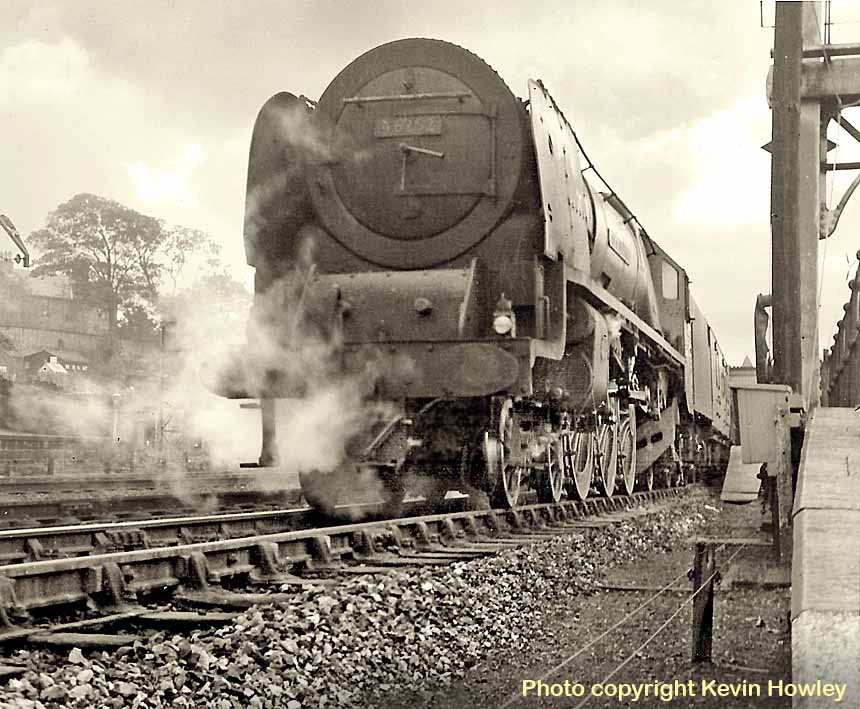
In the July 1960 issue of 'The Keighlian', JSV commented - 'The Society continues to thrive, and it is no idle boast that it is the most 'alive' of all the School Societies. Meetings are held, as far as possible, every week, thanks mainly to Kynnersley and his enthusiasm in arranging someone to speak on anything to do with railways, whether at home or abroad. These reticent beings hide behind the 'magic lantern' and deliver their orations from there. On vacant dates our Chairman can be persuaded to speak, an easy matter for him as anything he does not know about Britain's railways is not worth knowing. The attendance usually exceeds thirty per week, and this could easily be more, if the common or garden 'train-spotter' was desirous of learning more about railways and their history.
Outdoor activities have continued with similar success to the indoor meetings. When notice of a future trip is put on the notice board, it is a pretty safe bet that there will be a dozen names on it within half an hour. Unfortunately, our usual vehicle hired from Bronte Tours, HWY 79, only seats thirty-two persons, and consequently half of the people, whose names appear in pencil, red 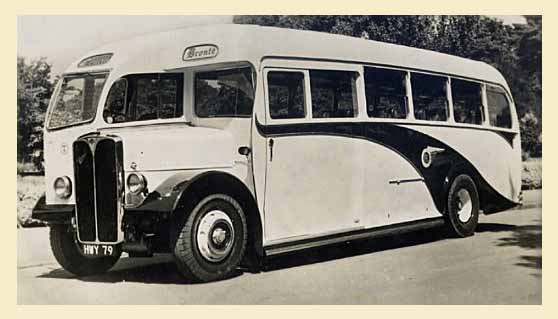 and blue 'Biro', ink and other writing materials, are disappointed.
and blue 'Biro', ink and other writing materials, are disappointed.
There is, however, a certain anonymous young man (not our Chairman), who sometimes appears on these coach tours, but whose name, to my knowledge, does not appear on the notice board. The Bronte 'bus has appeared, since Christmas in many Lancastrian towns, and at the time of writing the Society has just had an excursion to Crewe, Shrewsbury and North Wales, its longest and most ambitious tour so far.
Now the days are coming longer, similar peregrinations to the north-east and north-west are being planned, and there will no doubt be shorter excursions to Doncaster, Leeds and Bradford for the younger members. Older members usually come back with various pieces of metalware, previously residing on derelict, or apparently derelict engines which have 'come off in their hands'(?) In conclusion, may the Society continue to thrive, and may members have memories for years to come of coach tours to the lesser known parts of industrial northern England. JAS (IVB)...JAS refers to the author of the article and 1VB represents Form 4B using Roman numerals.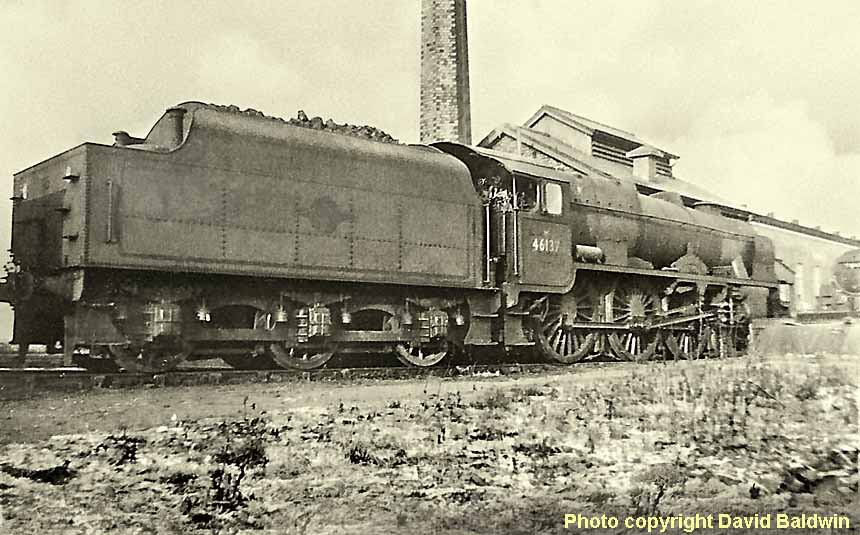
(Above-Insert Left) In February 1961, a KBGS Railway Society trip to motive power depots in Lancashire included a visit to Buxton shed (9D) where 'Royal Scot' class No 46137 The Prince of Wales's Volunteers 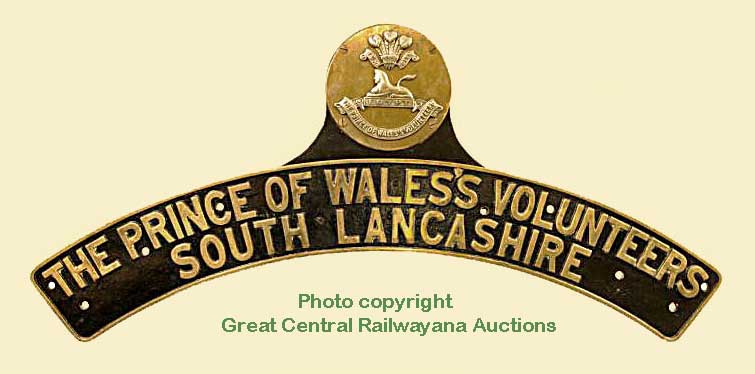 South Lancashire was photographed 'dead' in the shed yard. (Inset left) Measuring 50½" long, a nameplate from LMS Royal Scot Class 7P 4-6-0 No 6137, 'The Prince of Wales's Volunteers South Lancashire' including its Regimental badge, went under the hammer for £26,500 at a Great Central Railwayana Auction in July 2014. Built by the North British Locomotive Co (Works No 23632) in 1927, the locomotive was the last of the 'Royal Scot' class to be rebuilt with tapered boiler in March 1955. Originally named 'Vesta' after the pioneer loco built by Robert Stephenson, it was renamed after the Regiment at Warrington Bank Quay station in October 1936. Allocated new to Crewe North in October 1927, its later sheds included Upperby, Camden, Crewe North, Edge Hill, Longsight, Saltley and finally back to Upperby from where it was withdrawn on 31 October 1962 and cut up at Crewe Works in May the following year. Click HERE for news of forthcoming railwayana auctions and the results of past auctions on the fascinating GCRA website.
South Lancashire was photographed 'dead' in the shed yard. (Inset left) Measuring 50½" long, a nameplate from LMS Royal Scot Class 7P 4-6-0 No 6137, 'The Prince of Wales's Volunteers South Lancashire' including its Regimental badge, went under the hammer for £26,500 at a Great Central Railwayana Auction in July 2014. Built by the North British Locomotive Co (Works No 23632) in 1927, the locomotive was the last of the 'Royal Scot' class to be rebuilt with tapered boiler in March 1955. Originally named 'Vesta' after the pioneer loco built by Robert Stephenson, it was renamed after the Regiment at Warrington Bank Quay station in October 1936. Allocated new to Crewe North in October 1927, its later sheds included Upperby, Camden, Crewe North, Edge Hill, Longsight, Saltley and finally back to Upperby from where it was withdrawn on 31 October 1962 and cut up at Crewe Works in May the following year. Click HERE for news of forthcoming railwayana auctions and the results of past auctions on the fascinating GCRA website.  (Inset Right) Measuring 48½" long, a nameplate from LMS Class 7P Royal Scot class No 6111 'Royal Fusilier' (later BR 46111) went under the hammer for £8,800 at a Great Central Railwayana Auction in October 2014. Built by the North British Locomotive Co (Works No 23606) in 1927 and named after the London-based Regiment early the
(Inset Right) Measuring 48½" long, a nameplate from LMS Class 7P Royal Scot class No 6111 'Royal Fusilier' (later BR 46111) went under the hammer for £8,800 at a Great Central Railwayana Auction in October 2014. Built by the North British Locomotive Co (Works No 23606) in 1927 and named after the London-based Regiment early the 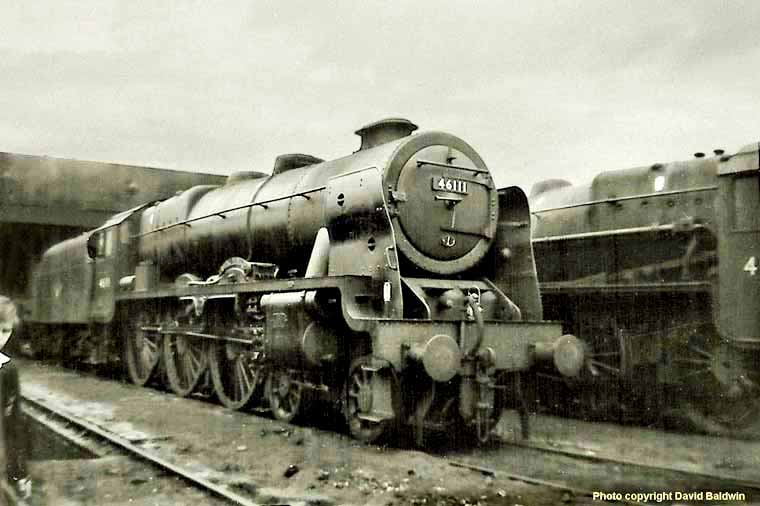 following year, the locomotive was allocated new to Rugby in September 1927; this was followed by moves to Camden, Longsight, Edge Hill, Willesden and finally Annesley on the Great Central from where it was withdrawn on 27 September 1963 and cut up at Crewe Works in October 1963.
following year, the locomotive was allocated new to Rugby in September 1927; this was followed by moves to Camden, Longsight, Edge Hill, Willesden and finally Annesley on the Great Central from where it was withdrawn on 27 September 1963 and cut up at Crewe Works in October 1963.
(Left) Another KBGS Railway Society trip, this time to sheds in the Manchester area in September 1960. A blazered-pupil almost gets in the way of this creditable Kodak Brownie 127 shot of 'Royal Scot' class 46111 Royal Fusiliers at Longsight (9A).
In the December 1960 issue of 'The Keighlian' David Anthony Peart has a genial dig at pupils verging on the cusp of manhood - 'The Railway Society continues to flourish and has been able to hold meetings without diminution of support, although people disappear, torn away by the attractive maidens of Greenhead Road, and are replaced by others who find that the steam locomotive supplies femininity enough for them - for do we not always refer to it as she?
Not very much of Northern England remains unexplored and a recent, very successful tour covered most of Lincolnshire and part of South Yorkshire. Many were pleasantly surprised by the number of pre-Grouping locomotives still at work, and well cared for, at Mexborough, whereas Mr Peart was plunged into gloomy reverie by the disappearance of much-loved Pullman car (GNR 'Prince of Wales', 1876) from the yard of Lincoln locomotive shed.
For the first time ever, our trusty HWY 79 was not with us, having succumbed to a puncture as we set-off, and was replaced by the Commer Avenger, which, although it put up a gallant performance, was thought by those who care for such things to be rather inferior. It carried a large party without intolerable discomfort, however, although Mr Peart did duty as a suitcase, perched in a little railed enclosure at the front, for most of the day.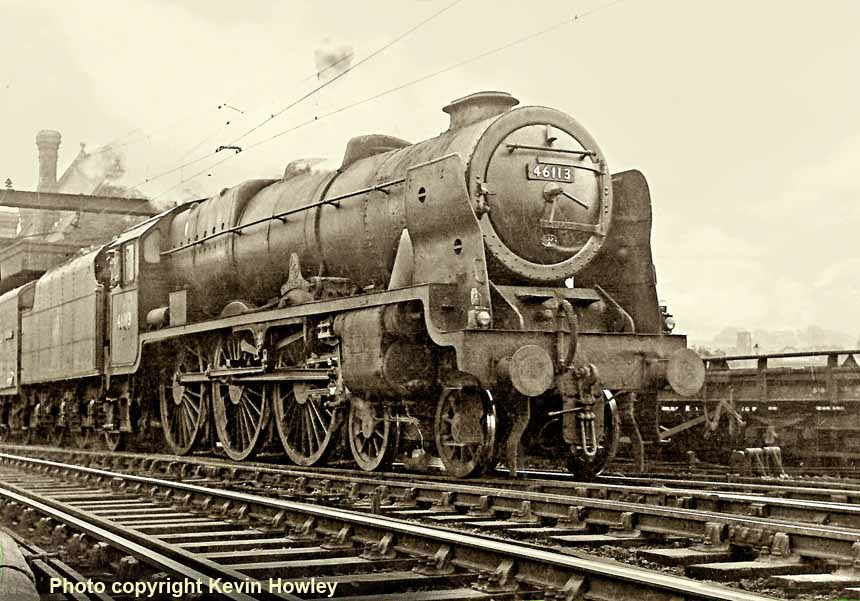 Another enjoyable visit during the term was the East Midlands trip. Most interesting was a half-cab Johnson 0-6-0 tank, just overhauled and repainted, at Kirkby. Colwick provided several 'ragtimers', no doubt our last view of them, and other fascinating antiques.
Another enjoyable visit during the term was the East Midlands trip. Most interesting was a half-cab Johnson 0-6-0 tank, just overhauled and repainted, at Kirkby. Colwick provided several 'ragtimers', no doubt our last view of them, and other fascinating antiques.
Annersley and Langwith both proved enthralling to the 'coachmen', and some people enthused over rococo monograms and celerestory roofs. Further visits, which will have been undertaken by the time this appears in print, are to Doncaster and West Riding sheds.
Kynnersley continues as Secretary and Lottey has taken over the post of Society Recorder on Swallow's departure. DAP...' 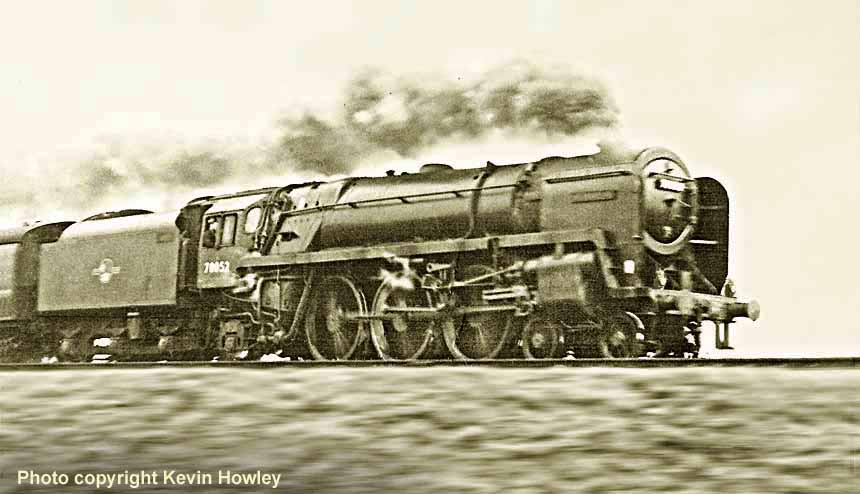
 The July 1961 issue of 'The Keighlian' was 'Percy's' final entry; he writes - 'Enthusiasm remained at a high level during the year and several interesting excursions were arranged. The Society visited depots in Lancashire during the Spring Term and there was also a tour of locomotive sheds in the West Riding. The year's most ambitious excursion was that to Furness and the Lake District which was excellent as a scenic tour, apart from the railway interest. This was no doubt the last time the Society could visit as many as seven locomotive depots and see only one diesel shunter and two railcars.
The July 1961 issue of 'The Keighlian' was 'Percy's' final entry; he writes - 'Enthusiasm remained at a high level during the year and several interesting excursions were arranged. The Society visited depots in Lancashire during the Spring Term and there was also a tour of locomotive sheds in the West Riding. The year's most ambitious excursion was that to Furness and the Lake District which was excellent as a scenic tour, apart from the railway interest. This was no doubt the last time the Society could visit as many as seven locomotive depots and see only one diesel shunter and two railcars.
The most interesting shed visited was undoubtedly Barrow which is the last stronghold of the standard 0-6-0 tank engines of the LMS, long known as 'Jinties'. Barrow also maintains a number of very old Midland 0-6-0s for lines requiring engines with light axle-loadings. Several of these unrebuilt Johnson 0-6-0s were seen. Numerous coaching curios were viewed with interest, including what may well be the last example of the North London Railway four-wheelers, renowned for their villainous riding qualities.
The Society lost another stalwart member in the departure of RN Higgins. We wish him success in his career and in his worth-while research into local railway-history. * see note below...
This is my swan-song as Master-in-Charge of the Railway Society and I should like to place on record my own appreciation of the enthusiasm and, in many cases, considerable erudition of its members during my three years at the school. I hope that the Society will continue to prosper in future years. DAP...'
*RN Higgins' was one of the founder members of the Keighley & Worth Valley Preservation Society and went on to found the Vintage Carriages Trust. Although I worked with him during the early days of the Worth Valley, I must admit that I didn't realise that he was an Old Boy of KBGS!
ME Lottey from Form 5B, who was the Society's Secretary, added his own comments; he said - 'Although the future of the Society is still rather uncertain it continues to thrive. Mr Peart, our present leader, is leaving us at the end of Term and if Mr Dunthorne does not take over, the Society may be disbanded unless Kynnersley and I can cope with everything.
However, to move on to a rosier subject, members of the Society will have been on four more excursions, namely the West Riding, Manchester, East Lancashire and Furness districts. The largest trip ever has been proposed for July to the Birmingham area.
The meetings, though fewer, are still held in our old home, Room D4, except for one in Room 63 and another in Room 33, attendances average 30 every week and the lunatic fringe is still very active.
Finally I would like to extend the hearty thanks of the whole Society to Mr Peart for his excellent chairmanship during his stay. We also wish him luck for the future. ME Lottey (5B).'
(Above-Below) It is remarkable how our old Brownie 127 photos have stood the test of time. Having replenished its tender on Hest Bank troughs between Carnforth and Lancaster, an unidentified Class 8P 'Duchess' dashes south with a London-bound express; one wonders if the washing on the line in the adjacent garden ever had chance to dry with the ensuing overspill of water from passing trains! (Below) Fellow pupil, Kevin Howley, was also inspired by Tony Peart. Kevin's shot of both driver and fireman looking out from unnamed 'Patriot' class No 45550 in readiness to dip the scoop at Hest Bank water troughs would grace the cover of any 'Boys Wonder Book of Trains'. For the record, the 'X' sign ahead marks the starting point of the troughs.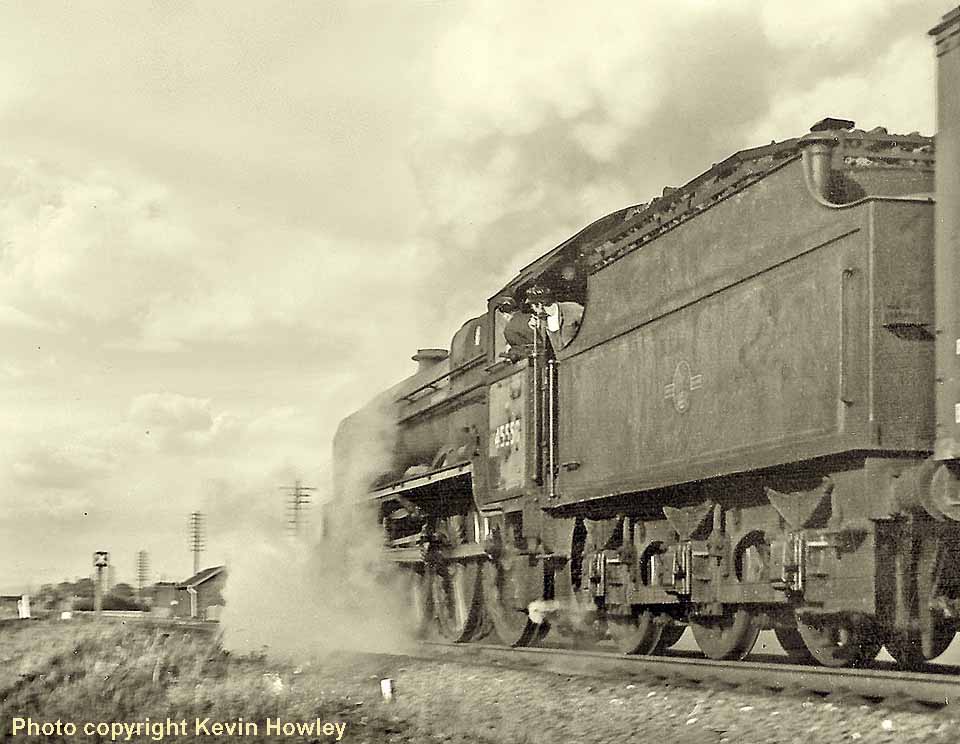
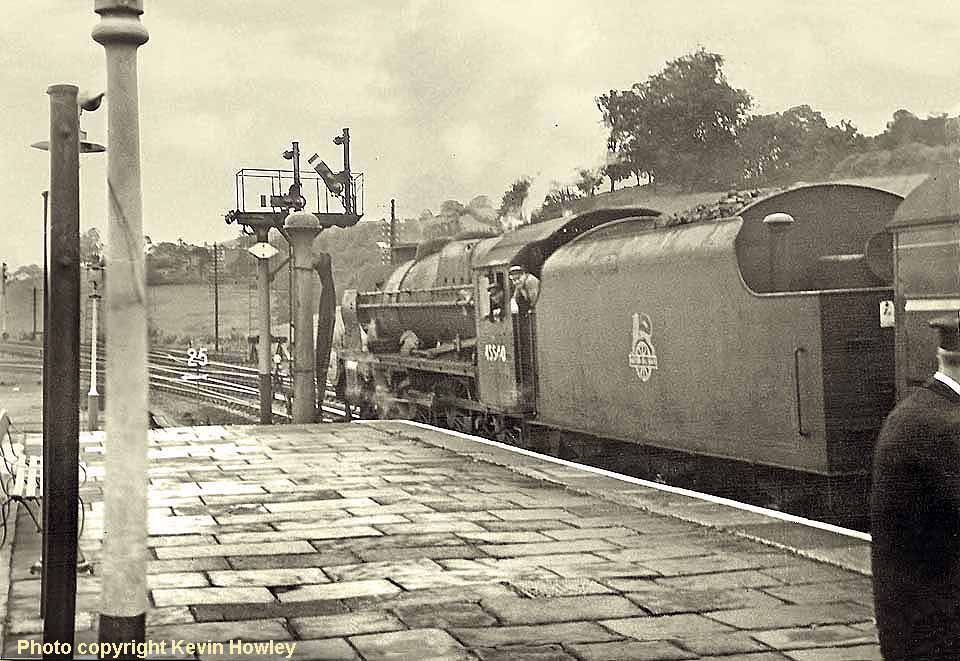
(Above) An interesting shot by Kevin Howley of rebuilt 'Patriot' class No 45540 Sir Robert Turnbull awaiting 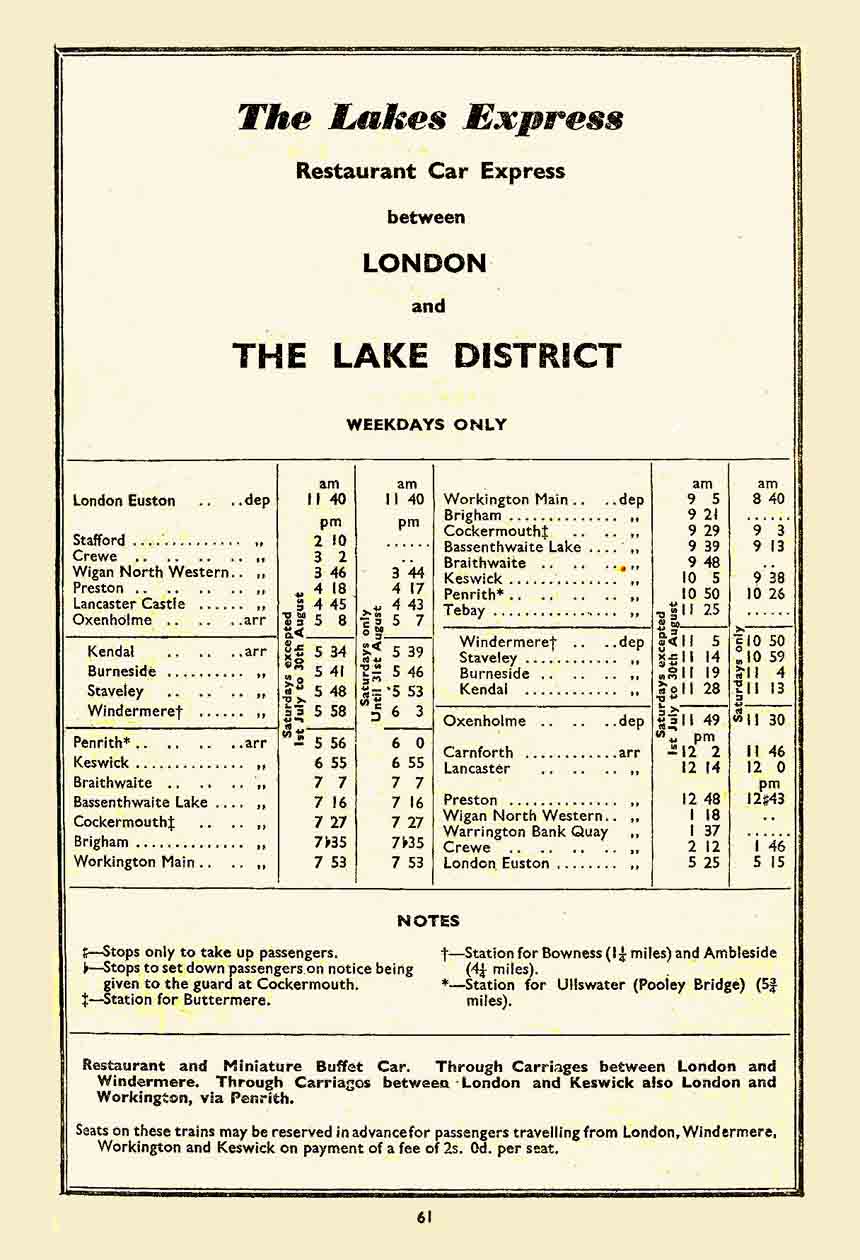 departure at the north end of Oxenholme station; the divergence of the Windermere branch can be seen on the left. The station was built in 1846, but the double turn-out junction was taken out of use in May 1968, and the removal of a run-round loop at Windermere has effectively reduced the once double-track branch to nothing more than a long siding capable of dmu operation only. It's a far cry from the heydays of the 'Lakes Express' - click-on the timetable insert right to enlarge...
departure at the north end of Oxenholme station; the divergence of the Windermere branch can be seen on the left. The station was built in 1846, but the double turn-out junction was taken out of use in May 1968, and the removal of a run-round loop at Windermere has effectively reduced the once double-track branch to nothing more than a long siding capable of dmu operation only. It's a far cry from the heydays of the 'Lakes Express' - click-on the timetable insert right to enlarge...
(Below) While the branch from Oxenholme to Windermere mercifully survived the Beeching axe, today's terminus station at Windemere is a shadow of its former self. The station once boasted four platforms and an overall roof, but a year after goods traffic ceased in 1972 three tracks were taken out of use and the branch reduced to a single line leaving just a solitary platform served by one track. Following demolition of the trainshed a new station was built and a supermarket now occupies the site of the original station building. Memories of better days can be seen in Kevin Howley's shot of a Stanier 'Black 5' No 45201 awaiting departure from the terminus in the early 1960s.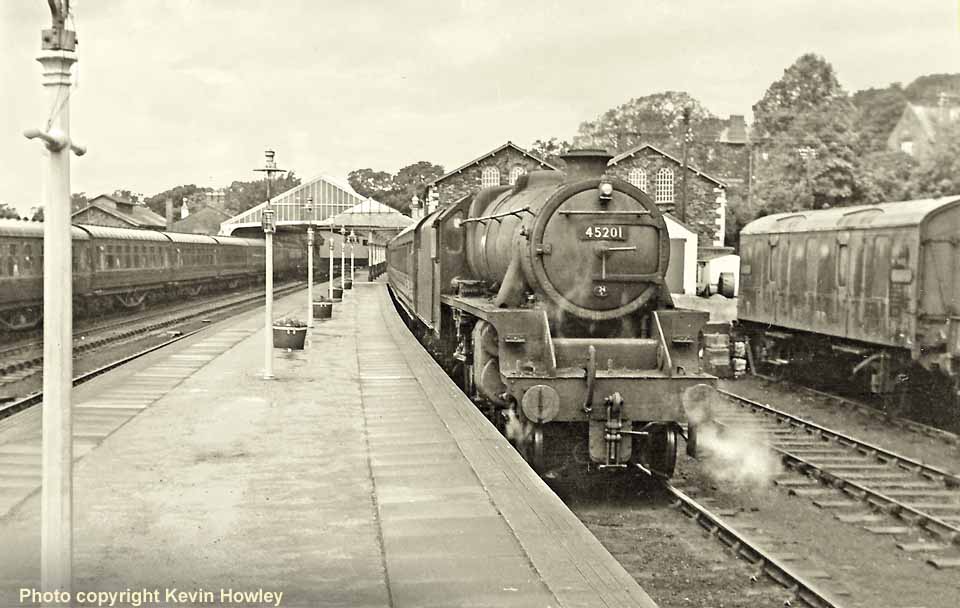
'SPOTTING MEMORIES 1'
Brian Cooke recalls a marathon 1960's shed bash!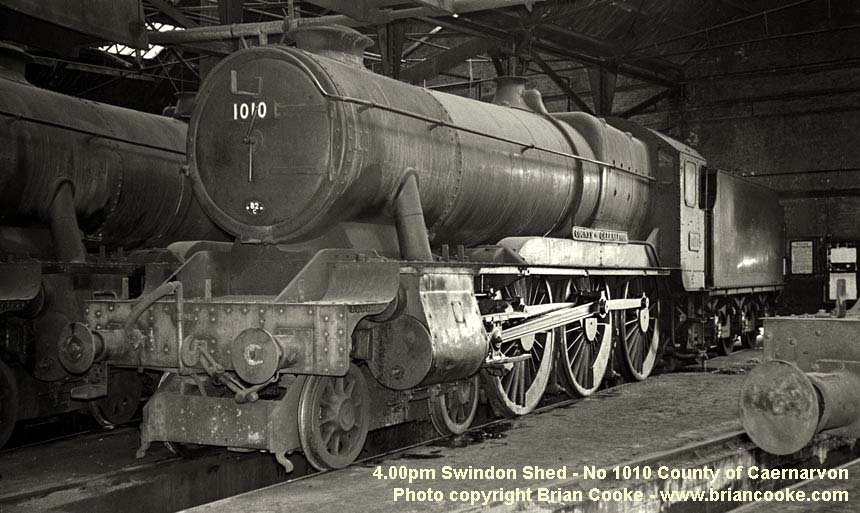
Photos and text by Brian Cooke
For me, train spotting was a road to freedom from a very early age. Parents at that time were happy for their sons to have a hobby that fully occupied them, without parental involvement. Can you imagine a parent today allowing their 13 year-old son and his mates to catch a train from Scarborough and travel all the way 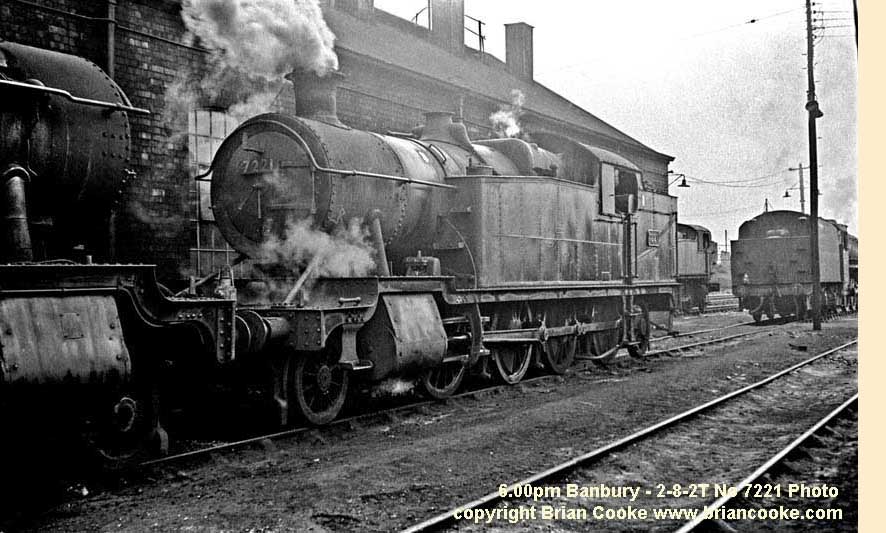 to Manchester and back? Oh, and as for the archive pictures you see of train spotters in their school blazers on the end of station platform? This had nothing to do with an allegiance to their school, it's because it was the only jacket they had! The Sixties was a very different world than it is today.
to Manchester and back? Oh, and as for the archive pictures you see of train spotters in their school blazers on the end of station platform? This had nothing to do with an allegiance to their school, it's because it was the only jacket they had! The Sixties was a very different world than it is today.
However, while train spotting may have left me with a number of old redundant books, with numbers underlined or not, and a box of black and white negatives, the one positive it gave me, which still remains, is a very good grasp of this country's geography. Okay, the whereabouts of Woodford Halse may not be that useful, but knowing the location of my many other train spotting destinations have been.
Scarborough, my home town station, was pretty quiet in the winter but as soon as Easter arrived the steam action would kick-off with regular excursion trains bringing holiday makers from exotic origins in the West 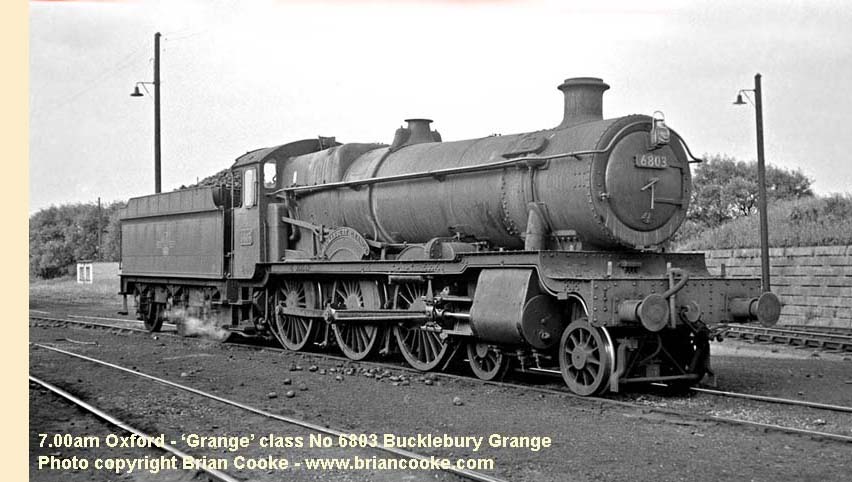 Riding of Yorkshire, such as Kippax. But never the passive observer, I soon hankered after a camera so that I could record what I quickly learned was soon to become the demise of steam power on British Railways.
Riding of Yorkshire, such as Kippax. But never the passive observer, I soon hankered after a camera so that I could record what I quickly learned was soon to become the demise of steam power on British Railways.
By 1964 I'd been interested in trains for over six years and I was now 17 but Sundays would still find me spending my ill-gotten gains aboard a chartered bus along with fellow members of the Scarborough Railway Society on trips to the West Riding of Yorkshire, the Durham Coalfield or shed bashes further afield. On one such occasion I was among the grown men and boys who took a train from Scarborough to Leeds in time for the reserved coach at midnight to Oxford. There the bash began. Oxford shed at 7.00am. Coach on to 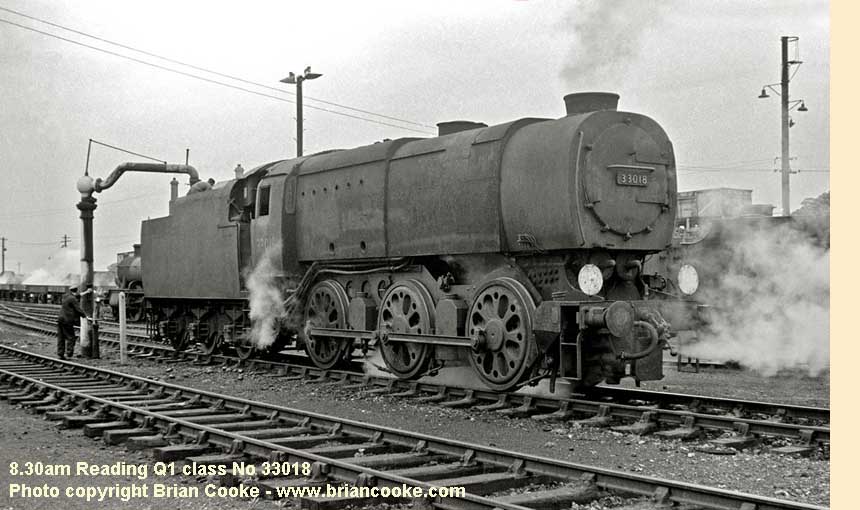 Reading. Reading shed at 8.30. Coach on to Basingstoke shed at 9.30 and then Eastleigh works at 11.00, rapidly followed by Eastleigh shed at 12.30pm. Coach to Swindon, its works for 2.00 and then shed, for 3.30. Coach on to Banbury in time for the shed at 6.00pm, then on to Woodford Halse and its immense but already declining shed, sited in what seemed the middle of nowhere. Then it was a coach back to Leeds in time for a train to York, which connected with the early morning mail train back to Scarborough.
Reading. Reading shed at 8.30. Coach on to Basingstoke shed at 9.30 and then Eastleigh works at 11.00, rapidly followed by Eastleigh shed at 12.30pm. Coach to Swindon, its works for 2.00 and then shed, for 3.30. Coach on to Banbury in time for the shed at 6.00pm, then on to Woodford Halse and its immense but already declining shed, sited in what seemed the middle of nowhere. Then it was a coach back to Leeds in time for a train to York, which connected with the early morning mail train back to Scarborough.
Imagine spending twenty four hours tramping through oil and ash, the intermittent eating of stale sandwiches washed down by minerals, uncomfortable seats and the invariable smell of vomit from the back 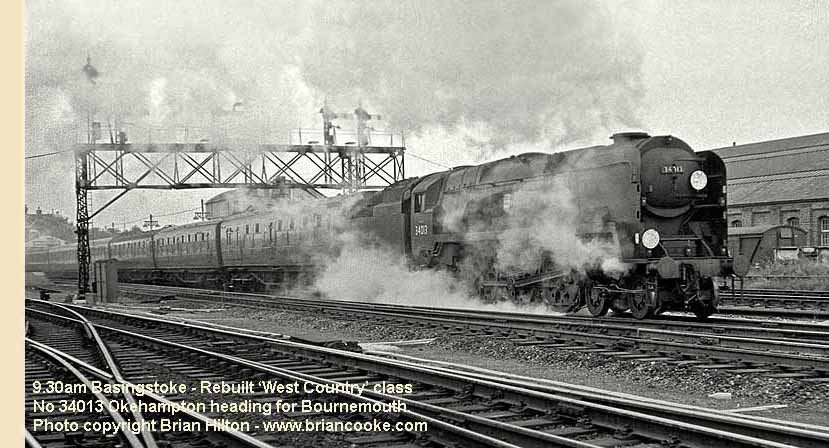 of the bus, these were the mechanics of the 'bash' - the objective of which on this particular occasion, the 21st June 1964, was amply fulfilled with 480 'cops' and 108 pictures.
of the bus, these were the mechanics of the 'bash' - the objective of which on this particular occasion, the 21st June 1964, was amply fulfilled with 480 'cops' and 108 pictures.
While the shed bash, especially on a Sunday, satisfied the insatiable appetite of my Ian Allan abc, it did nothing for photography as a creative medium, a concept which I was beginning to grasp at college. With reduced workings at weekends, all that was on offer was rows of cold dirty engines, languishing between piles of ash and the rubble of a decaying transport system. The three-quarter 'record' shot was just about all that was available unless you had a  unique creative eye, which only a few enlightened railway photographers had at the time, notably Collin Gifford. Unfortunately, I was still too young and inexperienced to realise that there were great images to be made, if only I could see them.
unique creative eye, which only a few enlightened railway photographers had at the time, notably Collin Gifford. Unfortunately, I was still too young and inexperienced to realise that there were great images to be made, if only I could see them.
While steam struggled on for a further four years, notably in the North West, it was becoming more and more difficult to find local working steam, which made for much more satisfying pictures. With a regular diet of surplus steam locomotives stored at the back of derelict sheds, or even worse languishing in various states of decay in a multitude of scrap yards across the country, I became disenchanted with recording the end of steam days and by 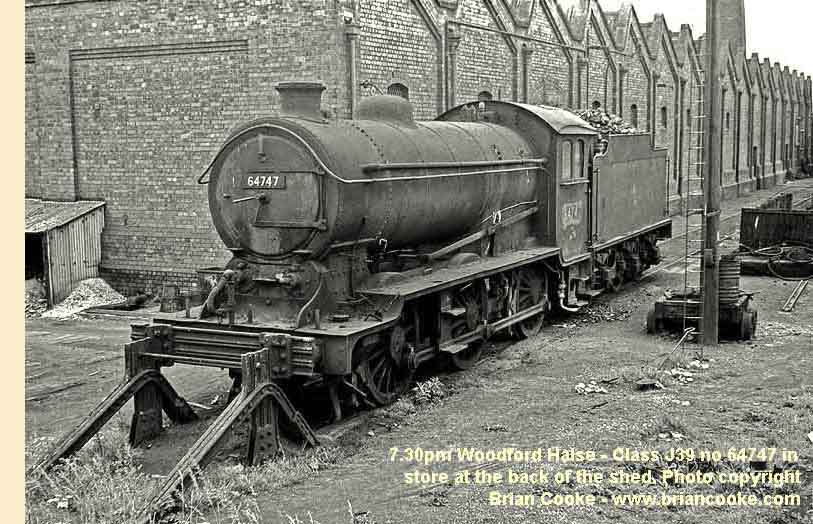 September of that year, my interest in photography was about to take a new turn. I decided to combine my love of photography and music and this led to an appointment as in-house photographer with Island Records' from 1971 to 1976...but that's another story.
September of that year, my interest in photography was about to take a new turn. I decided to combine my love of photography and music and this led to an appointment as in-house photographer with Island Records' from 1971 to 1976...but that's another story.
Brian's remarkable career as a photographer in the music industry can be found here…indeed if you're into the music of Mott The Hoople (Ian Hunter), Traffic (Steve Winwood), Vinegar Joe (Elkie Brooks & Robert Palmer), Fairport Convention and Roxy Music (Bryan Ferry)…plus a dozen more besides then Brian's website is right up your street.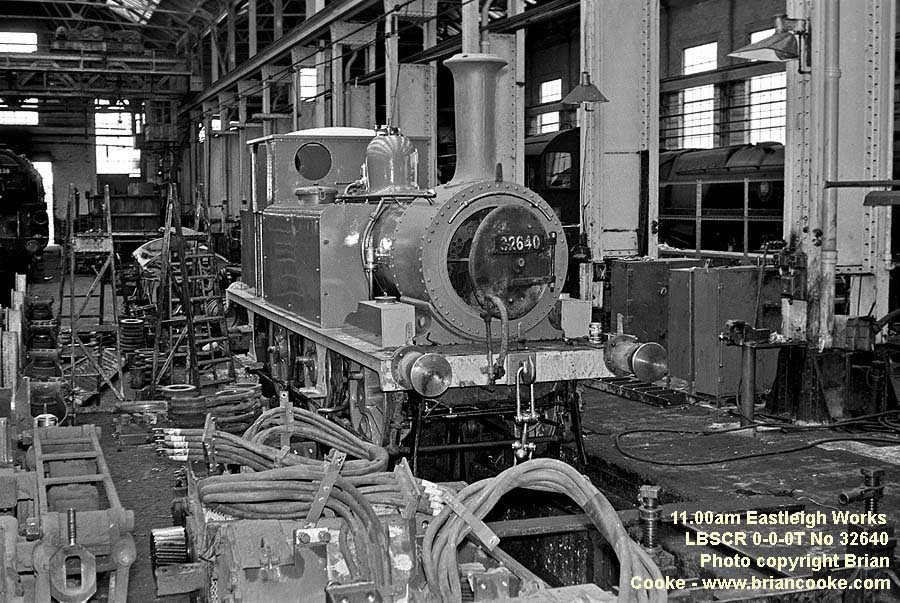
'SPOTTING MEMORIES 2'
by Barry Hilton.
It's not surprising that small boys developed an early interest in trains and railways, most youngsters did during the less-worldly Fifties. With the country still recovering from the burden of post-war austerities, the 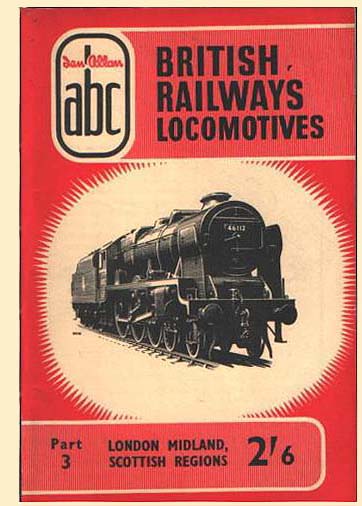
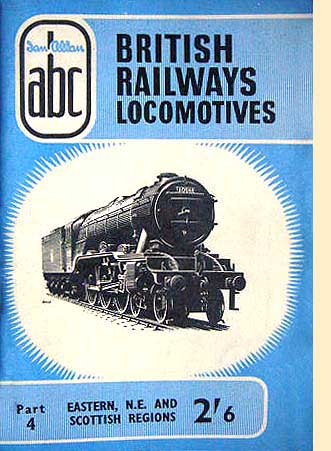 1950s was a decade of 'make do and mend' and children were expected to provide their own entertainment from the simplest of pursuits, which, for many cash-strapped families meant the cheaper the better.
1950s was a decade of 'make do and mend' and children were expected to provide their own entertainment from the simplest of pursuits, which, for many cash-strapped families meant the cheaper the better.
Indeed most families faced a constant uphill struggle to make ends meet, which probably explains why parents gave train spotting a universal thumbs' up, because all you needed to start collecting engine numbers was a notepad and pencil, which was cheap by anyone's standards!
Okay, perhaps there were a few additional costs, such as an Ian Allan abc Locospotters book (Summer 1957 editions illustrated here) which didn't come cheap. Costing half a crown (this equates to 12½p in today's money) it took a huge slice out of your hard-earned paper round money, but it was the only major expense you had to get started. Above all else, a 1d platform ticket gave small boys the chance to get up really close to the giants of steam at major railway stations, which at that age took some bottle! 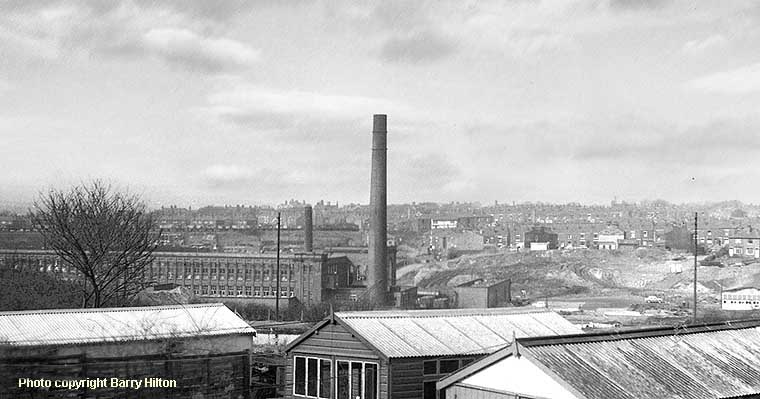
Born and raised in Rochdale Barry Hilton was luckier than most boys because he lived in a house with a long distance view from his bedroom window of trains crossing New Barn Lane bridge (above) and with a telescope it was possible to read the engine numbers, if clean! The line from Manchester served the closely-knit towns of East Lancashire, whereas through services via the Calder Valley connected to Bradford and Leeds in the West Riding of Yorkshire, all of which added to the variety of traffic. The through Trans-Pennine trains included freight and Inter-city expresses plus there was a regular service of steam-hauled local commuter trains, though by the start of 1962 summer timetable most local trains were operated by a new fleet of BRCW 3-car diesel multiple units...a sure sign of things to come! (Below) This close-up view of New Barn Lane Bridge shows Class B1 No 61010 Wildebeeste in 1963.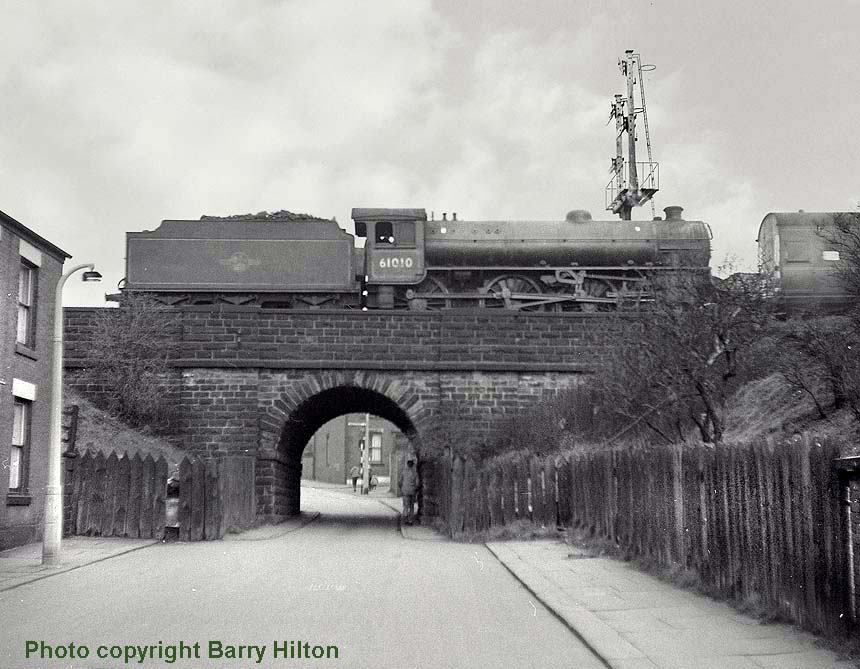
On Christmas Day in 1957, the Queen's Royal Christmas Message was broadcast on television for the first time. In those days television was still in its infancy and it wasn't until the early Sixties that it made a 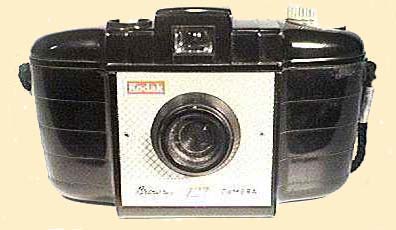
 significant impact on cinema audiences; the biggest film hit of the year was David Lean's Academy Award-winning 'Bridge on the River Kwai', and the Christmas No 1 hit in 1957 was Harry Belafonte's 'Mary's Boy Child'. That same Christmas, Barry became the grateful recipient of his first camera (a Brownie 127) and his lifelong interest in railway photography truly began.
significant impact on cinema audiences; the biggest film hit of the year was David Lean's Academy Award-winning 'Bridge on the River Kwai', and the Christmas No 1 hit in 1957 was Harry Belafonte's 'Mary's Boy Child'. That same Christmas, Barry became the grateful recipient of his first camera (a Brownie 127) and his lifelong interest in railway photography truly began.
Initially, his father took him to various mainline stations to see the big express passenger engines not seen at Rochdale, for example the mighty Stanier 'Duchess' Pacifics that worked the Manchester London Road to London Euston trains. He has a vivid memory of seeing his first Duchess - a shining ex-works 46254 City of Stoke on Trent in BR Green on the turntable at London Rd station.
Unfortunately he didn't capture the scene on camera but the memory of it remains crystal clear to this day. So too is his memory of receiving a Hornby Dublo 'Duchess of Montrose' boxed train set as a Christmas present. The 'three rail' track was promptly fastened to a large chipboard base, made up of an oval and one siding but later additions were made of extra track, accessories and engines as time went on. He remembers a Hornby Dublo N2 class tank 69567 being purchased in Bradford at Christmas 1958 for the princely sum of £2 10s. Other track and stock were added as funds allowed and he still has the engines and rolling stock to this day.
In 1957, Barry became a regular spotter around Rochdale and Manchester, his first regular vantage point being an area of common land next to the railway. From home he'd head across the valley, pass beneath New Barn Lane Bridge then turn left through a housing estate before reaching the 'common', an open area  of waste ground with adjacent garages. Several spotters congregated there, and during the quiet moments between trains they played makeshift games of football using coats for goal posts.
of waste ground with adjacent garages. Several spotters congregated there, and during the quiet moments between trains they played makeshift games of football using coats for goal posts.
The page link (above right) will take you Barry's 'Railways Around Rochdale' which features more shots of steam days in the area...click on image to visit the page.
This shot (above) shows Ivatt LMS Mogul No 46416 running tender first with a freight from Todmorden to Moston; this included express traffic to catch the 8.50pm Moston to Camden express goods. Before 1st January 1962 this train was worked by the loco off the 5.35pm Victoria-Todmorden stopper, usually a 6A, 6G or 6H working SX, but the SO turn was a Newton Heath or Willesden Black Five or Jubilee turn and the SX Rochdale-Moston ran independently.
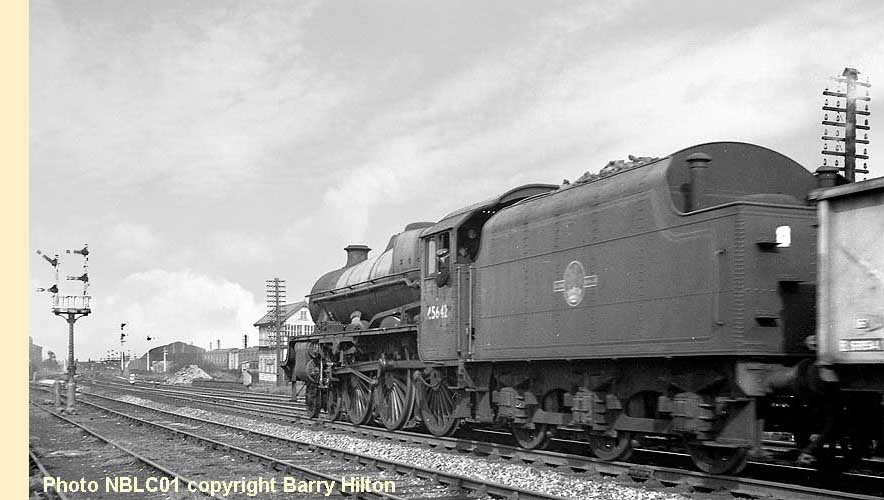 (Right) Jubilee Class No 45642 Boscawen is about to cross New Barn Lane Bridge with empty mineral wagons for Yorkshire.
(Right) Jubilee Class No 45642 Boscawen is about to cross New Barn Lane Bridge with empty mineral wagons for Yorkshire.
Today much of the common land is derelict, with tall bushes and trees obscuring the uninterrupted view he once enjoyed, and the railway is protected by miles of 'hideous' spiked aluminium fencing.
Indeed much has changed over the years, the Dunlop Cotton Mill has now gone; the building can be seen in this shot (below) ofFairburn 2-6-4T No 42132 heading bunker-first from Rochdale. At that time 42132 was a Southport engine (27C) and had probably worked a Southport-Rochdale service and is heading for the  Castleton triangle to turn prior to working the Rochdale-Southport return. The photo was taken from the Rochdale Canal towpath, now no longer possible due to redevelopment.
Castleton triangle to turn prior to working the Rochdale-Southport return. The photo was taken from the Rochdale Canal towpath, now no longer possible due to redevelopment.
(Below) The Dunlop Mill Weaving Shed was demolished on 20th December 2003 but the much later tall eggshell blue tower still remains. The Mill can be 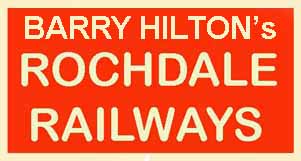 seen to the right in this shot of Class 4F No 43968 heading a train of empty wagons, which usually ran as a Class H, but in this case the headlamp arrangement is Class F (express freight unfitted). No 43968 was one of the Sowerby Bridge 4Fs seen from time to time on the 12.50pm Middleton Junction-Healey Mills empties. The surviving Arrow Mill chimney is just visible behind the tender. The lanes and open fields have now given way to a large Business Park.
seen to the right in this shot of Class 4F No 43968 heading a train of empty wagons, which usually ran as a Class H, but in this case the headlamp arrangement is Class F (express freight unfitted). No 43968 was one of the Sowerby Bridge 4Fs seen from time to time on the 12.50pm Middleton Junction-Healey Mills empties. The surviving Arrow Mill chimney is just visible behind the tender. The lanes and open fields have now given way to a large Business Park.
Barry's spotting memories continue on the next page...
Click here to visit Barry Hilton's 'Rail Cameraman' page 56 featuring more pictures of Rochdale's railways.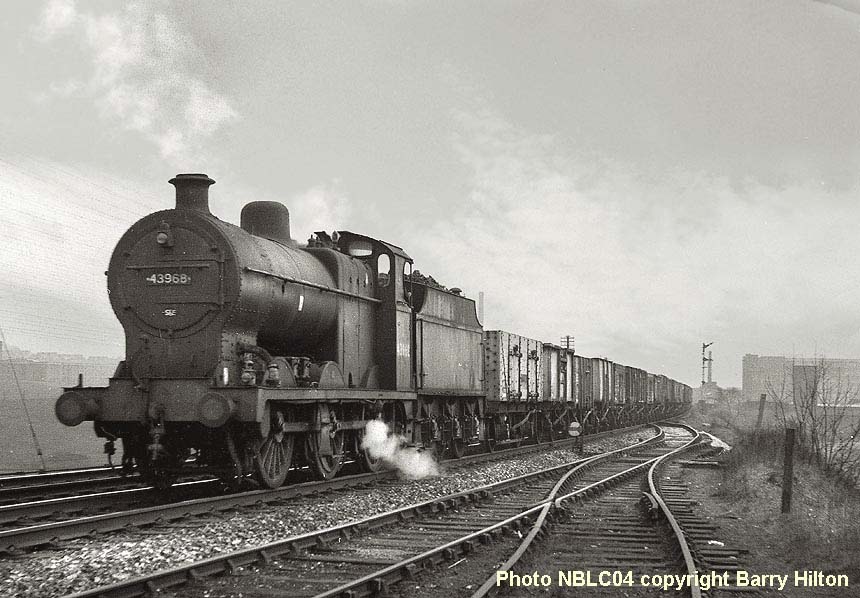
'SPOTTING MEMORIES 3'
Trevor Ermel's 'Spottings & Jottings' Page
As a small boy during the 1950s Trevor Ermel lived in Gateshead within sight and sound of the East Coast Main Line, but it wasn't until the end of 1963 that his interest in railways was fully roused. By then he was a 13 year-old pupil at Gateshead Grammar School for Boys and his favourite spotting haunt was by the 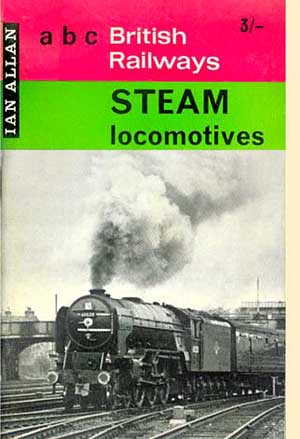 lineside at Low Fell - a ten-minute bicycle ride from home.
lineside at Low Fell - a ten-minute bicycle ride from home.
Once bitten by the 'spotting bug' Trevor chased steam throughout the 1960s and ended up visiting places the length and breadth of the country - from Aberdeen on the Scottish Region (ScR) to Weymouth on the Southern Region (SR) - all of which is recorded on his superb 'Spottings & Jottings' page here.
Trevor still has his original spotting notebooks, which, together with his evocative photographs, read as a diary of a bygone era and I am delighted that he has agreed to share it with others.
During Trevor's early spotting days his daily 'cops' were entered into a notebook carefully laid out with a different page for each class of loco. Occasionally an unfamiliar name was misread as the engine went by and several aberrations such as 'Trico' or 'Miniru' found their way into his collection. However, this 'do-it-yourself' style of record was abandoned by the summer of 1964 when he discovered the range of Ian Allan books which contained listings of loco numbers and names just waiting to be underlined, and he then began making notes by the lineside in a more conventional manner and updating the 'proper' book at home.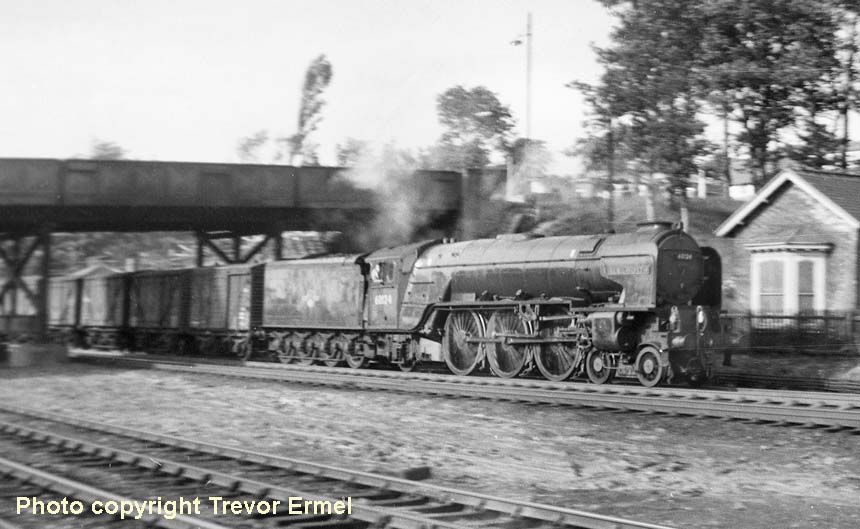
(Above) One of Trevor's first railway pictures was taken on the family 'Brownie 127' and shows A1 No 60124 Kenilworth speeding through Low Fell with a southbound freight. Although the picture is undated, judging 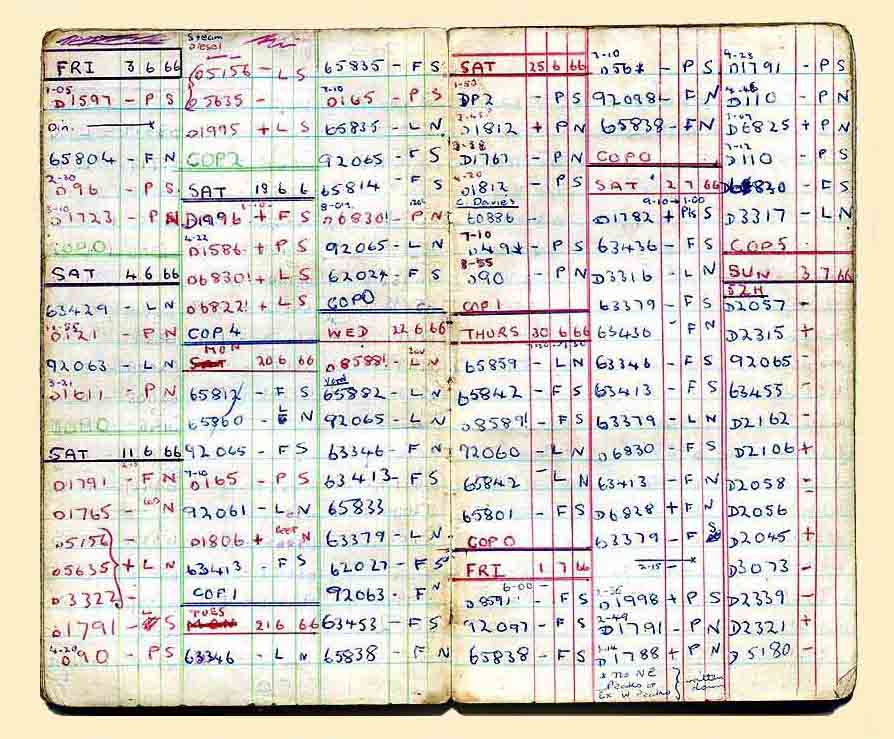 by 60124's immaculate condition it's safe to say that it was taken in May 1964 following overhaul at Darlington Works earlier that same month.
by 60124's immaculate condition it's safe to say that it was taken in May 1964 following overhaul at Darlington Works earlier that same month.
Fast-forward a couple of years and Trevor was recorded his visits to the lineside in a more meticulous fashion. His June 1966 visits to Low Fell can be found on his notebook pages (left) which reveal the Pacifics were conspicuous by their absence - the final one, No 60145, had been withdrawn that very month. His own 'last sighting' of an A1 had been on 25th February that year when No 60124 headed a northbound parcels train at Low Fell. Meanwhile most of the coal trains were still handled by the ageing J27s and Q6s, although Tyne Dock's 9Fs were also noted, plus the odd one or two K1s. On 25th June he noted the ill-fated DP2 diesel on a southbound express and later that day he recorded Class V2 No 60886 in Clayton & Davie's scrapyard.
Other 'last sightings' at Low Fell in 1966 included a 9F (No 92060 with an oil train) on 10th August and a V2 (No 60831 on a parcels train) on 26th August.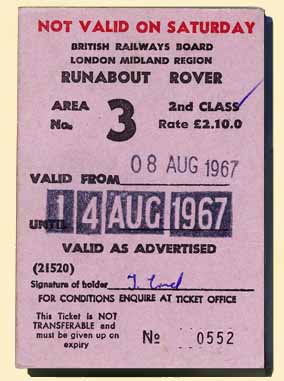 (Right) Keen to venture further afield, in addition to his spotting expeditions to the Southern and ScR Regions, Trevor spent many happy Saturdays visiting Carlisle to photograph the scheduled steam turns on seasonal passenger trains during the summer of 1967. Having just finished sitting O-level exams, the school summer holidays enabled him to take advantage of a week-long 'Runabout Rover' ticket covering the line between Carlisle and Preston.
(Right) Keen to venture further afield, in addition to his spotting expeditions to the Southern and ScR Regions, Trevor spent many happy Saturdays visiting Carlisle to photograph the scheduled steam turns on seasonal passenger trains during the summer of 1967. Having just finished sitting O-level exams, the school summer holidays enabled him to take advantage of a week-long 'Runabout Rover' ticket covering the line between Carlisle and Preston.
(Below) The climb to Shap summit was perhaps the most celebrated of all locations for seeing steam locomotives in action, certainly in their closing years, and it was a place he wanted to experience for himself. For many steam fans, northbound trains storming the formidable 1 in 75 gradient seemed to epitomise steam's final struggle against the odds, political as well as physical. His first visit was on 15th July, a summer Saturday, and the sun had come out that afternoon in time to see No 70029 (Shooting Star) with the 13.20 Euston to Glasgow express, rostered for a 'Britannia' non-stop from Crewe to Carlisle, tackling the climb past Shap Wells in fine style. He recalls the engine crew rather playing to the gallery of photographers, with the driver doffing his cap and taking a bow!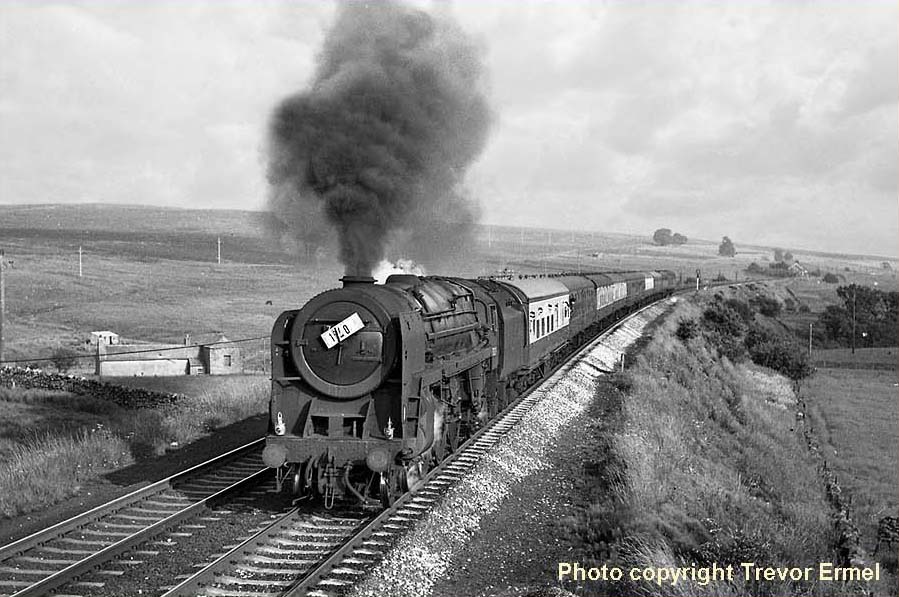
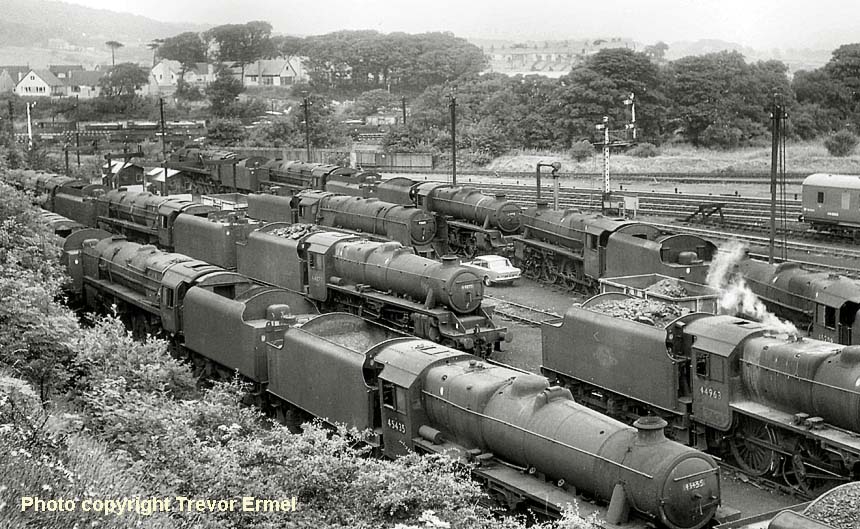
(Above) With so little time left before the August deadline, Trevor was able to witness the end of BR steam in the summer of 1968 at first hand, staying in the Youth Hostel at Arnside, near Carnforth, over two separate weeks in July and August.
Trevor writes - 'The final picture on the page perhaps fittingly shows rows of dead engines awaiting their  fate in the shed yard. No 44963 (bottom right of the photo) had just been driven into position and was left to cool down for the last time. Several tenders have already been emptied of coal which has been piled up in adjacent wagons. A sad end to an era I will always remember with affection - and I am so thankful I was able to see the last five years. Fortunately my parents never tried to discourage me, so long as it did not interfere with school work!
fate in the shed yard. No 44963 (bottom right of the photo) had just been driven into position and was left to cool down for the last time. Several tenders have already been emptied of coal which has been piled up in adjacent wagons. A sad end to an era I will always remember with affection - and I am so thankful I was able to see the last five years. Fortunately my parents never tried to discourage me, so long as it did not interfere with school work!
After August 1968 I lost interest, somewhat, in a railway without steam - after all, the new diesels would be with us forever, so why bother photographing them? Eventually it dawned on me that green diesels, which I remembered as an integral (if unwelcome) part of the steam era, were themselves an endangered species, and I began to take a belated interest again. I also started visiting new locations for photography as I still enjoyed travelling by train, whatever the motive power up front...'
Footnote: With a little arm-twisting I am delighted Trevor has agreed to compile a second page - 'Life After BR Steam' - currently in the very early stages but well worth a visit...click here
'SPOTTING MEMORIES - 4'
Jim Oakley's reminiscences...
Sixty eight year-old Jim Oakley recently discovered a bundle of fifty year-old Kodak Brownie 127 photos that he took during his spotting days from the late 1950s to the mid-Sixties. Jim is typical of the post-war 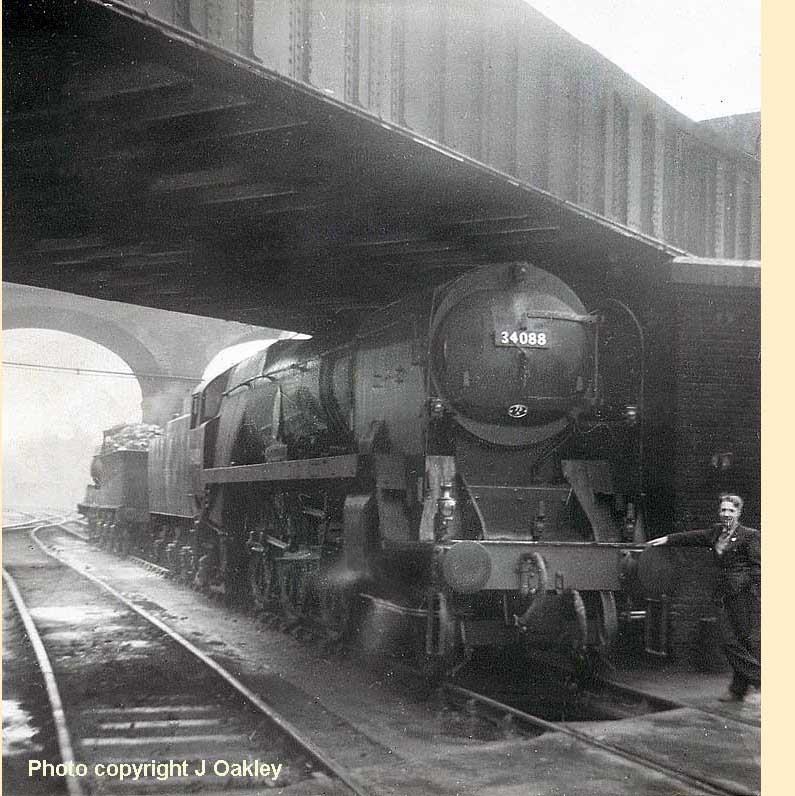 generation of youngsters who started collecting engine numbers during the less-worldly Fifties.
generation of youngsters who started collecting engine numbers during the less-worldly Fifties.
In those days, apart from climbing trees and fishing for sticklebacks in the local beck, there was little else to stimulate a boy's dare-devil sense of thrill-seeking - no 'flash-bang-wallop' computer games back then - so it's not surprising that train spotting became the national hobby for boys.
Indeed there is a common strand amongst ex-spotters who have now reached pensionable age; other than coping with ill-fitting dentures and unmanageable nostril hair, we long for something that we can feel cheerful about in old age, and so we console ourselves with memories of never-to-be-forgotten spotting trips all those years ago. 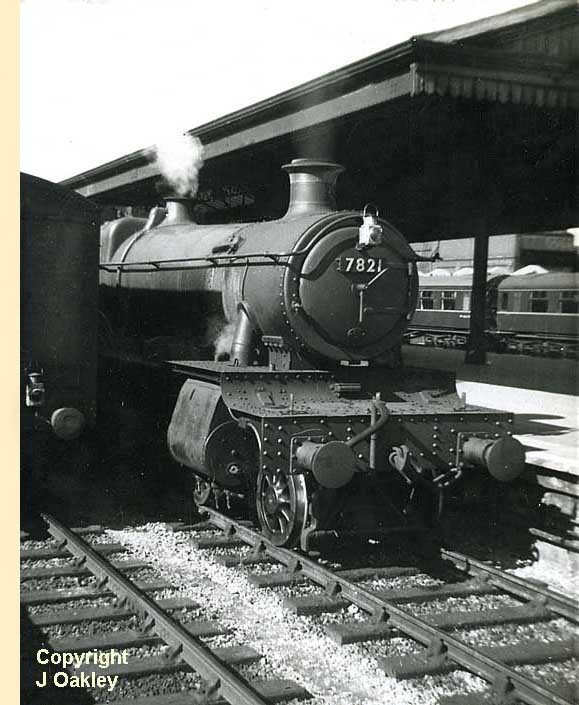 However these momentary trips down memory lane aren't due to a gratuitous need to romanticize childhood, it's because collecting engine numbers (the thrill of the chase) was an experience of a lifetime that gave us a glimpse into life's ups and downs at a very early age.
However these momentary trips down memory lane aren't due to a gratuitous need to romanticize childhood, it's because collecting engine numbers (the thrill of the chase) was an experience of a lifetime that gave us a glimpse into life's ups and downs at a very early age.
Indeed some hard-core members of the spotting fraternity had such high expectations of bagging their next 'cop' that they felt duty-bound to travel further afield in search of engine numbers, and this led to countless thousands of youngsters embarking upon some remarkable journeys of discovery, which, for many kids - some barely knee-high to a grasshopper - pushed health and safety to the limit. Not that they came to any harm. On the contrary, the hobby embraced every emotion between great joy and utter dejection, all of which has left retired old men with indelible memories of childhood.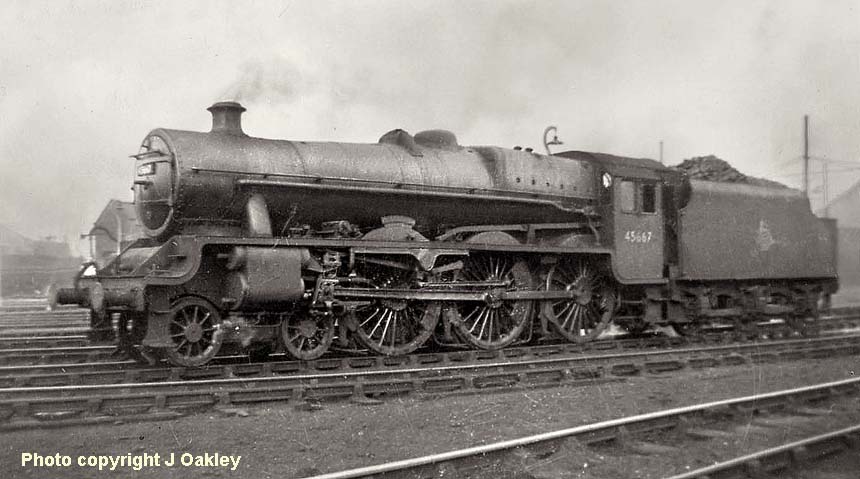
Jim Oakley was born and raised in Oldham, and began train spotting in the spring of 1958 when his friend, John Raynor, called round one Saturday dinner time and asked if he wanted to go spotting with him to Wigan...It was okay with mum, so off he went, little realizing what he was letting himself for. After catching a bus into Manchester and a train to Wigan Wallgate station, they found a spot on an embankment just a short distance from Wigan's North Western station which had a good view of trains on both the West Coast Main Line and the Manchester to Southport line coming out of Wigan Wallgate…with so much steam action going on, he was well and truly hooked!
Once bitten by the spotting bug, there was no turning back. By the end of the year he was regularly jotting down the numbers of 'Duchesses', 'Lizzies', 'Scots', 'Jubes', 'Brits' and 'Pats' on visits to the spotting Mecca at Crewe. Now you'd think a place like Crewe would satisfy the craving of the most ardent spotter, but in Jim's case even that was not enough. Eager to catch a glimpse of the Pacifics on the ECML he made his first foray across the Pennines into Eastern Region territory. Whilst catching a train from Leeds Central to Doncaster he 'copped' his first A4 'Streak' No 60033 Seagull…it was the start of a lifetime's love affair with the Eastern Region. From March 1959 he was a regular visitor to Doncaster, affectionately known as 'Donny', where he took several photos with his trusty Kodak Brownie 127, some of which appear on the Doncaster page 7...click here to visit the page.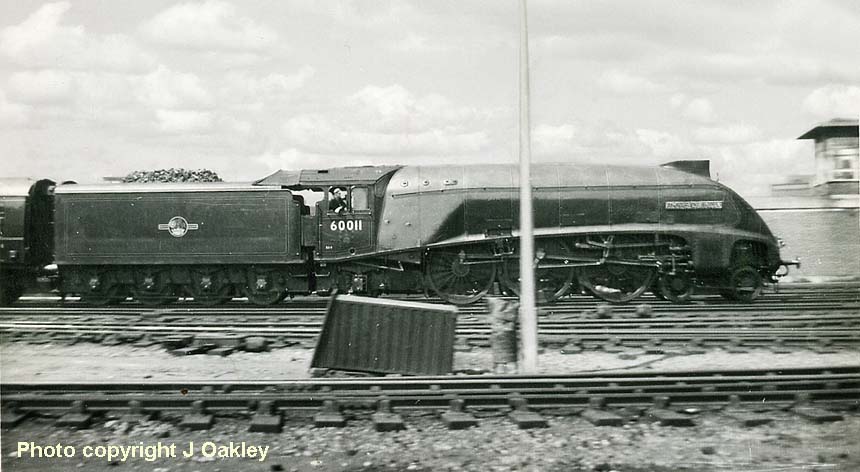
Harking back to the summer of 1959, Jim remembers a family holiday to his Aunt and Uncle's at Exmouth in Devon. It was a dream come true for him, though his excitement wasn't due to the fact that he was visiting the seaside; it was the chance to top up his paltry list of WR numbers (spotted at Crewe) and bag his first Southern Region engines. However, with post-war financial stringencies in mind the family had to travel by Yelloway Coach down to Devon since it was cheaper than train...no family car in those days!...but during the evenings he was allowed to catch a train from Exmouth to Exeter, where he spent several hours each day train spotting at both Central and St David's stations. Two years later, he was back with his spotting pal, Peter Jacques, for another week's stay. You can read Jim's spotting notebook on Page 22. here.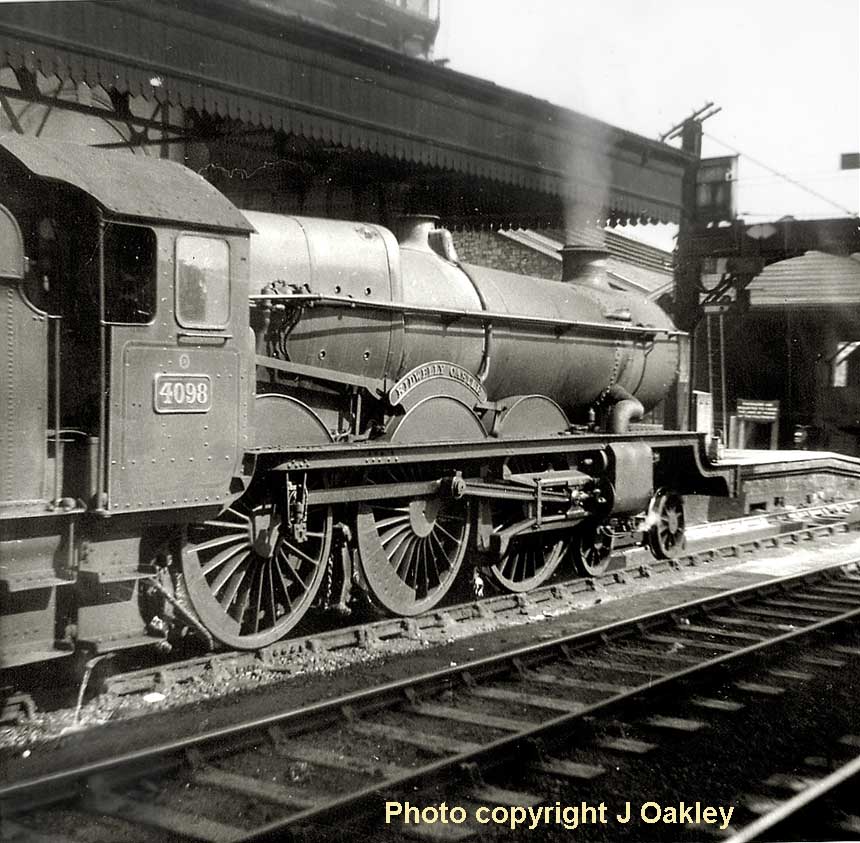
Prior to leaving Robin Hill Secondary Modern School in December 1959, fifteen year-old Jim became a member of the Northern Railfans Club which was organised by the enterprising Ray Hawley and Tom Smith based in Goostrey. The Club circulated a monthly newsletter with details of forthcoming visits to various engine sheds the length and breadth of the country, and during the next 3½ years Jim went on numerous trips to such places as - Jim's story is continued on the next page.... 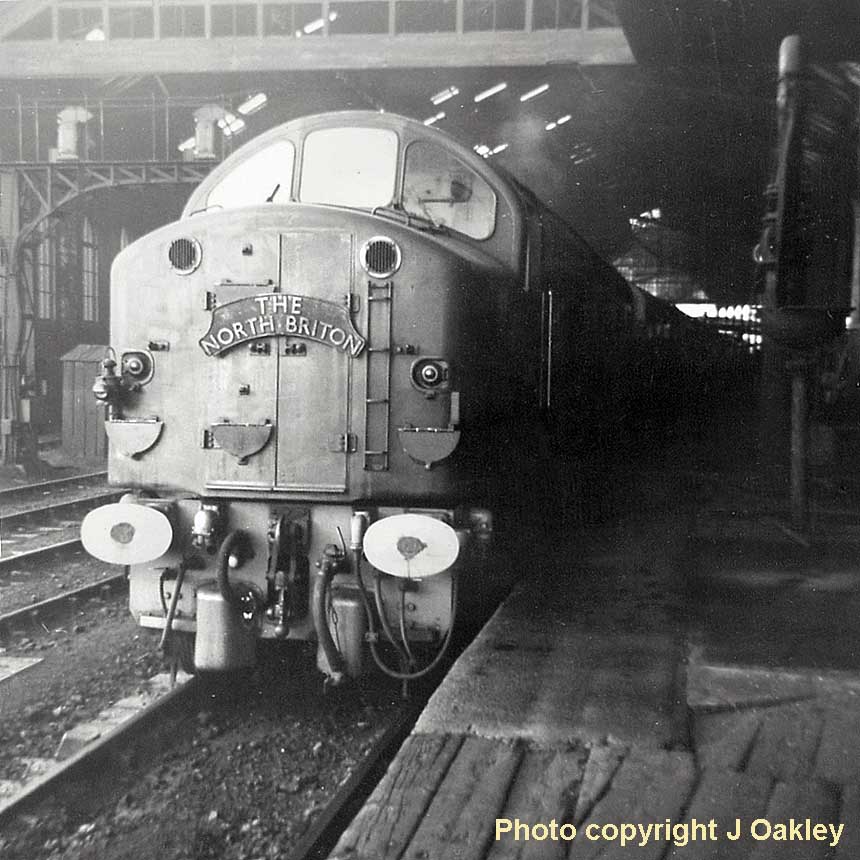
Footnote: If anyone has photos and similar spotting memories I will gladly post them on this page.

(Above-Below) This classic ER Morten shot of Norton Bridge station in August 1937 would make an ideal illustration for a model railway catalogue. The photo features a full set of station accessories...the platform seating, gas lamps, station running in board, barrow and crate, the porter and the quintessential train spotter. Norton Bridge railway station is located between Stafford and Crewe on the West Coast Main Line in Staffordshire. The main line platforms were removed prior to electrification during the 1960s, but the single island platform serving Manchester, via Stoke-on-Trent, remained in use until 2004. The photo was taken from the footbridge leading to the island platform but this was removed in order to improve clearances. (Below) They think it's all over...well it was then! A health & Safety executive's nightmare! The last BR steam-hauled passenger train headed by 'Britannia' Class 7MT 70013 Oliver Cromwell draws the crowds at Blackburn on 11th August 1968. It wasn't until 1973 that BR lifted its ban on steam specials
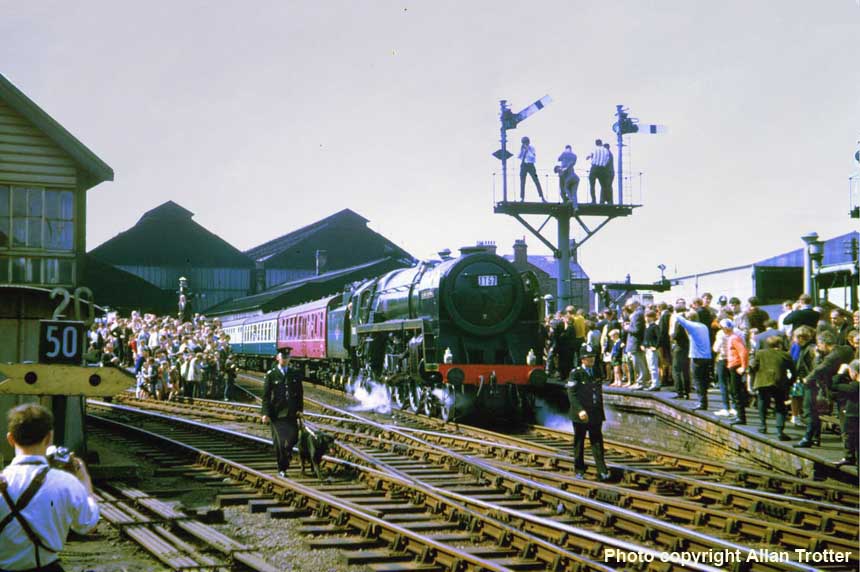
(Above-Below) A pair of spotters watch Riddles WD No 90678 heading an eastbound freight through Diggle on 12th April 1952. Fast-forward 50-odd years and preserved 'Princess Royal' class No 6201 Princess Elizabeth gets to grips with wet rails on the climb to Standedge Tunnel at the head of the Railway Touring Co's 'Scarborough Flyer' on 20th August 2010. Today the importance of Diggle as a railway centre is scarcely apparent. After the station closed in October 1968, much of the track layout passed into history and the abandoned trackbed is gradually vanishing in the undergrowth, however one item of past-present identification is common in both photos - the old-red telephone box which seems to have stood the test of time very well!
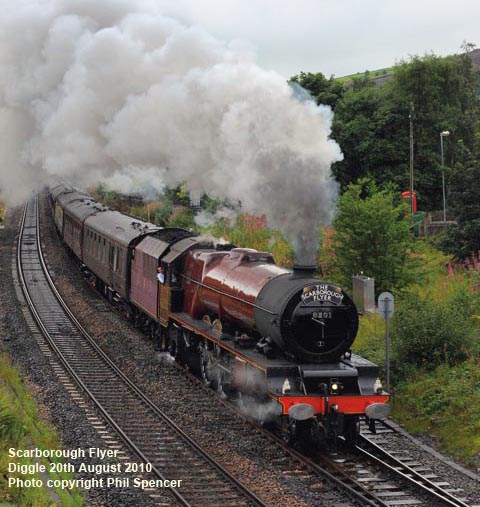
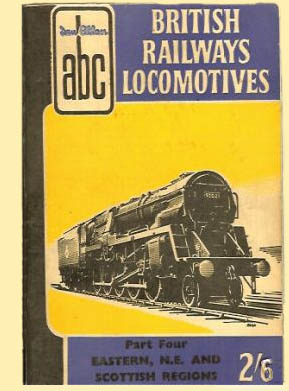 (Above-Below Left) Roy Lambeth's first camera was an Ilford Sporty 4, the same model as his unnamed spotting chum (above). This basic camera was equivalent to the Kodak Brownie but used 120 roll film that gave 12x2.25insx2.25ins prints and was just a little more up market than the Brownie. The Ilford Sporty 4 had a fixed 1/50sec shutter speed and a choice of sunny or cloudy aperture settings. However, during the late Fifties, tens of thousands of schoolboys began photographing steam trains using the simplest Kodak Brownie 127 camera. Introduced in 1952, it was the first affordable camera on the market, costing £1/4s/6d - £I.22½p in today's money. The camera had a single element lens and fixed shutter speed of 1/25 sec, which was totally inadequate for taking photographs of moving trains. Still it required no adjustments except for pressing the shutter and winding on the film, enabling thousands of young spotters to get started in railway photography. The camera took 8 pictures on 127 roll film - the yellow backing paper was a bit finicky when loading - but it was a robust model with a bakelite body and a face plate ornamented with a diamond pattern. The Brownie 127 remained a firm favourite with spotters until the launch of the Instamatic cartridge camera in 1963.
(Above-Below Left) Roy Lambeth's first camera was an Ilford Sporty 4, the same model as his unnamed spotting chum (above). This basic camera was equivalent to the Kodak Brownie but used 120 roll film that gave 12x2.25insx2.25ins prints and was just a little more up market than the Brownie. The Ilford Sporty 4 had a fixed 1/50sec shutter speed and a choice of sunny or cloudy aperture settings. However, during the late Fifties, tens of thousands of schoolboys began photographing steam trains using the simplest Kodak Brownie 127 camera. Introduced in 1952, it was the first affordable camera on the market, costing £1/4s/6d - £I.22½p in today's money. The camera had a single element lens and fixed shutter speed of 1/25 sec, which was totally inadequate for taking photographs of moving trains. Still it required no adjustments except for pressing the shutter and winding on the film, enabling thousands of young spotters to get started in railway photography. The camera took 8 pictures on 127 roll film - the yellow backing paper was a bit finicky when loading - but it was a robust model with a bakelite body and a face plate ornamented with a diamond pattern. The Brownie 127 remained a firm favourite with spotters until the launch of the Instamatic cartridge camera in 1963.
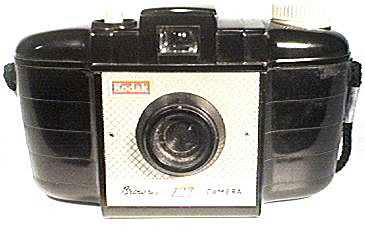 | 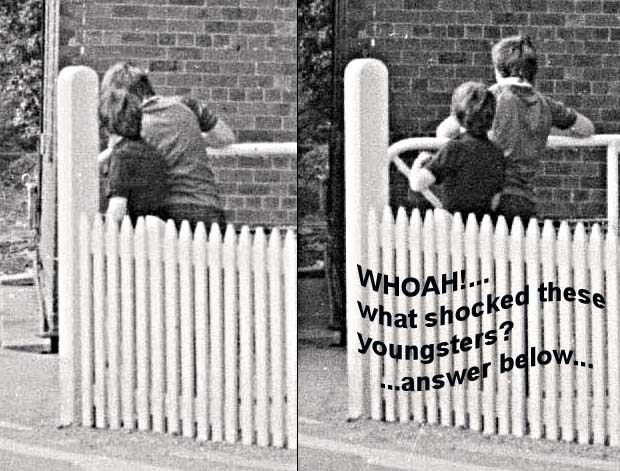 |
The reason train spotting become so popular with small boys in the Fifties is becauses a steam train is hugely watchable - a 'sight for sore eyes' - as we say in Yorkshire. At the same time, wartime measures were still very much in evidence during the 1950s, and most High Street shops were selling utility products made from strictly controlled Government allocations. The end of the 'points' rationing system, some 14 years after its introduction was a portent of better things to come, but with the absence of anything much to buy in toy shops, many youngsters were taught how to create the simple pleasures from their own imaginations. For instance, pulling an empty cardboard box by a piece of string was not, in our minds, playing. We were in charge of a bus, or driving a steam engine. Then, as we grew older, we had spinning tops, kites, skipping ropes and Meccano bits 'n' pieces. It was a world long before the silicone chip, mobile phones and the Internet, so we knew nothing else. Indeed, my earliest memory is watching the stately procession of steam trains on my local line between Leeds and Harrogate. The sight and sound of a hard-working steam locomotive evoked such an extraordinary sense of being in the company of something great and dignified that, after it had gone, I could barely wait until the next one came along. 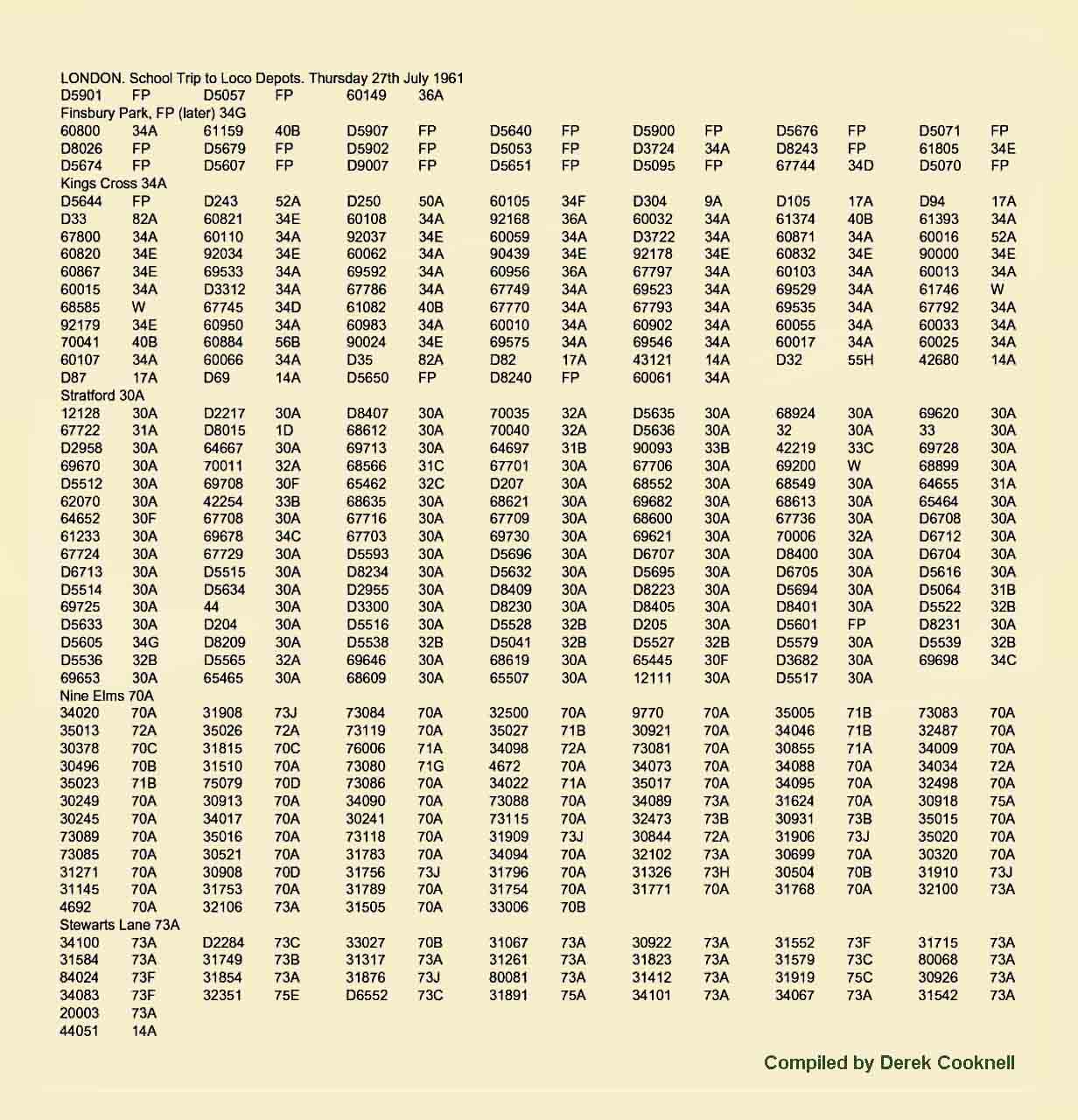
(Above) Derek Cooknell recently contacted the site with a log of all the locomotives he spotted at five principal London Loco Depots on Thursday 27th July 1961. The occasion was a trip organised by his school, the Leamington College for Boys, Railway Society. Derek was then 12 years old and being from the West Midlands, had never seen steam locos starting with the numbers '3' or '6' before... He writes - 'It was all very exciting! The numbers shown are taken from my old notebook, which is now falling apart, so I decided to transfer the contents to my computer and record it in a digital format. I've also added the shed code of each loco, working from an Ian Allan 1961 ABC locoshed book…' Click on page image to enlarge.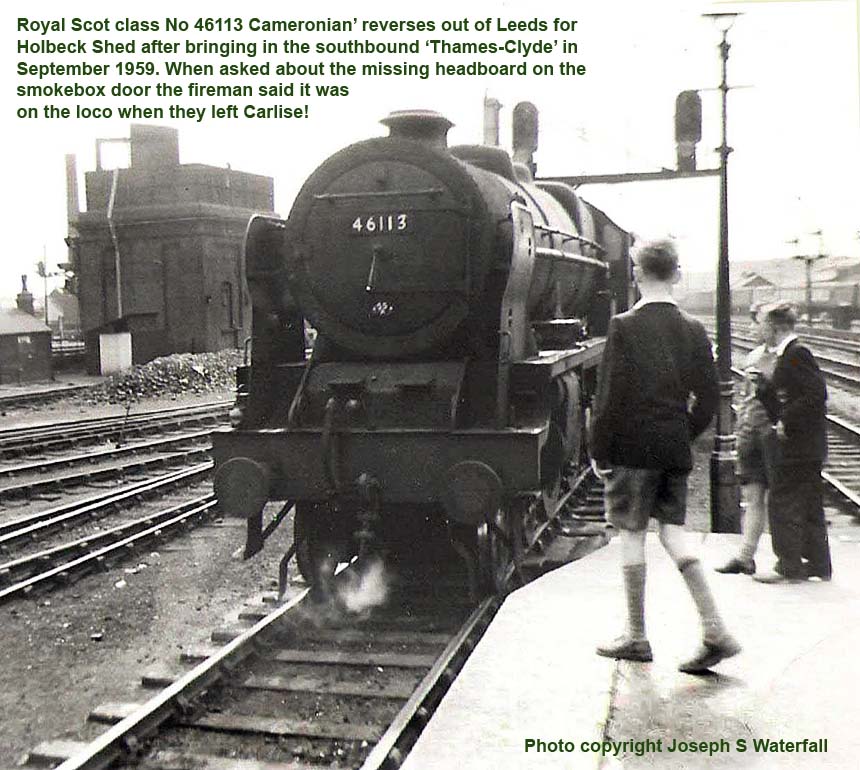
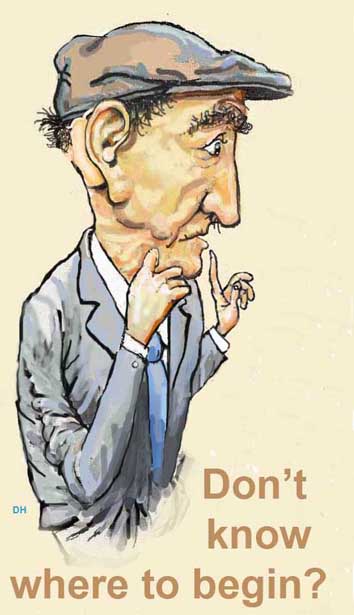 (Below) A warm welcome to the growing band of 'Silver Surfers'. When I began surfing the Internet I found the 'drag and click mouse' jargon a bit baffling at first, but once I got going it was great to log on and search through the thousands of railway sites. The trouble is surfing the 'communications super highway' is a daunting task unless you know what you're doing. Over the years, the World Wide Web has become a victim of its own success, and the information overload - the sheer volume of material it contains - can take a lot of digesting, and so I hope the simplest of tips (below) will help the first time visitor to 'Youtube'.
(Below) A warm welcome to the growing band of 'Silver Surfers'. When I began surfing the Internet I found the 'drag and click mouse' jargon a bit baffling at first, but once I got going it was great to log on and search through the thousands of railway sites. The trouble is surfing the 'communications super highway' is a daunting task unless you know what you're doing. Over the years, the World Wide Web has become a victim of its own success, and the information overload - the sheer volume of material it contains - can take a lot of digesting, and so I hope the simplest of tips (below) will help the first time visitor to 'Youtube'.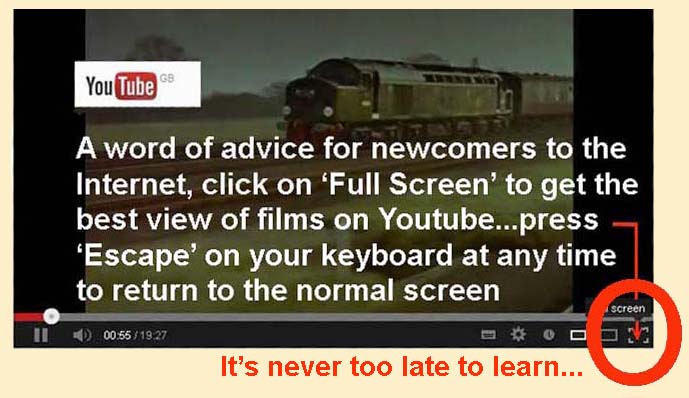
If a publisher was seeking a sure fire winner to add to their list of new titles then they need look no further 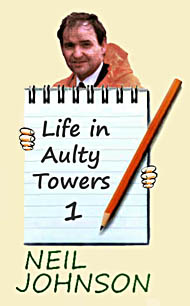 than former Railway Press & PR Officer Neil Johnson's anecdotes about the railway industry. Here Neil regales us with a story of his start in the rail industry...
than former Railway Press & PR Officer Neil Johnson's anecdotes about the railway industry. Here Neil regales us with a story of his start in the rail industry...
LIFE AT AULTY TOWERS
by Neil Johnson
Despite an almost boyhood obsession with trains and railways in general, the one career I had never really considered was one in the rail industry. Both during my boyhood in the North East and my adolescence in Derbyshire I had witnessed enough dirty, grimy railway premises to steer me far away from anywhere where rails ran.
My introduction to a working life after forsaking full time college was initially as an office boy, then an advertising assistant on a County type magazine; the sort that always populate the scratched tables in doctors waiting rooms. After this heady introduction to commerce and Industry, I spent three months as an assistant plant manager moving bulldozers and cranes from one building site to another across the East Midlands and despite a few hiccups managed to direct most things to where they were actually needed.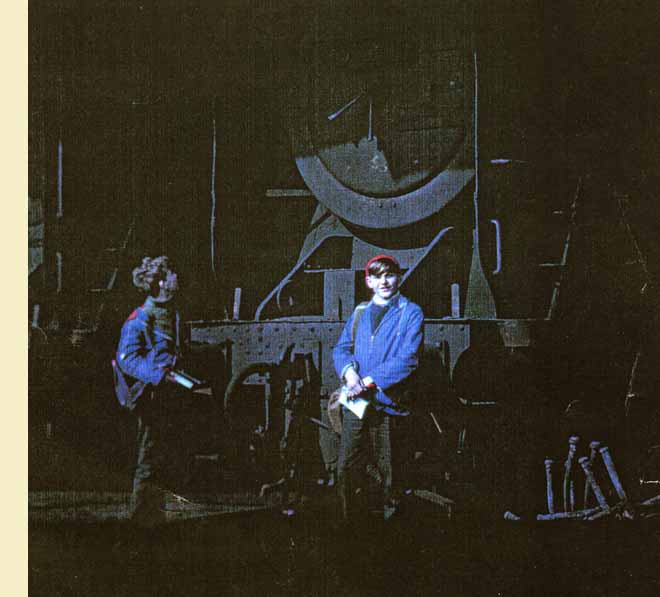 (Right-Left) Old spotting days...Mick Mosley and Neil Johnson pose in front of 70000 Britannia at Crewe South shed in the late spring of 1965; photograph by Mick Horobin. (Below Left) The picture of Neil in the cab of an Austerity 0-6-0 cab was taken at Backworth in South East Northumberland in 1968 by Peter Coombs, a model engineer of some note, now living in Lincs. Neil and Peter have remained chums since childhood. Backworth NCB became a mecca for steam devotees after the demise of steam in 1968. It was less than 3 miles from Neil's home as a boy. Even in their early teens both Neil and Mick realized they were witnessing the end of a period of history. Mick's mother hailed from the same area where Neil had grown up, and urged both boys to find careers on the rails which they ultimately did. She had immense pride in the legacy left by fellow Northumbrian, George Stephenson, whose impact on railways around the world is renowned, but by the 1960s the railways in Britain were by and large undervalued. In 1957 when Neil's family returned to the North
(Right-Left) Old spotting days...Mick Mosley and Neil Johnson pose in front of 70000 Britannia at Crewe South shed in the late spring of 1965; photograph by Mick Horobin. (Below Left) The picture of Neil in the cab of an Austerity 0-6-0 cab was taken at Backworth in South East Northumberland in 1968 by Peter Coombs, a model engineer of some note, now living in Lincs. Neil and Peter have remained chums since childhood. Backworth NCB became a mecca for steam devotees after the demise of steam in 1968. It was less than 3 miles from Neil's home as a boy. Even in their early teens both Neil and Mick realized they were witnessing the end of a period of history. Mick's mother hailed from the same area where Neil had grown up, and urged both boys to find careers on the rails which they ultimately did. She had immense pride in the legacy left by fellow Northumbrian, George Stephenson, whose impact on railways around the world is renowned, but by the 1960s the railways in Britain were by and large undervalued. In 1957 when Neil's family returned to the North  East from East Anglia one of the houses his parents considered buying was George Stephenson's former cottage in Killingworth. His Dad dismissed the possible purchase due to its small size and cramped conditions - these days it is a museum. Mick became a traction engineer and trouble shooter within the rail industry; he retired in Aug 2014 from BRUSH. A rail related piece penned by Mick appears on the Chaddesden Historical Group's website HERE.
East from East Anglia one of the houses his parents considered buying was George Stephenson's former cottage in Killingworth. His Dad dismissed the possible purchase due to its small size and cramped conditions - these days it is a museum. Mick became a traction engineer and trouble shooter within the rail industry; he retired in Aug 2014 from BRUSH. A rail related piece penned by Mick appears on the Chaddesden Historical Group's website HERE.
In truth, at eighteen I was far more interested in my life outside work and came to realise that whilst most of my pals had embarked upon real careers and were two or three years down the road in technical or craft apprenticeships, by contrast, I was floundering a bit without any real direction. The mother of one of my best pals who worked at Derby Loco Works was amazed that I had not considered employment in what was arguably Derby's biggest industry, particularly in light of my obvious interest. Like myself she had spent many of her early years in a Northumbrian village and thought I should have followed in our local hero George Stephenson's footsteps and made Derbyshire both my home and occupational direction with the Iron Horse; 'Our Mike loves it at the Railway' she said, 'I'm sure you would too…'
So as I approached my nineteenth year, I penned a letter to the newly-built Rail Technical Centre (RTC) on the London Road, as well as a number of other local concerns. I also contacted Derby's youth employment office, although technically I was too old; a kindly lady from Gateshead took pity on me and arranged a number of interviews including one at Derby Midland Booking Office. To me it seemed strange to think that I might end up working where I had spent many hours train spotting when I first came to the fair County of the Ram.
Before I could consider a life in the land of tickets however, I received a reply from the Headquarters Accountant of The British Railways Board based in London Road's new Palace, inviting me to attend an interview and to bring along my paltry collection of educational certificates and proof of birth.
After a brief chat with the heavily brylcreemed Manager with a strong East Anglian drawl, I was given a brief tour of a large L-shaped office where most people appeared to be either eating or drinking, including a small Latin guy wielding an electric frying pan.
In the corner of the room was a large plastic tub full of dark brown liquid which smelt suspiciously like home brew. Hanging over a desk, a petite pretty blonde in a mini skirt was presenting the most wonderful view - 'We moved the office up from London last year,' said the turnip tugger - 'I think you'll like it here'. As I cast a backward glance upon leaving the room to check the exact length of the mini skirt; the small dark haired chap was now smiling widely and began cramming bread into a toaster with one hand and with the other holding up a glass of amber liquid in my honour by way of a toast.
As I cast a backward glance upon leaving the room to check the exact length of the mini skirt; the small dark haired chap was now smiling widely and began cramming bread into a toaster with one hand and with the other holding up a glass of amber liquid in my honour by way of a toast.
'I'm darn sure I will!' was my only thought.
To this day I'm certain that the only reason I got the job was because my birth certificate when checked, showed the same locality as the Tractor Boy Manager's origins; this made it twice within a fortnight that my past geographical addresses had aided my quest for gainful employment. Would a few years of a Spondon senior school education and a Chadd address catapult me towards Corporate Glory, I wondered?
Three cartoons by Graphic Artist, Ken Stevens, relate to the quirks that Neil possessed; Ken was one of the most gifted commercial artists he ever worked with. On the eve of Neil's departure from BREL PR & Publicity  and transfer to the Research department, Ken sketched out a spoof Info sheet of the type Neil would have to compile as the R&D's new Publications Manager. Every eccentricity was neatly encapsulated in print; the Yugoslav cap purchased in Zagreb on a 'Boys Own outing', the NUFC shirt, the tuneless whistle when concentrating, the red Indian chant on screen which arose during great periods of achievement…and the aftershave bottle he dabbed his forehead with when the going got tough! The front cover drawn in the exact style of the R&D's tech info sheets of the time accurately portrays the .entrance to Kelvin House HQ at the RTC - with Neil's well known clumsiness featured as he catapulted out a window!
and transfer to the Research department, Ken sketched out a spoof Info sheet of the type Neil would have to compile as the R&D's new Publications Manager. Every eccentricity was neatly encapsulated in print; the Yugoslav cap purchased in Zagreb on a 'Boys Own outing', the NUFC shirt, the tuneless whistle when concentrating, the red Indian chant on screen which arose during great periods of achievement…and the aftershave bottle he dabbed his forehead with when the going got tough! The front cover drawn in the exact style of the R&D's tech info sheets of the time accurately portrays the .entrance to Kelvin House HQ at the RTC - with Neil's well known clumsiness featured as he catapulted out a window!
I was even admitted at the dizzy level of clerical officer and not just a clerical assistant due to my mere handful of GCSEs - and more importantly after a short period would receive the benefits of free rail travel,  thereby enabling me to follow and indulge my dual passions of steam trains and sport in the shape of Derbyshire Cricket club and Newcastle United FC. In retrospect it seems somewhat ironic that I should end up in the rail industry at all, particularly considering my earlier aversion to railway buildings and also in light of the fact that figures were not my strong point, other than gazing wistfully at those of the type presented so pertly by the blonde in the L-shaped office. 'Well, this will do for a few months or so I thought'.
thereby enabling me to follow and indulge my dual passions of steam trains and sport in the shape of Derbyshire Cricket club and Newcastle United FC. In retrospect it seems somewhat ironic that I should end up in the rail industry at all, particularly considering my earlier aversion to railway buildings and also in light of the fact that figures were not my strong point, other than gazing wistfully at those of the type presented so pertly by the blonde in the L-shaped office. 'Well, this will do for a few months or so I thought'.
Twenty six years later and I was still there, albeit in a slightly different location and with a different type of occupation to number crunching.
For the first few years, I spent time mainly as a relief clerk in the various financial areas - this was due to having great versatility or maybe it was because nobody wanted to hang on to you for too long! Occasionally I got an odd trip to London or Crewe to cover a shift, this for me broke the sheer monotony of accountancy which had no great appeal, although I have to say the BR Accountants I worked with were the most lively fun-loving bunch of people I ever came across; drawn from all over the British Isles with a healthy balance of solid Derbyshire folk it was indeed a very happy place to work and play; both of which they did with great and equal gusto. This was followed by a step up and an early stab at keeping computerized records of rolling stock, back in the days when computers were still the size of double decker buses. This I thought was marginally better than dealing with just columns of figures until an older colleague (an ex- Nottingham steam loco driver) pointed out that it was just as boring - 'It's just more numbers youth' he said, 'You don't even get to add the boggers up'.
Eventually as I reached my mid-twenties I made the great escape into a totally different type of career but still within the Industry and among its people which I loved. Bernard Ault was then the Public Relations & Publicity Officer for British Rail Engineering and my first impression when interviewed was that I had encountered a man with a lively mind and an equally lively sense of humour. My initial assessment was not wrong, as future years were to prove. Over a decade later when I asked why I had been the most successful candidate that day and what had tipped the balance, he replied. 'You lied beautifully. You really had me believing you were competent!'
Since that day in 1978 I worked for Bernard on two further occasions, so I guess my porkies must have had long lasting credibility!
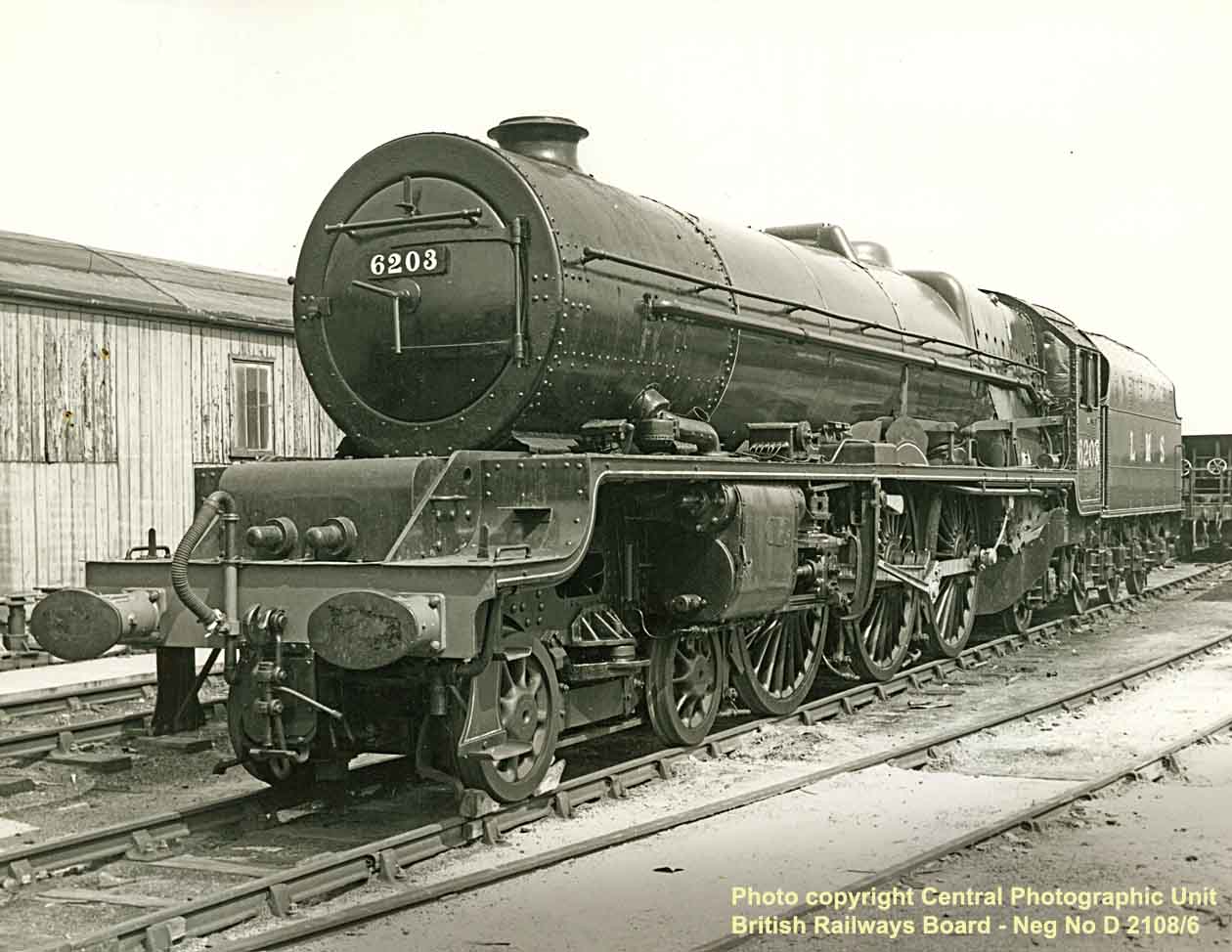
(Above-Below)his shot of the now-preserved LMS 'Princess Royal' class locomotive 6203 Princess Margaret Rose was taken by one of BRB's professional photographers when the loco was being transferred over BR metals. The Public Relations & Publicity Department of BR worked closely with the industry's professional photographers; an oft heard phrase in the PR offices when awaiting press material was - 'One day my prints will come!' (Below) The shot features Neil whilst he was seconded back to BREL's PR Department covering the launch of the push-pull stock on Scotland's new Glasgow-Edinburgh service in the early 1980s. Scotland's railways went under a progressive transformation during this period under the guidance of the mercurial and now-famed rail manager, Chris Green. The Production and Project manager in the picture is explaining the technical details to a young and enthralled-looking Neil at the Springburn Works.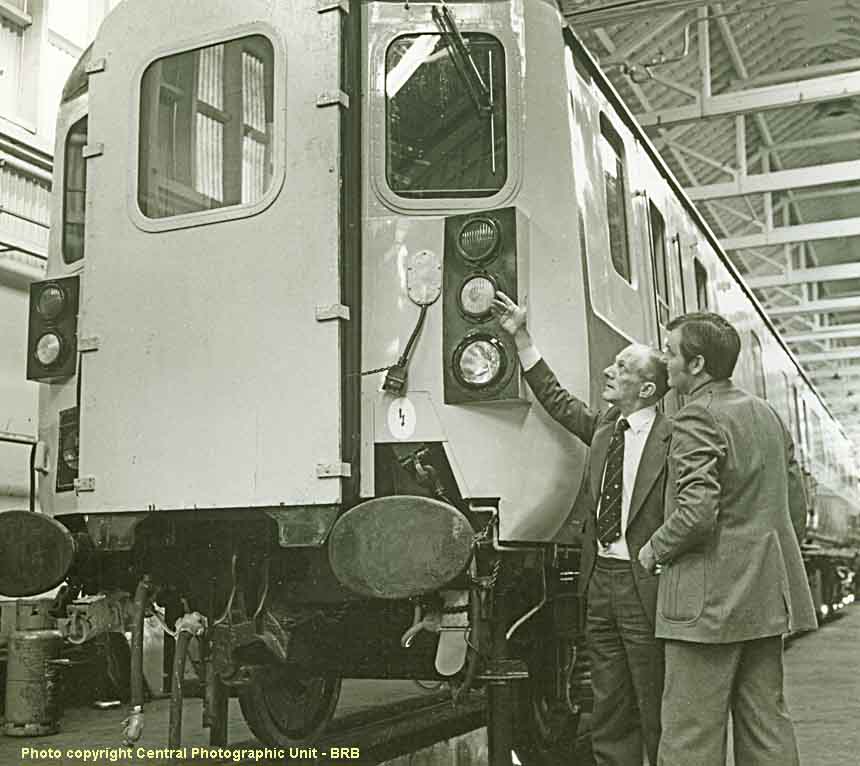
(Below) I love this Mike Mitchell photo... you can almost hear the roar of Class V2 No 60946 heading a Liverpool-Newcastle train near Rigton Box on the Leeds-Harrogate line in December 1959.
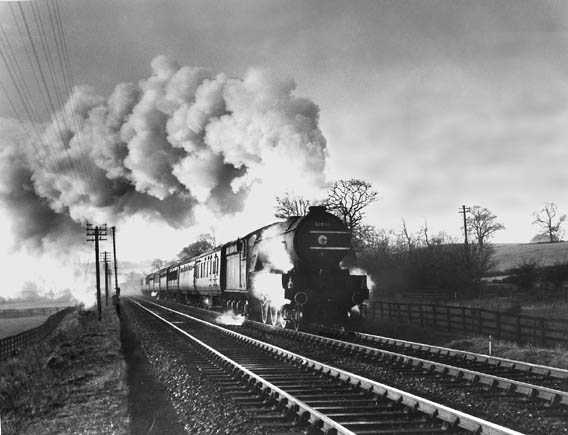
And the smell? - a heady mixture of steam, coal, steam and hot oil which somehow touched all senses, except for touch itself, but even that was imperceptible; a steam locomotive has such profound character that it is impossible not be affected by its presence. Even so, it would take a child with a rhinoceros hide to overcome their fear of steam. How often have we seen a terrified toddler being dragged, kicking and screaming, because their father wants to cajole his offspring to take a closer look at the 'big' engine simmering away at the end of a station platform? It may well be a ruse by doting dads to indoctrinate their child into the spotting brotherhood, but in the eyes of a small boy, a steam locomotive is an awesome animal at close quarters, and no amount of unconditional bribery can dissuade them that it isn't.
(Below) In this photo © Frank Ashley you can almost hear this terrified toddler kicking and screaming as a doting dad tries to cajole his offspring into taking a closer look at Stanier Pacific No 46250 City of Lichfield simmering away at the end of the platform at Carlisle in May 1952. It may well be a ruse to indoctrinate a child into the spotting fraternity, but a steam locomotive is an awesome animal at close quarters, and no amount of unconditional bribery can dissuade them that it isn't...
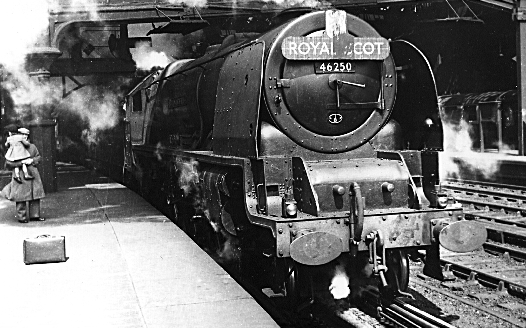
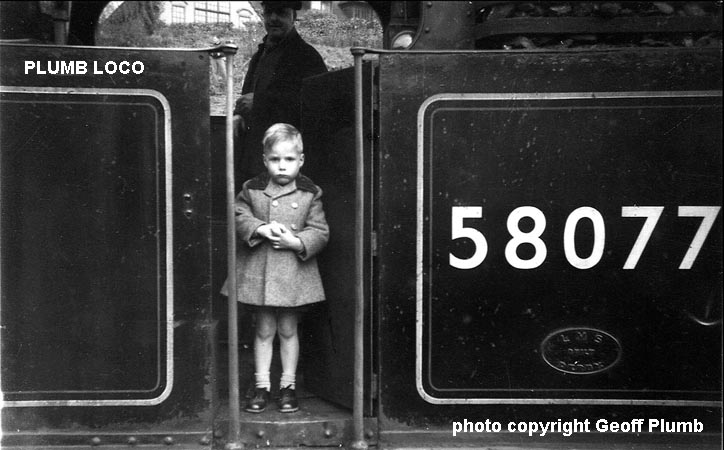
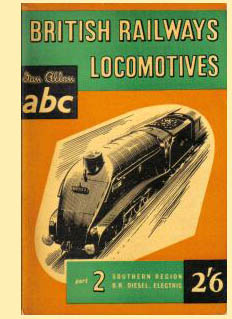 (Above) In many ways, the Rev Audrey's stories of 'Thomas the Tank Engine' puffing up and down his branch line are a cruel deception, for the cute little engine is nothing like the living, breathing monsters we see in real life. These engines have fires raging in their bellies and steam rushing through their veins, so when a child is lifted up to the footplate and shown a fireman shovelling coal into the firebox, they probably think they're being offered up as some kind of a metaphorical sacrifice! This photo of four year-old Geoff Plumb in the cab of MR 1P 0-4-4T No 58077 at Wirksworth station during the SLS/MLS 'High Peak Rail Tour' on 25th April 1953 speaks volumes...'No anoraks in those days!' he says on his website - 'I was enjoying myself - honest!' Treat yourself to Geoff's photos by visiting his superb site via this link. - 'Plumb Loco'
(Above) In many ways, the Rev Audrey's stories of 'Thomas the Tank Engine' puffing up and down his branch line are a cruel deception, for the cute little engine is nothing like the living, breathing monsters we see in real life. These engines have fires raging in their bellies and steam rushing through their veins, so when a child is lifted up to the footplate and shown a fireman shovelling coal into the firebox, they probably think they're being offered up as some kind of a metaphorical sacrifice! This photo of four year-old Geoff Plumb in the cab of MR 1P 0-4-4T No 58077 at Wirksworth station during the SLS/MLS 'High Peak Rail Tour' on 25th April 1953 speaks volumes...'No anoraks in those days!' he says on his website - 'I was enjoying myself - honest!' Treat yourself to Geoff's photos by visiting his superb site via this link. - 'Plumb Loco'
(Below) The photo of a knee-knocking Geoff Plumb on the footplate reminds me of my own timidity at such a young age, because it wasn't until after a dozen or so close encounters with steam that I finally mastered my fear of them. In fact, the expression 'cheap thrill' springs to mind, because not only was train spotting a thrilling pursuit, it cost nothing to stand by a railway line collecting engine numbers, which, for many post-war families strapped for cash, came as a blessing in disguise. Parents gave the hobby a universal 'thumbs-up' during the 1950s and train spotting became the national hobby for boys.
As for my own scary experience? The childhood memory is fallible, they say, but if I had to take stock of all my spotting memories, the sight of a mid-afternoon express thundering through Calverley & Rodley behind a rockin'-rollin' Class B1 is the most profound of all. Talk about rough-riding! It was a spell-binding moment that rooted me to the spot. The train hurtled through the station, rocking and swaying over the points like a wild stallion. You could feel the air pressure bearing down, a headlong rush of noise and smell - then it was gone, the magic all too brief. I'm not sure if the NER driver had some misbegotten allegiance to former companies engines working on MR territory, or if the train was booked to an impossibly tight mid-afternoon schedule between Bradford and Leeds. Whatever the reason, thanks for the memory! The photo was taken on a Brownie 127 in June 1958.
(Above-Below) I'm not sure what to say about this photo of two young spotters watching the dignified passage of Class A1 60140 Balmoral through Selby station on the 'up' main in August 1961. My guess is that they are local lads who are familiar with the station layout and its constituent semaphore signalling, 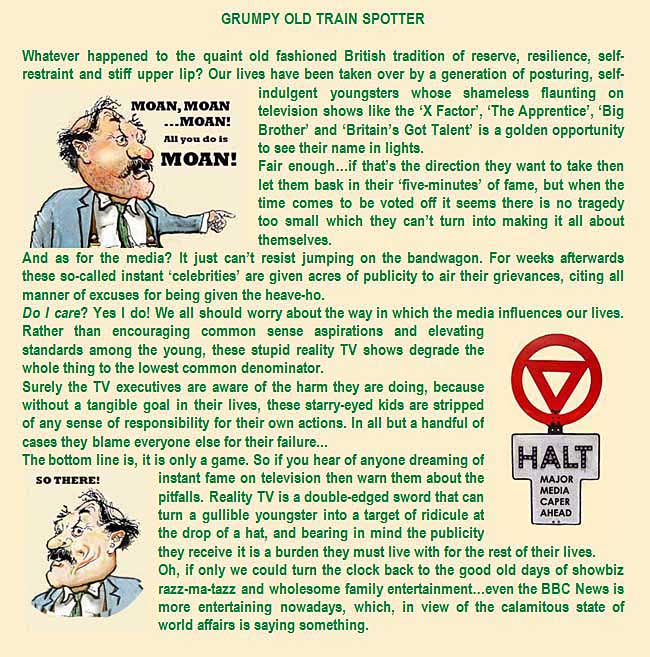 and are inherently aware of the general direction of traffic. Presumably both will have a grasp of the parameters of safety and have the common sense to move out of the way when a 'down' stopping train is due. Even so we cannot ignore the fact that sitting with legs dangling over the edge of the 'down' platform is downright reckless behaviour. Okay, perhaps there was an obligatory 40mph speed limit across the Ouse swing bridge, hence trains passed through the station at no more than a pedestrian pace and stopping trains were even slower, of course, but these youngsters were not only posing a danger to themselves, their stupid behaviour displayed an out-and-out lack of concern that some guileless infant might think it's normal practise and just decide to copy them? Oh, the folly of youth! It's only when you get older that you realise how difficult it was for stoical railway staff in their attempt to foil impetuous youths from pushing the boundaries to see how far they could go....bunking sheds, pennies on the line and many other indiscretions besides. Why did we do it? No, I have no idea either!
and are inherently aware of the general direction of traffic. Presumably both will have a grasp of the parameters of safety and have the common sense to move out of the way when a 'down' stopping train is due. Even so we cannot ignore the fact that sitting with legs dangling over the edge of the 'down' platform is downright reckless behaviour. Okay, perhaps there was an obligatory 40mph speed limit across the Ouse swing bridge, hence trains passed through the station at no more than a pedestrian pace and stopping trains were even slower, of course, but these youngsters were not only posing a danger to themselves, their stupid behaviour displayed an out-and-out lack of concern that some guileless infant might think it's normal practise and just decide to copy them? Oh, the folly of youth! It's only when you get older that you realise how difficult it was for stoical railway staff in their attempt to foil impetuous youths from pushing the boundaries to see how far they could go....bunking sheds, pennies on the line and many other indiscretions besides. Why did we do it? No, I have no idea either!
(Below) A more sensible approach to the hobby is demonstrated by this group of young spotters standing at the end of the down platform at Darlington. You can almost imagine the feral glint in their eyes when this unidentified Deltic class came into view at the head of the 13.30 Edinburgh-Kings Cross 'Heart of Midlothian'.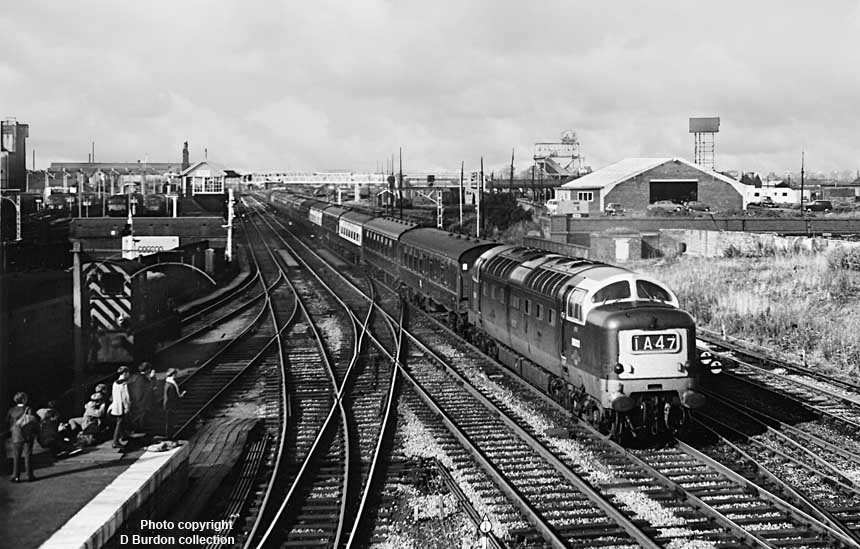
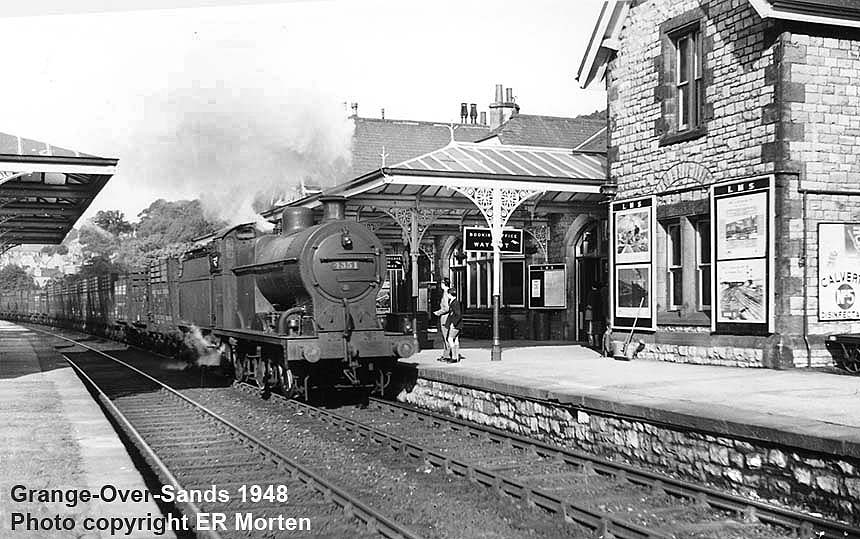
(Above-Below) This ER Morten shot of Grange-Over-Sands station in 1948 shows how little the station has changed over the years. Designed by Lancaster architect Edward Paley in 1864, the station is now a Grade 2  listed building and boasts the original ornate cast iron and glass awnings which were extensively restored in the late 1990s; the work was well worth it...the station received a Heritage Trust Award in 1998. Here a pair of spotters watch ex-LMS Class 4F No 4351 heading an 'up' freight in 1948. The Furness line to Barrow once carried heavy freight to support the iron and steel industry of the Furness area, including coke from County Durham via the former NE route over Stainmore across the Pennines
listed building and boasts the original ornate cast iron and glass awnings which were extensively restored in the late 1990s; the work was well worth it...the station received a Heritage Trust Award in 1998. Here a pair of spotters watch ex-LMS Class 4F No 4351 heading an 'up' freight in 1948. The Furness line to Barrow once carried heavy freight to support the iron and steel industry of the Furness area, including coke from County Durham via the former NE route over Stainmore across the Pennines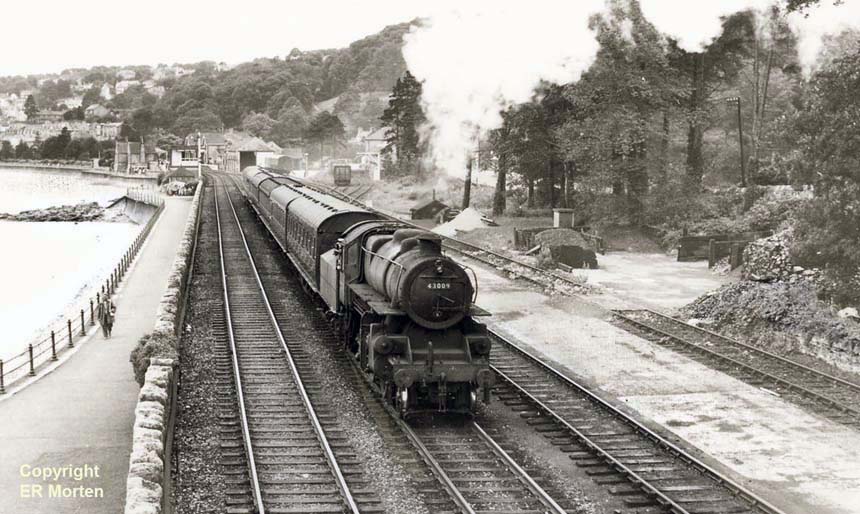
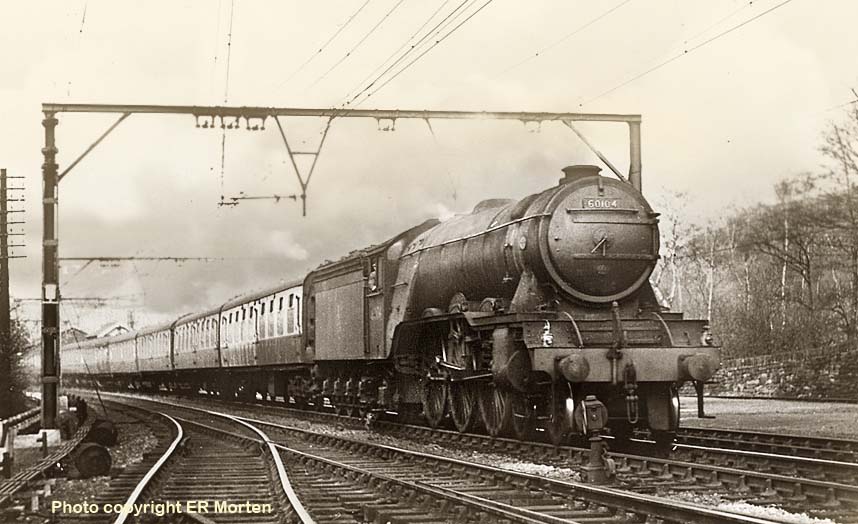
(Above-Below) Ex-Annesley fireman Chris Ward's interest in trains began in 1952. He remembers the year because among the first 'namers' he 'copped' was Class B1 No 61029 'Chamois' before the loco was transferred north of the border from Sheffield Darnall (41A) to St Margarets shed (64A) in September 1953. As a seven year-old spotter, Chris had a long walk from his home on the Beauvale Estate to Hucknall National Junior School (no mamby-pamby school runs in those days!) and as he crossed the bridge over the GC line he would hang around to watch the Sheffield-Marylebone 'Master Cutler' Pullman, headed by one of 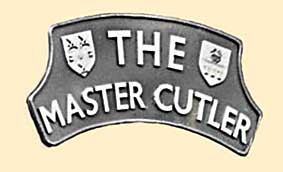 Leicester's Class A3s - 60049 'Galtee More', 60052 'Prince Palatine', 60054 'Prince of Wales', 60102 'Sir Frederick Banbury', 60107 'Royal Lancer' or 60104 'Solario' (all grand names to conjure with). However, watching the stately passage of the Pullman was not enough for Chris, who, despite the risk of being late for school, waited for the 'twenty-to-niner' in the opposite direction, a Maylebone-Bradford train, usually headed by a Class V2. It wasn't until the down train had gone that Chris made a last-minute dash to school before morning assembly at 08.55! Here, Leicester's (38C) Class A3 No 60104 Solario heads an up Manchester-Marylebone express through Wortley between Penistone and Sheffield on 19th April 1954. No 60104 was built at Doncaster Works in March 1923 numbered 1473, then 4473 in 1924, followed by 104 in 1946, before it finally became 60104 in BR days. The loco began its 35-year career allocated to Doncaster followed by spells at Copley Hill, Gorton, King's Cross, Leicester and Neasden. It was withdrawn from Grantham shed in December 1959 and scrapped at Doncaster Works the following month, earning itself the dubious distinction of being the first Class A3 to go! Solario was named after the racehorse that won the 1925 St Leger at Doncaster. (Below) We fast-forward to Chris's days at Carlton-Le-Willows (Nottingham) Grammar School, by which time the only things he was interested in were girls, sports and rock 'n' roll, and the only job he ever wanted was to be an engine driver! After a brief interview with the Annesley Shedmaster, Mr Ede (I recall a 'talking' horse on TV by that name!) followed by a medical at Derby, the big day came when Chris started as a cleaner at Annesley Loco Shed at 08.00 on January 11th 1960. You can read his fascinating account of life at Annesley shed and the day to day running of 16D on the superb 'Chris Ward's Annesley Website' - highly recommended; click here
Leicester's Class A3s - 60049 'Galtee More', 60052 'Prince Palatine', 60054 'Prince of Wales', 60102 'Sir Frederick Banbury', 60107 'Royal Lancer' or 60104 'Solario' (all grand names to conjure with). However, watching the stately passage of the Pullman was not enough for Chris, who, despite the risk of being late for school, waited for the 'twenty-to-niner' in the opposite direction, a Maylebone-Bradford train, usually headed by a Class V2. It wasn't until the down train had gone that Chris made a last-minute dash to school before morning assembly at 08.55! Here, Leicester's (38C) Class A3 No 60104 Solario heads an up Manchester-Marylebone express through Wortley between Penistone and Sheffield on 19th April 1954. No 60104 was built at Doncaster Works in March 1923 numbered 1473, then 4473 in 1924, followed by 104 in 1946, before it finally became 60104 in BR days. The loco began its 35-year career allocated to Doncaster followed by spells at Copley Hill, Gorton, King's Cross, Leicester and Neasden. It was withdrawn from Grantham shed in December 1959 and scrapped at Doncaster Works the following month, earning itself the dubious distinction of being the first Class A3 to go! Solario was named after the racehorse that won the 1925 St Leger at Doncaster. (Below) We fast-forward to Chris's days at Carlton-Le-Willows (Nottingham) Grammar School, by which time the only things he was interested in were girls, sports and rock 'n' roll, and the only job he ever wanted was to be an engine driver! After a brief interview with the Annesley Shedmaster, Mr Ede (I recall a 'talking' horse on TV by that name!) followed by a medical at Derby, the big day came when Chris started as a cleaner at Annesley Loco Shed at 08.00 on January 11th 1960. You can read his fascinating account of life at Annesley shed and the day to day running of 16D on the superb 'Chris Ward's Annesley Website' - highly recommended; click here 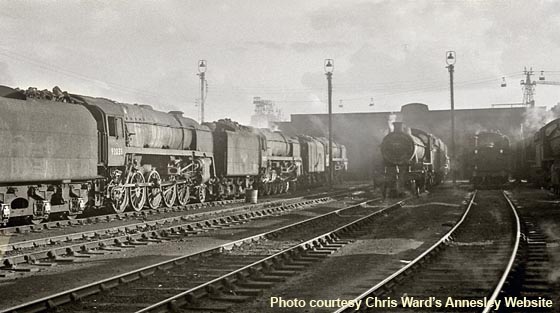
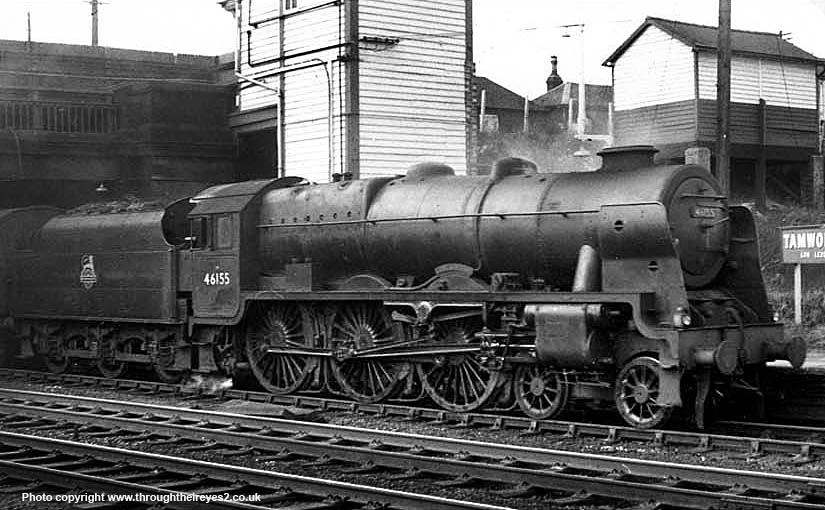
(Above-Below) Tamworth was another train spotting hotspot in steam days. The station is conveniently situated at the crossing point of two main lines: one carrying Bristol-Newcastle expresses between 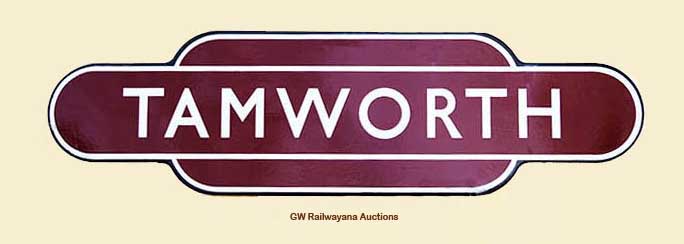 Birmingham and Derby, the other Euston-Gasgow expresses on the West Coast Main Line between Nuneaton and Stafford. There were four platforms: platforms 1 and 2 serving the low level West Coast Main Line and platforms 3 and 4 on the high level cross country route, though you were most likely of find spotters congregated in an adjacent field where traffic on both routes were 'spottable'. Here 'Royal Scot' class No 46155 'The Lancer' restarts a semi-fast train from the 'up' platform 1 on 12th February 1957. In the background the High Level Station is visible including the lift and small timber waiting room on the 'up' platform; the 'up' line being towards Derby. On the same day, 'Duchess' class 46242 City of Glasgow heads a northbound semi-fast on the down slow line past Tamworth No 1 box.
Birmingham and Derby, the other Euston-Gasgow expresses on the West Coast Main Line between Nuneaton and Stafford. There were four platforms: platforms 1 and 2 serving the low level West Coast Main Line and platforms 3 and 4 on the high level cross country route, though you were most likely of find spotters congregated in an adjacent field where traffic on both routes were 'spottable'. Here 'Royal Scot' class No 46155 'The Lancer' restarts a semi-fast train from the 'up' platform 1 on 12th February 1957. In the background the High Level Station is visible including the lift and small timber waiting room on the 'up' platform; the 'up' line being towards Derby. On the same day, 'Duchess' class 46242 City of Glasgow heads a northbound semi-fast on the down slow line past Tamworth No 1 box. 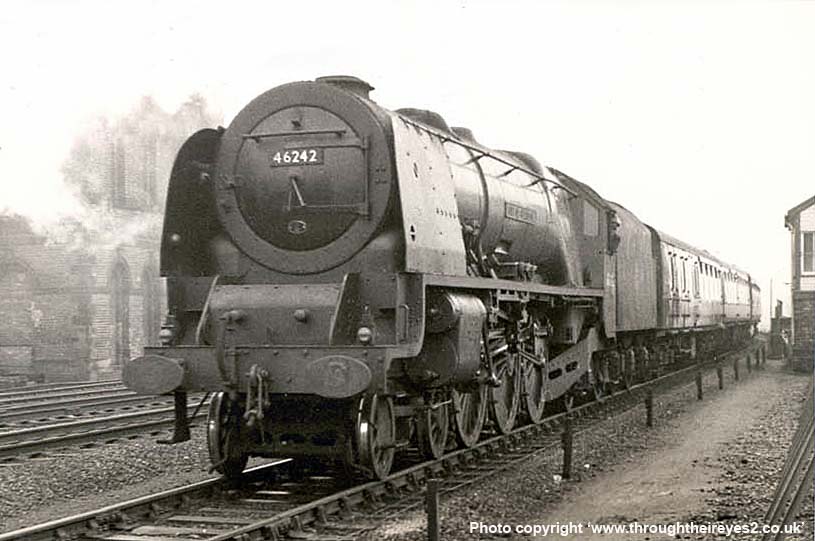
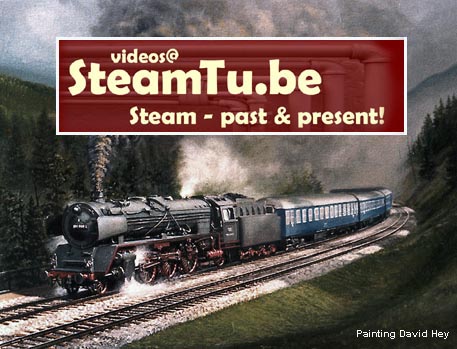 Harking back to the old days before the world wide web (www) was launched in 1989, there was nothing I liked better than browsing through the pages of 'Railway Magazine' and 'Trains Illustrated'. Odd then, that it took me so long to surf one of the largest railway archives in the world on the Internet. At first, I found the 'drag and click' jargon a bit baffling, but once I got going it was great to log on and search through the thousands
Harking back to the old days before the world wide web (www) was launched in 1989, there was nothing I liked better than browsing through the pages of 'Railway Magazine' and 'Trains Illustrated'. Odd then, that it took me so long to surf one of the largest railway archives in the world on the Internet. At first, I found the 'drag and click' jargon a bit baffling, but once I got going it was great to log on and search through the thousands 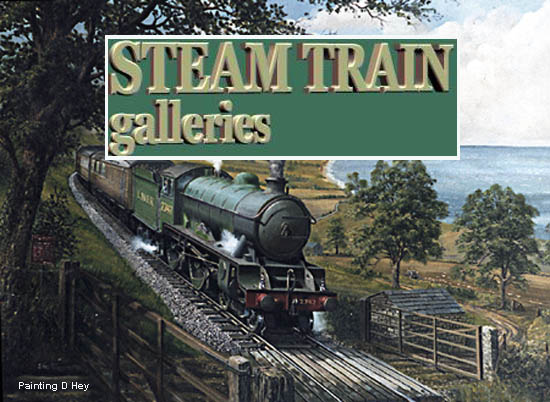 of railway sites. Trouble is, surfing the 'communications super highway' is a daunting task unless you know what you're doing. Over the years, the world wide web has become a victim of its own success, and the information overload - the sheer volume of material it contains - can take a lot of digesting. But the task is made somewhat easier by visiting a community site such as 'Steam Train Galleries'. For an old duffer like me, it is like dropping in on old friends! Talking of old friends, you get the chance to make new ones too! Since starting this website back in 2007, I've always felt like the new kid on the block, yet the world wide web is constantly growing, and one of the latest is Steamtube - a new social network for steam fans on the web...
of railway sites. Trouble is, surfing the 'communications super highway' is a daunting task unless you know what you're doing. Over the years, the world wide web has become a victim of its own success, and the information overload - the sheer volume of material it contains - can take a lot of digesting. But the task is made somewhat easier by visiting a community site such as 'Steam Train Galleries'. For an old duffer like me, it is like dropping in on old friends! Talking of old friends, you get the chance to make new ones too! Since starting this website back in 2007, I've always felt like the new kid on the block, yet the world wide web is constantly growing, and one of the latest is Steamtube - a new social network for steam fans on the web...
LTS at Tilbury in late 1940s
by Duncan Grant
My interest in railways began when my family lived near to the LMS North London lines near to Devons Road - at least that's what my mother told me of the days when I roamed away from home and could be found watching the railway from a nearby footbridge known as 'Peggy Leg Steps' but I was far too young to have any recollections of those very early days. Later after being evacuated to Aylesbury and living close to the LMS's Aylesbury to Cheddington branch my interest was renewed on the occasions when I was 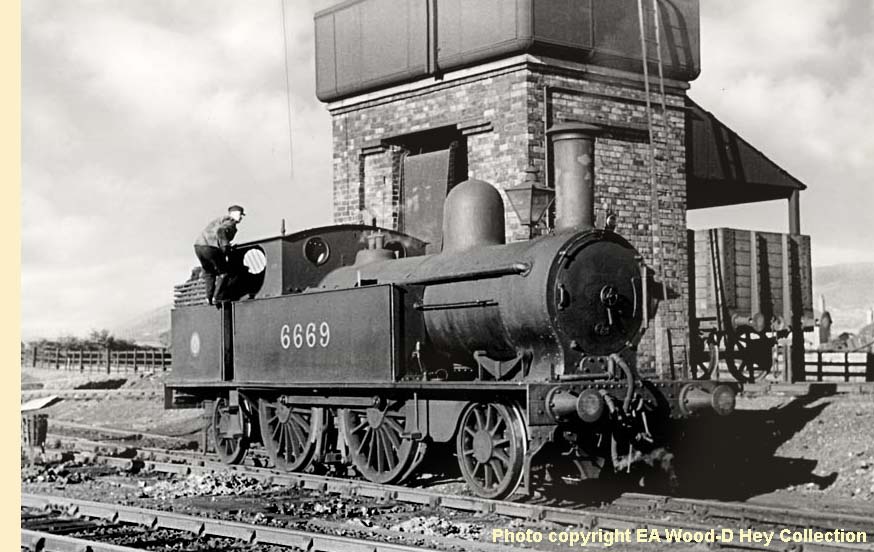 invited into the signal box at the level crossing in Park Street. This was often when the box was busiest opening and closing the gates for the regular movements of the LNWR Webb 0-8-0's which shunted the nearby goods yard each afternoon. This traffic was supplemented by the passenger train service which was push pull operated by some of Bletchley's allocation of Webb 2-4-2 tanks - I believe one of these was often loco 6666. The Webb 2.4-2Ts were allocated far and wide and in this shot (right) sister member of the class No 6669 is being coaled at an unknown location.
invited into the signal box at the level crossing in Park Street. This was often when the box was busiest opening and closing the gates for the regular movements of the LNWR Webb 0-8-0's which shunted the nearby goods yard each afternoon. This traffic was supplemented by the passenger train service which was push pull operated by some of Bletchley's allocation of Webb 2-4-2 tanks - I believe one of these was often loco 6666. The Webb 2.4-2Ts were allocated far and wide and in this shot (right) sister member of the class No 6669 is being coaled at an unknown location.
After the war I returned to my home in Tilbury and conversations with school mate Colin Dodd gave me an insight to LMS locomotives but didn't direct me to the Tilbury line. Instead, largely due to the influence of a neighbour, Dick Ellis who had bought an LNER ABC I was persuaded to cycle to Brentwood where it was possible to look down to the depot and make a note of the numbers for Dick's book…and so I got to thinking about how close I lived to the LTS Tilbury depot - in fact a much shorter bike ride away. In no time at all I had acquired the LMS ABC and made daily visits to the depot which at that time had an allocation of mainly ex-LTSR 4-4-2T's of both types although many of the trains to Fenchurch Street and Pitsea were hauled by the Stanier 3 cylinder 2-6-4Ts in the 2500 series. In addition there were also occasional appearances by Fowler 2-6-4Ts, and I recall 2374 and 2342 were regular transfers to the LTS lines.The shot (below) shows 42328 at Huntigdon. 
The line to London and Upminster passed nearby the depot so that my observations there could be enhanced by the passing services not only to and from Fenchurch Street but also to and from Upminster. The Upminster trains were of course push and pull operated with Ex MR 0-4-4T locos in charge. In addition there were also the occasional goods train on the loop line which by passed Tilbury Riverside but passed the depot. These trains were normally in the hands of LTSR 0-6-2Ts or the Plaistow based 0-6-0, 4228, and there was always one train each evening moving oil tanks from the Thameshaven branch. It was during my early visits to the depot that the first of the Fairburn 2-6-4Ts arrived and these were to be the mainstay of power until the arrival of the BR standard 2-6-4Ts in later years.
Early each afternoon the locomotive which shunted the goods yard at Grays came to Tilbury depot to be coaled and watered. These were almost always old ex MR 2F 0-6-0s and I recall that 3035, 22931 and 23012 were regular performers. Additionally, throughout the day the carriage sidings at Tilbury Riverside were being re-arranged by one of the early series of LTSR 4-4-2Ts and 2097 and 2106 were the customary shunters. This loco (below left) is, of course, one of the earlier Whitelegg 4-4-2Ts No 2099 and the location is the original LTS Plaistow depot which later became a VW dealership facility.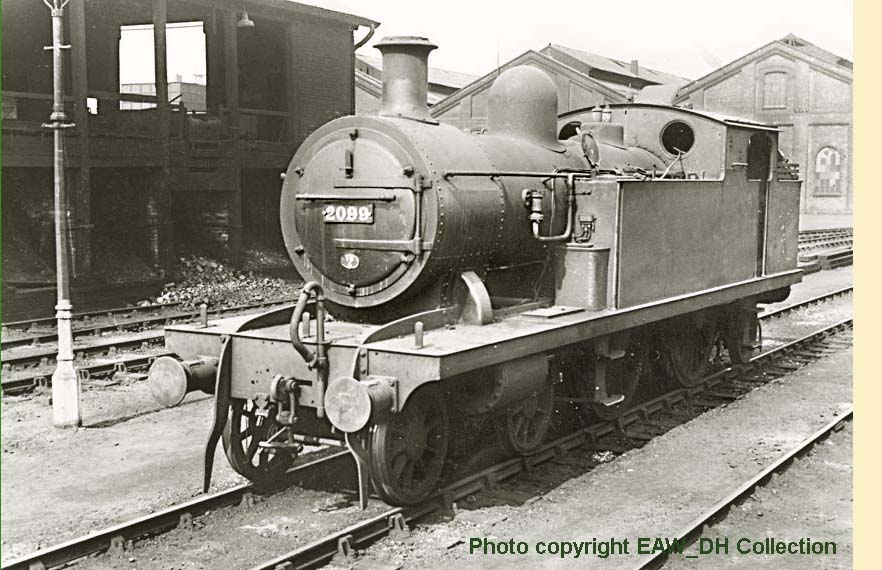 Tilbury Riverside was the end of the line for services from Fenchurch Street and Shoeburyness but also for boat trains to and from St. Pancras. The most regular of these trains were for the services operated by the Swedish Lloyd Company whose vessels arrived on Monday mornings and left on Saturday evening. This meant that the locomotive hauling the train from St. Pancras for the Saturday sailing would be stabled at Tilbury over the weekend ready to take the London bound service on Monday morning. These weekend visitors were usually Cricklewood or Kentish Town based Fowler 0-6-0s but occasionally they were one of two Crab 2-6-0s and 2855 of Cricklewood and 2839 of Kentish Town were these. Tilbury Riverside station was to become a focal point for me as my job in the shipping and forwarding department of a major travel agent involved meeting passengers who had arrived on the big ocean going liners and which often needed four or five boat trains to carry passengers to St.Pancras. You can imagine my delight to find a Cricklewood based class 5 4-6-0 5342 at the head of one of the first boat trains I saw there. There were of course occasions when unusual engines arrived and I still recall one occasion when a troopship was sailing that a special military boat train had arrived and had then been turned on the Tilbury triangle. It was then waiting on the by-pass line to head back London-wards. I had finished my early morning paper round which ended at the bus stop near to the depot and looked towards the empty stock. To my surprise and delight the waiting locomotive was resplendent in a well worn maroon colour and moreover, was sporting a name plate. The visitor was in fact Jubilee 5726 'Vindictive' then shedded at Patricroft. This was to be the only time that I saw such a splendid sight at Tilbury but the
Tilbury Riverside was the end of the line for services from Fenchurch Street and Shoeburyness but also for boat trains to and from St. Pancras. The most regular of these trains were for the services operated by the Swedish Lloyd Company whose vessels arrived on Monday mornings and left on Saturday evening. This meant that the locomotive hauling the train from St. Pancras for the Saturday sailing would be stabled at Tilbury over the weekend ready to take the London bound service on Monday morning. These weekend visitors were usually Cricklewood or Kentish Town based Fowler 0-6-0s but occasionally they were one of two Crab 2-6-0s and 2855 of Cricklewood and 2839 of Kentish Town were these. Tilbury Riverside station was to become a focal point for me as my job in the shipping and forwarding department of a major travel agent involved meeting passengers who had arrived on the big ocean going liners and which often needed four or five boat trains to carry passengers to St.Pancras. You can imagine my delight to find a Cricklewood based class 5 4-6-0 5342 at the head of one of the first boat trains I saw there. There were of course occasions when unusual engines arrived and I still recall one occasion when a troopship was sailing that a special military boat train had arrived and had then been turned on the Tilbury triangle. It was then waiting on the by-pass line to head back London-wards. I had finished my early morning paper round which ended at the bus stop near to the depot and looked towards the empty stock. To my surprise and delight the waiting locomotive was resplendent in a well worn maroon colour and moreover, was sporting a name plate. The visitor was in fact Jubilee 5726 'Vindictive' then shedded at Patricroft. This was to be the only time that I saw such a splendid sight at Tilbury but the 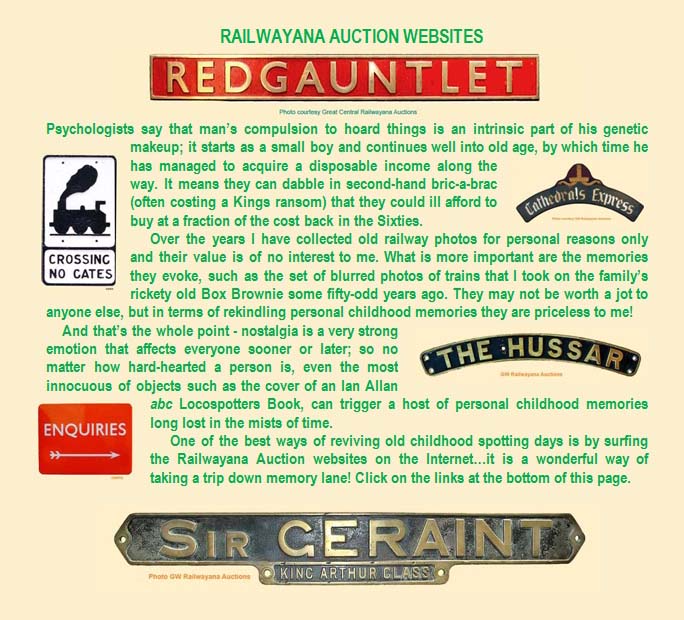 experience had whetted my appetite and thereafter I made regular visits to Euston, Kilburn High Road, Willesden, Kentish Town and Cricklewood depots as well as one occasion when I 'bunked' Old Oak Common and was rewarded with the sight of one of the last 'Bulldogs' in service which I believe was named 'Seagull'.
experience had whetted my appetite and thereafter I made regular visits to Euston, Kilburn High Road, Willesden, Kentish Town and Cricklewood depots as well as one occasion when I 'bunked' Old Oak Common and was rewarded with the sight of one of the last 'Bulldogs' in service which I believe was named 'Seagull'.
Kilburn High Road station was one of my favourite spotting places. The journey from Euston on the Oerlikon ex LNWR electric stock took me past Camden shed and from my vantage point on Kilburn High Street's station there was a non-top procession of main line services into and out of Euston and the trains of empty stock to and from Willesden carriage sidings usually pulled by ex L.N.W.R. 0-8-0s and ancient ex M.R 0-6-0s. I well recall that on one of my first trips up to London I noted a Cricklewood allocated Stanier 2-8-0 number 8414 in Ripple Lane sidings. This loco was to become a regular sighting there and elsewhere around London and has subsequently appeared on internet sites.
Although my job meant spending time at Tilbury Riverside, the office was located inside Tilbury Docks and adjacent was one the railway lines of the Port of London Authority which meant that its locos passed nearby. Most of the Tilbury Docks locos were of pre-world war II designs but numbers 88 and 89 were ex WD 0-6-0Ts of the same type as LNER Class J94.
My visits to Tilbury depot proper became less regular after I married and moved away but occasional journeys to London meant that there was still steam to be seen and my last steam sighting was at Grays when a boat train from St Pancras passed hauled by Ivatt 2-6-0 43120. My final visit to Tilbury depot was in the early 60's when BR Standard 2-10-0s were hauling trains from Fisons' siding on the Thameshaven branch to Immingham. The last loco I saw on that occasion was 92202 of Immingham.
Electrification of passenger services followed and dieselisation of freight traffic which led to my last locomotive worth mentioning which was when I found the Western Class diesel hydraulic 1055 at the head of an oil tanker train from Acton in the yard at Thameshaven. But nothing like the feeling I had when Stanier 2-6-4T number 42513 first arrived at the depot resplendent in BR full lined out livery.
Nothing remains now of the Tilbury depot 33B, but I still have my memories....
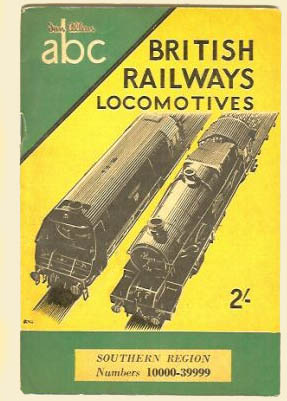 Back in the Fifties, train spotting was a good lesson for small boys who hated the scholarly drudge of school homework. By far the most rewarding part of a day's spotting was underlining the relevant 'cops' in an Ian Allan abc Locospotters Book, which came as close to school homework as anyone could get! The abc combined volume was a journey of discovery, containing the oddest names belonging to the former GC Director class D11 Nos 62671-62694 built to Scottish loading gauge, including a Hobbie Elliot and a Luckie Mucklebackit - both characters from the novels of Sir Walter Scott - along with the ex-NB Class D30s Nos 62418-62441 which had a Cuddie Headrigg, Dumbiedykes and Caleb Balderstone among their classmates. Sadly, the majority of the ScR's engines listed in my abc remained woefully blank. This included several Scottish-based A4s and A3s, which belonged to the prestigious class 'A' Pacifics - a prized 'cop' among Eastern Region fans. By the early 1960s, however, unwelcome gaps began to appear among the steam classes (due to scrapping) and the proliferation of new diesels did not enter the equation because they were not yet listed. Call it a dereliction of duty, if you like, but the inconsistencies creeping into the hobby was totally at odds with the orderliness that spotters expected, and many disenchanted youngsters turned to railway photography - a natural adjunct to train spotting. Rail Cameraman Roy Lambeth's photo (below) is a good example...Roy's Page 61 features more great shots of steam days (see left-hand menu).
Back in the Fifties, train spotting was a good lesson for small boys who hated the scholarly drudge of school homework. By far the most rewarding part of a day's spotting was underlining the relevant 'cops' in an Ian Allan abc Locospotters Book, which came as close to school homework as anyone could get! The abc combined volume was a journey of discovery, containing the oddest names belonging to the former GC Director class D11 Nos 62671-62694 built to Scottish loading gauge, including a Hobbie Elliot and a Luckie Mucklebackit - both characters from the novels of Sir Walter Scott - along with the ex-NB Class D30s Nos 62418-62441 which had a Cuddie Headrigg, Dumbiedykes and Caleb Balderstone among their classmates. Sadly, the majority of the ScR's engines listed in my abc remained woefully blank. This included several Scottish-based A4s and A3s, which belonged to the prestigious class 'A' Pacifics - a prized 'cop' among Eastern Region fans. By the early 1960s, however, unwelcome gaps began to appear among the steam classes (due to scrapping) and the proliferation of new diesels did not enter the equation because they were not yet listed. Call it a dereliction of duty, if you like, but the inconsistencies creeping into the hobby was totally at odds with the orderliness that spotters expected, and many disenchanted youngsters turned to railway photography - a natural adjunct to train spotting. Rail Cameraman Roy Lambeth's photo (below) is a good example...Roy's Page 61 features more great shots of steam days (see left-hand menu).
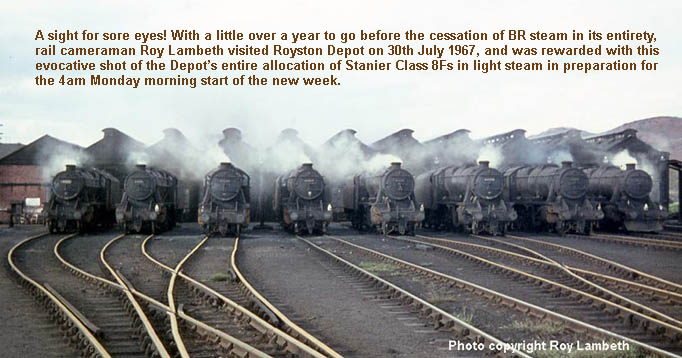
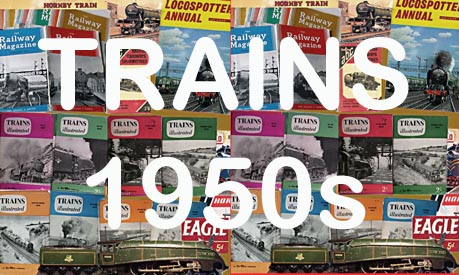 So now you have the measure of this train spotting page and fancy a trip down memory lane, these 3 links will take you back to the 1950s - a decade of post-war austerity when the basic ethos was to provide food for the table - invariably home-grown vegetables picked fresh from the garden. The Sixties heralded a new dawn of optimism and prosperity; it was a decade when the standard of living improved no end and yet the quality of our lives became all the more poorer for it. Click on pictures to vist pages, then click on 'X' top right of screen to return here
So now you have the measure of this train spotting page and fancy a trip down memory lane, these 3 links will take you back to the 1950s - a decade of post-war austerity when the basic ethos was to provide food for the table - invariably home-grown vegetables picked fresh from the garden. The Sixties heralded a new dawn of optimism and prosperity; it was a decade when the standard of living improved no end and yet the quality of our lives became all the more poorer for it. Click on pictures to vist pages, then click on 'X' top right of screen to return here
(Below) When I saw this photograph of Ian Allan abc Locospotter Books on eBay recently, it triggered a shedful of spotting memories from childhood days...if railway memorabilia is your bag, then shopping on eBay is the place for you. On every visit I've counted no less than 10,000 railway items on sale at any one time - click on 'collectables', scroll down to transportation - then click on 'railwayana' and you'll find a veritable Alladin's cave of memorabilia from Edmondson card tickets to locomotive nameplates. Highly recommended...photo courtesy eBay trader 'dc3400'.
(Above-Below) Train spotters were everywhere! Trains coming and going at Bristol Temple Meads. A couple of spotters watch the arrival of 'Castle' class No 7022 Hereford Castle on 2nd April 1951, while spotters watch the spectacle of a Class A4 'Streak' arriving at Retford with a northbound express.
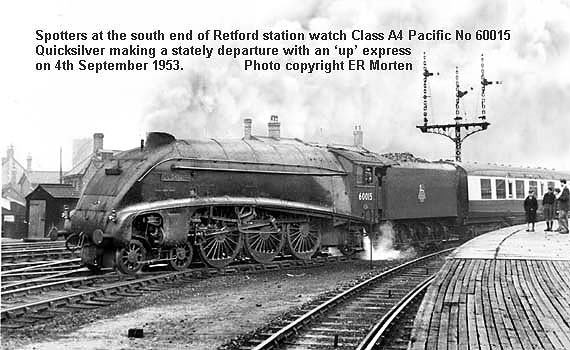
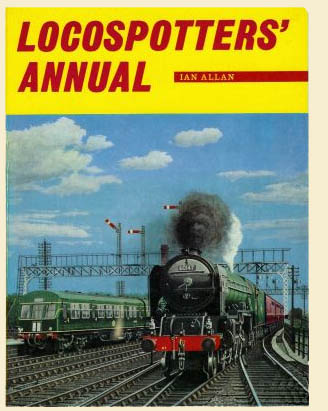 (Above) I like the EE Co machines, I really do! During the transition from steam, the English Electric Company was the only manufacturer to have designed and built diesel locomotives to meet the requirements of all five BR power classes. The company also supplied more than half of the diesel fleet. But the box-like shapes of diesel locomotives are soulless in comparison to the bulky proportions of a steam locomotive - and less scary, too! Here, young spotters are not afraid to get a close-up view of No D258 being coupled-up to a southbound train at York Photo © EA Wood-D Hey.
(Above) I like the EE Co machines, I really do! During the transition from steam, the English Electric Company was the only manufacturer to have designed and built diesel locomotives to meet the requirements of all five BR power classes. The company also supplied more than half of the diesel fleet. But the box-like shapes of diesel locomotives are soulless in comparison to the bulky proportions of a steam locomotive - and less scary, too! Here, young spotters are not afraid to get a close-up view of No D258 being coupled-up to a southbound train at York Photo © EA Wood-D Hey.
(Below) 'BLINKERS!' During the 1950s, British Railways had more than 230 different steam engine classes on its books, therefore identification was a tricky subject for the inexperienced spotter. I'm referring to the numerous former 'Big Four' 0-6-0 tender engines and tank engines still in common use across the Regions. HC Casselerley's excellent 'Observers Book of Railway Locomotives', published by Frederick Warne & Co Ltd., was a great aid in identifying the full range of British Railways steam engines then in use on Britain's railways. Even the 'namers' among the 'blinkered' 'A1' and 'A2' Pacifics were difficult to tell apart. Indeed, both classes could well have been one and the same to me until the quite obvious differences became apparent later. Class A2 No 60513 Dante is being prepared for duty at its home shed of New England. Photo © D Hey-EA Wood collection
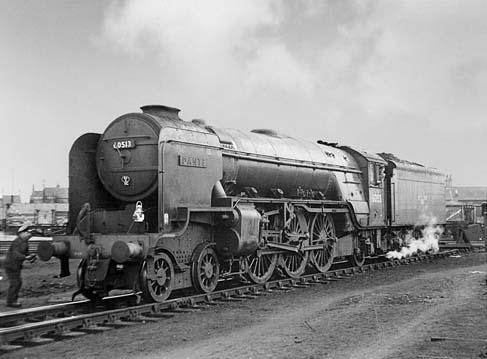
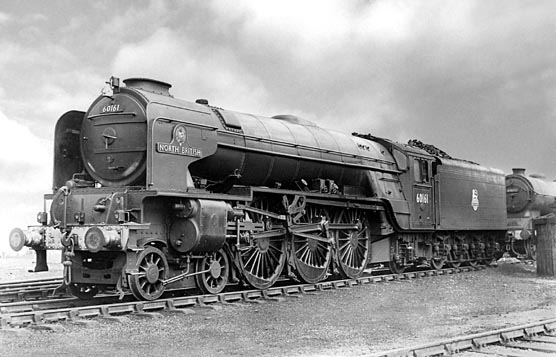
 (Above) For the benefit of younger spotters, the nickname, 'blinker', was derived from the appearance of the smoke deflectors which look similar to the leather pieces fixed to a horse's bridle to prevent the animal from seeing in any direction other than straight forward. The nickname stuck with me until my dad explained that deflectors were designed to prevent the formation of a vacuum which can suck swirling smoke down along the boiler and obscure the driver's view from the cab. As for the Class A1 names? In true LNER tradition, several members of the class appeared with names of racehorses and birds, but five engines carried names of the constituent railway companies which had gone to make up the LNER - No 60113 Great Northern, a rebuild of an original Gresley Class A1 Pacific - No 60147 North Eastern; 60156 Great Central; 60157 Great Eastern and 60161 North British, the latter seen here at its home shed of Haymarket. The full complement of 49 engines was not named until the early 1950s.
(Above) For the benefit of younger spotters, the nickname, 'blinker', was derived from the appearance of the smoke deflectors which look similar to the leather pieces fixed to a horse's bridle to prevent the animal from seeing in any direction other than straight forward. The nickname stuck with me until my dad explained that deflectors were designed to prevent the formation of a vacuum which can suck swirling smoke down along the boiler and obscure the driver's view from the cab. As for the Class A1 names? In true LNER tradition, several members of the class appeared with names of racehorses and birds, but five engines carried names of the constituent railway companies which had gone to make up the LNER - No 60113 Great Northern, a rebuild of an original Gresley Class A1 Pacific - No 60147 North Eastern; 60156 Great Central; 60157 Great Eastern and 60161 North British, the latter seen here at its home shed of Haymarket. The full complement of 49 engines was not named until the early 1950s.

(Above-Below) A favourite place for train spotting during the 1950s was Thirsk station in North Yorkshire. The station is situated on the flat racing ground north of York - a superbly-aligned section of track that has seen more high-speed running than anywhwere in Britain. From the platform edge, you could spot a train a mile away, especially the Class A4 'Streaks' - the sun caught their distinctive streamlined fronts which produced a beam of light. It was just a faint glimmer at first, and hardly discernable in the shimmering haze rising from the track, but you knew instantly what was hurtling towards you - 'Streeaaak!' This grainy shot of a southbound A4 is the only one I have left from my own collection of negs - almost all were destroyed in a fire. (Below) Class A4 No 60007 Sir Nigel Gresley heads the down 'Talisman' through Tollerton in typical flamboyant style. Photo © D Hey-EA Wood collection
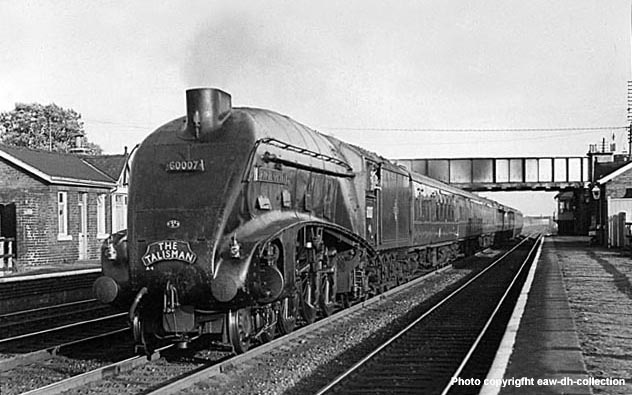
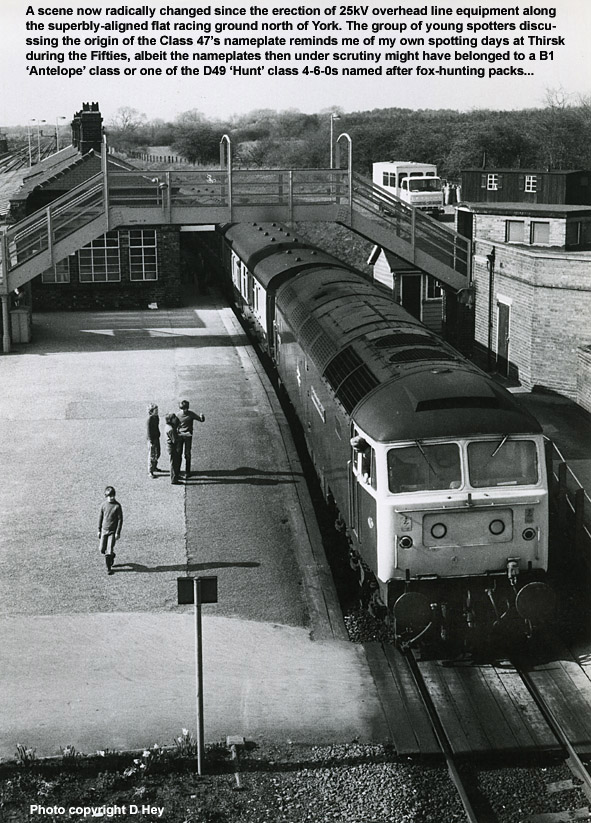
(Above-Below) Endangered species! Odd things happen to small boys when they grow older. Train spotting isn't enough to sustain their full interest. Instead they move on to more grown up things like pop music, and before long they're thumbing through the lingerie pages in mum's mail order catalogue, or ogling the girls' 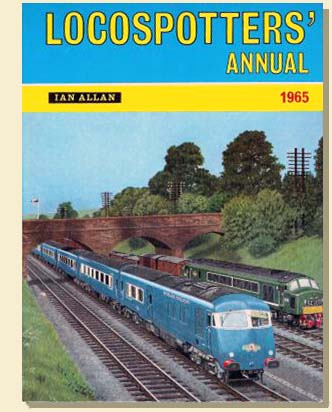 gym teacher at school. There is nothing out of the ordinary about that, of course - today's adult railway enthusiasts are pretty much ex-train spotters, now married with 2·4 children, who did exactly the same thing at that age. Trouble is, as soon as testosterone-fuelled hormones kick-in, young boys develop a neurotic obsession for chasing girls than collecting engine numbers. You can always tell when this aberration happens. Boys go all gooey-eyed and wear an expression of poodle-like devotion once reserved for bagging a prized 'cop'. Like it or not, train spotting and girls are like the poles of two magnets being forced together and something's got to give. When a girl flirts with a boy he loses all power of reason; when she has him wrapped around her little cloven hoof, he's doomed! In between falsetto cries of 'Streeaak!' at Thirsk station, this seat on the 'down' platform was my favourite perch for train spotting, but during a lull between trains the attention span of a pea-brained spotter wasn't conducive to self-discipline and I ended up being barred from Thirsk station a couple of times. I did manage to sneak back, though, and headed straight for the seat, which was out of sight of the main buildings on the opposite side of the main line, so the station staff would be the least likely to notice I was there. I was deluding myself! - 'Not you again, yer little sod! I thought we told you to bugger off!'
gym teacher at school. There is nothing out of the ordinary about that, of course - today's adult railway enthusiasts are pretty much ex-train spotters, now married with 2·4 children, who did exactly the same thing at that age. Trouble is, as soon as testosterone-fuelled hormones kick-in, young boys develop a neurotic obsession for chasing girls than collecting engine numbers. You can always tell when this aberration happens. Boys go all gooey-eyed and wear an expression of poodle-like devotion once reserved for bagging a prized 'cop'. Like it or not, train spotting and girls are like the poles of two magnets being forced together and something's got to give. When a girl flirts with a boy he loses all power of reason; when she has him wrapped around her little cloven hoof, he's doomed! In between falsetto cries of 'Streeaak!' at Thirsk station, this seat on the 'down' platform was my favourite perch for train spotting, but during a lull between trains the attention span of a pea-brained spotter wasn't conducive to self-discipline and I ended up being barred from Thirsk station a couple of times. I did manage to sneak back, though, and headed straight for the seat, which was out of sight of the main buildings on the opposite side of the main line, so the station staff would be the least likely to notice I was there. I was deluding myself! - 'Not you again, yer little sod! I thought we told you to bugger off!'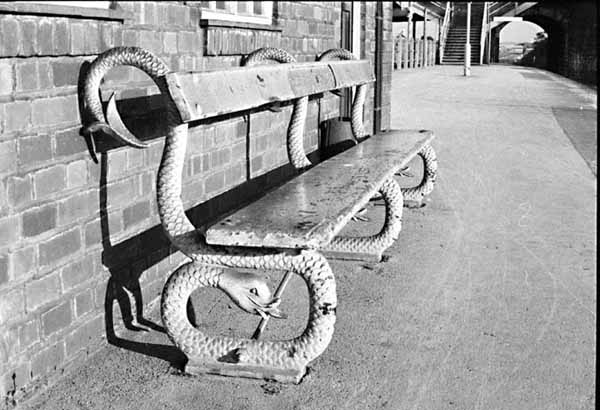
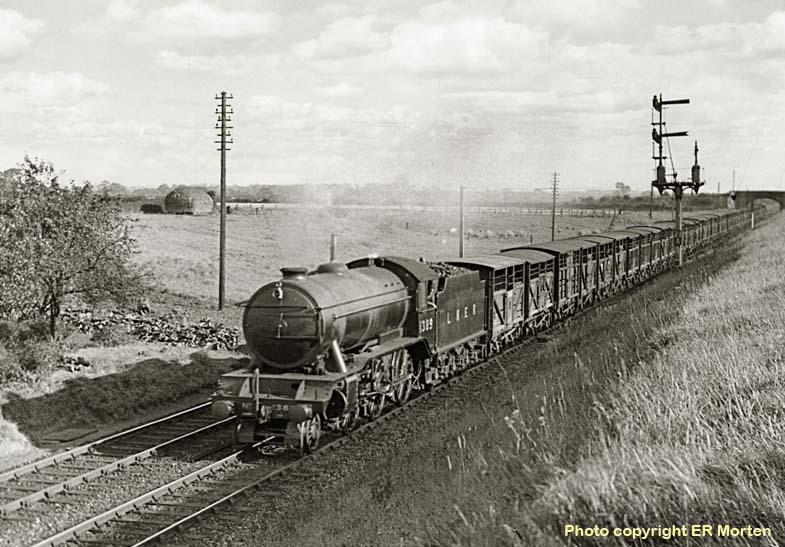
(Above-Below) This superb ER Morten shot of K3 No 1389 at Thirsk in 1933 was taken at signal 21A just south of Green Lane junction, where the two tracks became four. This signal was removed in 1933 when the Hall electro-gas signals (of which this is a 'controlled' version) were replaced by colour lights controlled from the new Thirsk Signal Box. The colour lights improved line capacity of the East Coast Main Line north of York to such an extent that quadrupling didn't become necessary until 1942. (Below) The earlier comments about train spotting at Thirsk station certainly rang a bell with Barrie Foster, who writes - 'Looking through your photos, of particular interest was the shot of four young spotters on Thirsk station in the 1980s. Well, I was born and raised in the Railway Cottages next to the station and spent a lot of time spotting there during childhood. My father was Station Inspector from the early 1950s so he could have been the one who told you to 'bugger off!' Barrie kindly sent some of his photos of old spotting days which I am delighted to reproduce here...he has also come up with some of his mates' names on the photos. In the shot of 'cabbing' 60099 is Ian Roberts, who is also in the shot of Class A4 60001 (standing in front of the number is Alan Moyser). Sadly lost touch with both. The photo of EE Co Type 4 No D388 includes Robert King and Chris Croser, once again lost touch. Finally the shot of68988 at the bottom of the page include Chris Croser on left, Brian Hamilton on right...and standing is Mike Hardy who now owns the village store in Carlton Miniott, the village adjacent to Thirsk station. More photos at the bottom of page...'
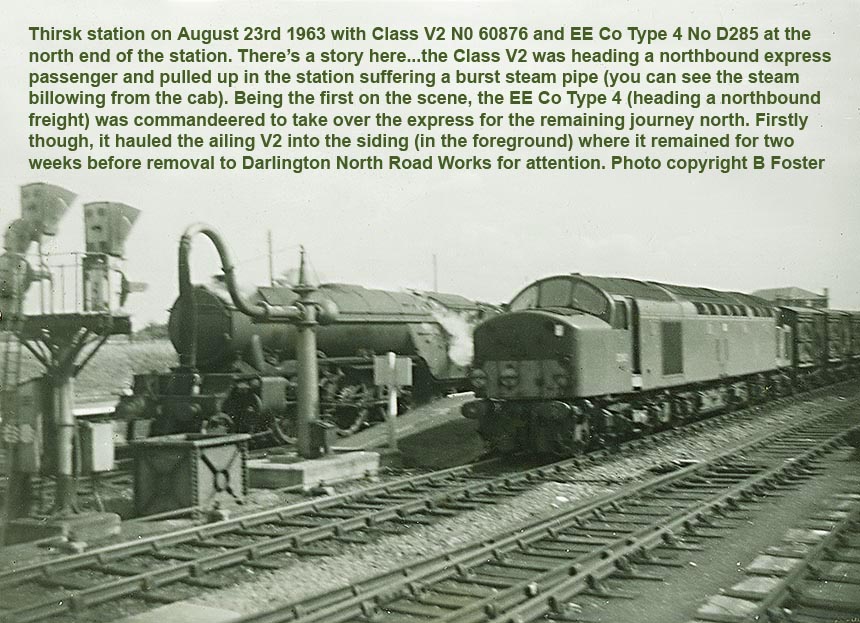

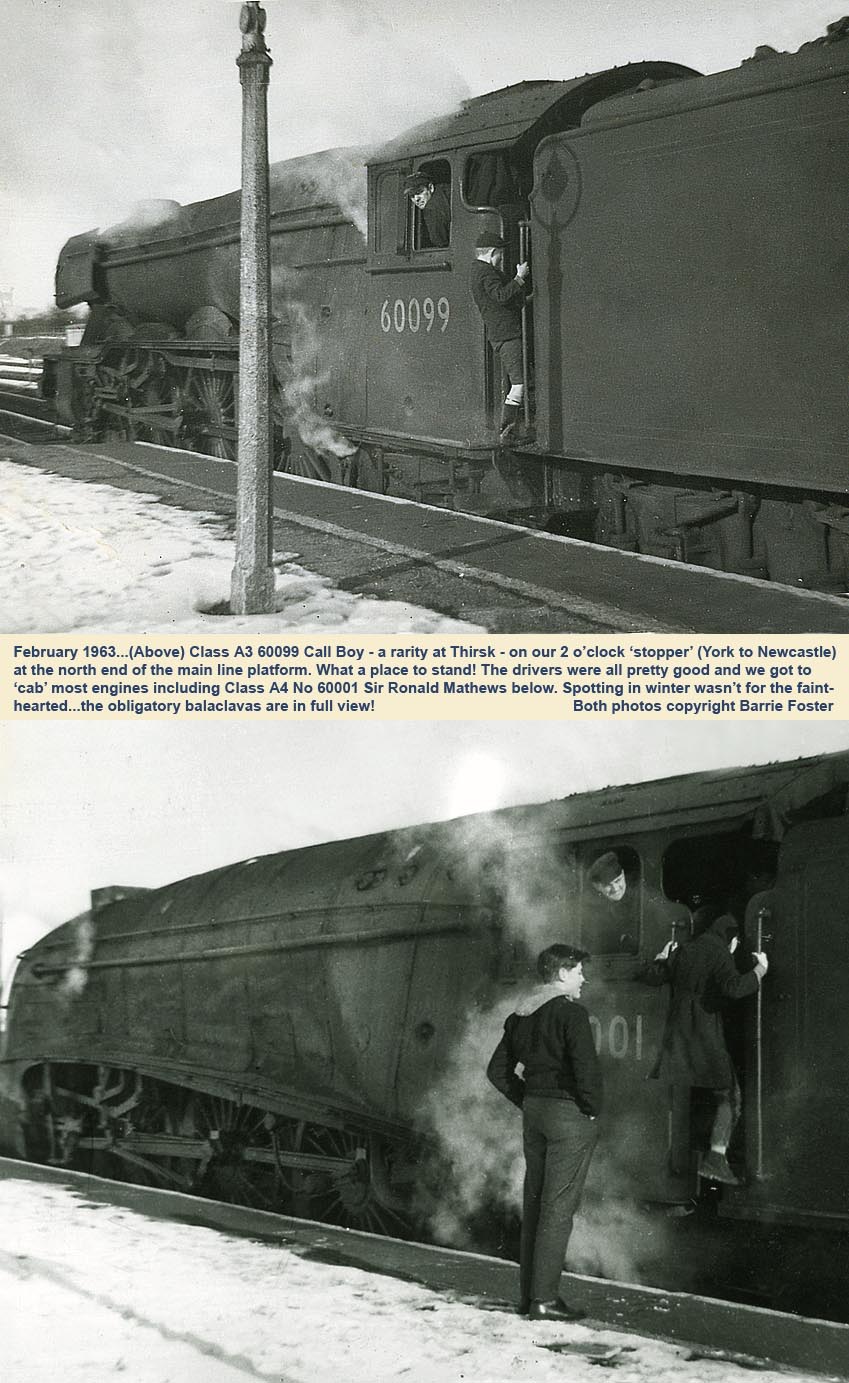
(Below) An unidentified Class 40 with all 'four up' - denoting a Royal Train working - heads north through Thirsk, date unknown.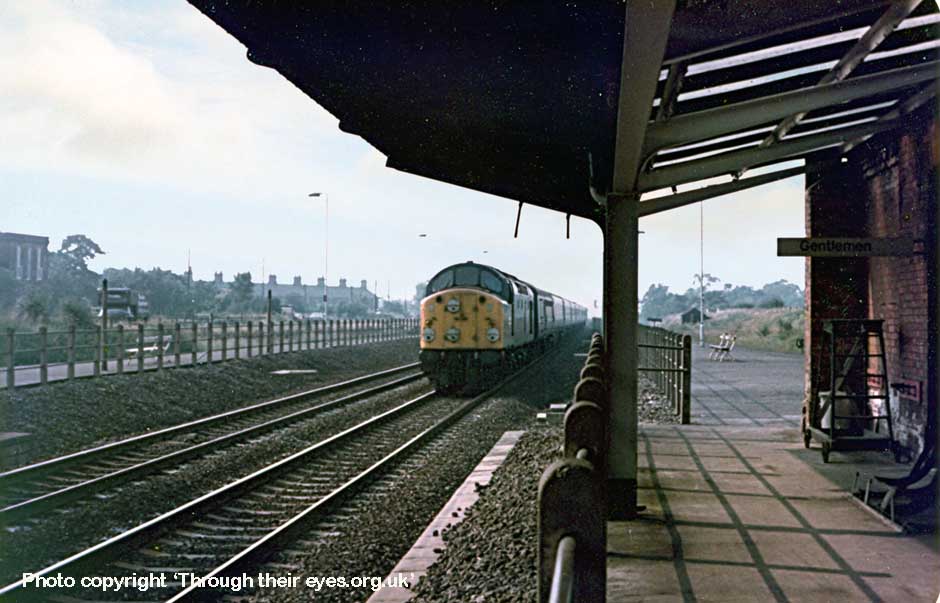
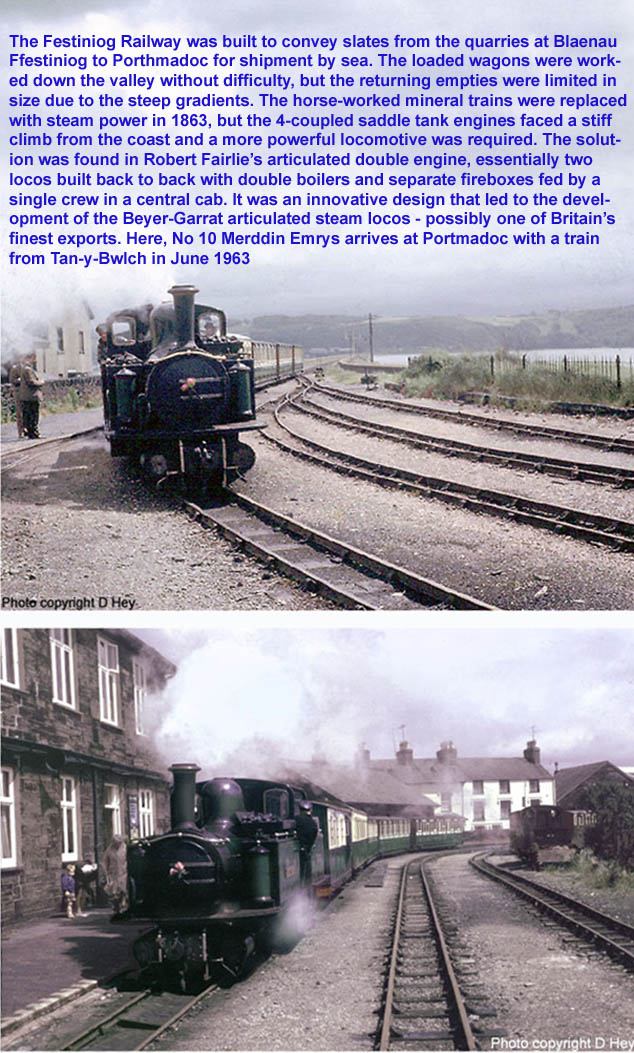
(Above-Below) The smell of a steam engine is one the most delicious in the world, and there are few smells more rewarding than those to be found on a preserved railway. If you can imagine soaking up the freshness of newly-mown grass or the radiance in the street following a good bucketing down of rain, then you'll appreciate the aroma of hot oil and steam that permeates every fibre of your anorak! Established in 1832, the Ffestiniog Railway is the oldest independant company in the world. Following closure in 1946, a group of enthusiasts set about the task of re-opening the line in 1954 and today the company has become a leader in railway preservation. (Below) Painting of 'Linda' at Boston Lodge in 1990.
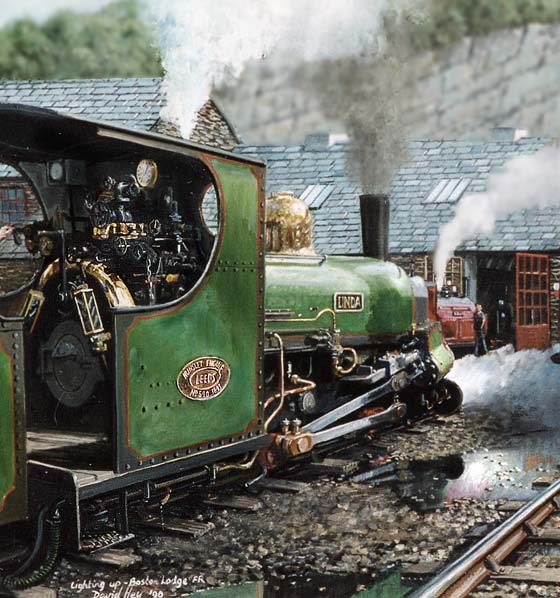
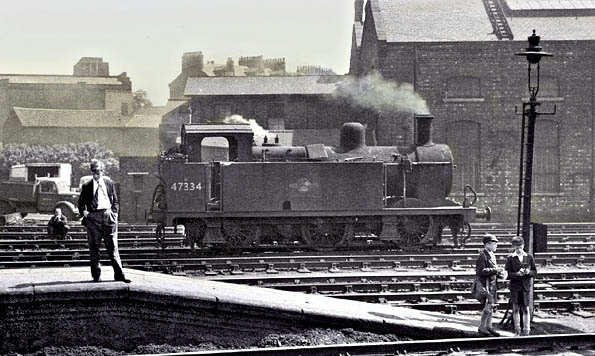
(Above-Below) Comparing notes in their Ian Allan abc books, a couple of spotters await their next 'cop', a meditative teenager contemplates Britain's balance of payments deficit and the driver of 'Jinty' 0-6-0T has a fag break, doubtless looking forward to the end of his shift and a pint in his local BRSA Club. Photo copyright EA Wood-D Hey collection. (Below) Following closure of BR's 5-mile branch from Keighley to Oxenhope in 1962, the KWVR's re-opening of the line in June 1968, just two months before the end of BR steam in August 1968 is a credit to all concerned. Indeed, whilst the rest of us were bemoaning the end of steam like scatterbrained ninnies there was somebody prepared to roll up their sleeves and do something possitive to restore it...
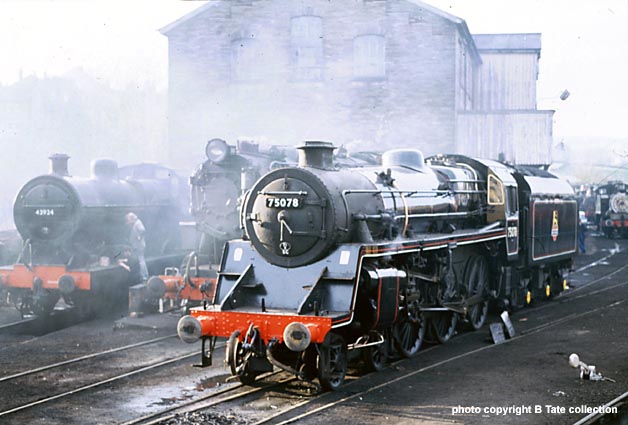
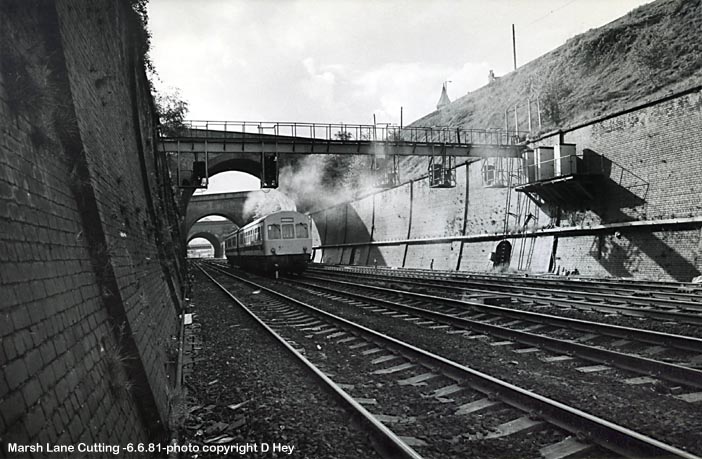
(Above-Below) This country has successfully assimilated overseas immigrants for more than 150 years. The first significant wave came from Ireland to help build our Victorian railways, such as Marsh Lane Cutting in Leeds (above) and Blea Moor picture (below). Indeed the British owe a huge debt of gratitude to the countless thousands of Irish navvies together with the immigrant workers from Commonwealth countries who were actively encouraged by the Government to fill the acute shortage of manpower during the Fifties.
Although my train spotting days have long since gone, it doesn't stop my imagination being fired up and rearing to go. Trouble is, as you get older - well past the 'Big Six-0' - the sedentary lifestyle that comes with getting older is profoundly depressing, so wallowing in nostalgia for the old days is a great way of seeking refuge from the grim reality of our crazy world. And in case you're wondering, I am not alone in some reactionary minority. A huge number of my generation lament the erosion of common decency, politeness and, above all else, a respect for wholesome family values and Britishness.
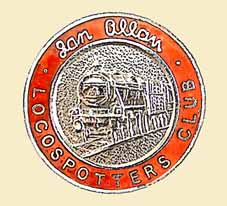 How things have changed! Back in the Fifties boys loved train spotting. Membership didn't depend on birth. It was an open shop and anyone could join. The camaraderie between spotters was on a par with the banter between football supporters today. For example, my soccer-mad grandson wears a replica Leeds United FC shirt. Fifty years ago, I wore an anorak with Ian Allan enamel badges emblazoned on the sleeves. This show of solidarity must be in a boys' genes, because youngsters love to wear badges, caps, scarves - even stick-on tattoos - to show their loyalty. In fact, there are many similarities between soccer fans and trains spotters, though it is scarcely apparent at first, yet both groups experience every emotion from great joy to deep despair. For example, my grandson was devastated by Leeds United's spectacular fall from grace at the end of the 2003-4 Premiership season. His utter dejection reminds me of how I felt when steam ended all those years ago...if we could only turn the clock back to halcyon spotting days when life was just so simple then, when a 1d platform ticket gave youngsters umpteen hours of sheer enjoyment...
How things have changed! Back in the Fifties boys loved train spotting. Membership didn't depend on birth. It was an open shop and anyone could join. The camaraderie between spotters was on a par with the banter between football supporters today. For example, my soccer-mad grandson wears a replica Leeds United FC shirt. Fifty years ago, I wore an anorak with Ian Allan enamel badges emblazoned on the sleeves. This show of solidarity must be in a boys' genes, because youngsters love to wear badges, caps, scarves - even stick-on tattoos - to show their loyalty. In fact, there are many similarities between soccer fans and trains spotters, though it is scarcely apparent at first, yet both groups experience every emotion from great joy to deep despair. For example, my grandson was devastated by Leeds United's spectacular fall from grace at the end of the 2003-4 Premiership season. His utter dejection reminds me of how I felt when steam ended all those years ago...if we could only turn the clock back to halcyon spotting days when life was just so simple then, when a 1d platform ticket gave youngsters umpteen hours of sheer enjoyment...
WHY BAN TRAIN SPOTTERS FROM RAILWAY STATIONS?
If you're past the 'Big-Five-0' the following lyrics will ring a bell.
'I'm sitting in the railway station,
Got a ticket for my destination,
On a tour of one night stands,
My suitcase and guitar in hand,
And every stop is neatly planned,
For a poet and a one man band…'
This is a defining moment for me. At long last, after years of deliberation, I've ditched my trusty old Canon A1 35mm camera. I'm about to take a giant leap into digital photography!
Tar-raaah!
Well, it's not every day I get the chance to try my hand at new-fangled cutting edge technology - better late than never, I suppose.
So what, pray, has a Simon & Garfunkel song lyric from the 1970s got to do with me going digital?
Well, I'm sitting in Leeds railway station with a ticket for Church Fenton, and though I haven't a suitcase and guitar in hand, I do have a camera bag containing a Nikon D1 with two lenses: 20-35mm and 80-200mm, courtesy of my non-anorak pal, Phil Spencer - and I'm itching to get started, only there's a problem…'
And every stop is neatly planned?' I wish it was, but the opposite is true. I thought I'd update the site with 'before-after' photos of railway stations, starting at Church Fenton. But it'd be stupid to even try…
I know there is a terrorist threat. It's as plain as day why the railway authorities want to impose a ban on train spotters at railway stations. Ever since the 9/11 attacks and the London bombings, who in their right mind is going to object?
But why single out train spotters? It doesn't make sense!
The train spotting fraternity provides the 'eyes and ears' of a railway station, our expert observations can spot a misdemanour a mile off. For example, I have an hour to kill before my train is due. Not that I'm in any 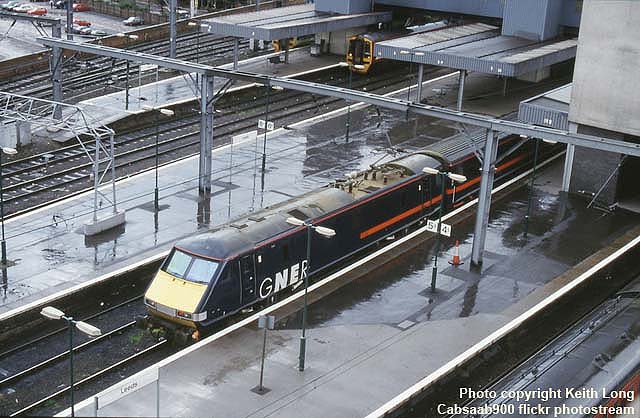 hurry. I'm happy to be sitting in a quiet corner of a café terrace, watching the world go by. And I don't mind the espresso coffee being served in a polystyrene coffee cup either, though the plastic stick is a poor excuse for a spoon; how am I supposed to salvage the soggy digestive I've just dunked? The coffee is scalding hot and the woman on the next table is smirking at my dilemma behind her 'Hello' magazine.
hurry. I'm happy to be sitting in a quiet corner of a café terrace, watching the world go by. And I don't mind the espresso coffee being served in a polystyrene coffee cup either, though the plastic stick is a poor excuse for a spoon; how am I supposed to salvage the soggy digestive I've just dunked? The coffee is scalding hot and the woman on the next table is smirking at my dilemma behind her 'Hello' magazine.
This couldn't have happened at a worse time. After all, I'm a railway photographer on a reconnaissance mission and the last thing I want to do is draw attention to myself. I abandon the coffee and watch the hustle and bustle of commuters coming and going, jabbering animatedly into mobile phones, clearly not concentrating on where they walk. It's a miracle they don't collide into one another or trample an innocent child underfoot, and I do wonder why everyone is in such an almighty rush these days? It reminds me of Desmond Morris's fast-frame TV films of ant-like crowds darting about public places in the 1960s.
But not everyone I see is in a hurry; there's a guy in a dirty raincoat seemingly dead on his feet from the night before, yet somehow still managing to sucker gullible passers-by into handing over loose change for a bite to eat - who's he kidding? It's for the off-licence…we both know that! Then there's the stout Muslim woman in a full burqa, or it could be a man, it's hard to tell the gender.
But beggars and burqas are not the only gripe I have. Just as bad are the two thug-like hoodies sitting a few tables away, feet on chairs, scarcely older than 3rd Form school kids, yet casting belligerent looks at anyone daring to make eye contact. They seem to regard the world around them with a mask of hard-faced 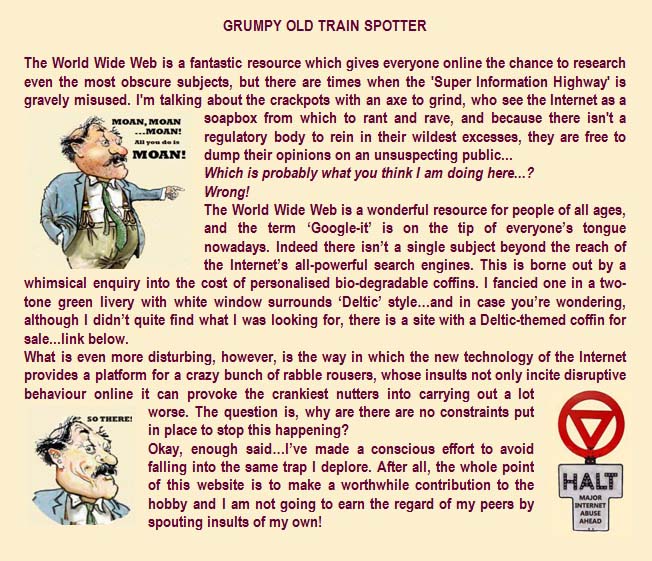 indifference like a couple of plebeian hoodlums from a Quentin Tarantino movie.
indifference like a couple of plebeian hoodlums from a Quentin Tarantino movie.
Then there's the guy in shades ogling a group of tipsy women on a Hen-Night, tottering by in mini skirts and stiletto heels and, unless my mind is playing tricks, he's probably a perve getting his kicks hiding behind his so-called cool facade. But of course, one can't see his eyes so it would be wrong to swear by it.
And this is precisely my point...I feel intimidated when people hide their identities beneath hoods, robes, shades - all of which provide a perfect disguise for an Al-Qaeda terrorist, yet unless I'm very much mistaken, out of everyone there, I'm the only one under close scrutiny.
After all, I'm a train spotter - my trademark anorak is the biggest clue and the pom-pom hat is a dead giveaway too. I imagine a barrage of CCTV security cameras pointing my way; they're probably zooming in on the camera bag at my feet, and it's at moments like this I wish I'd stayed at home. My gut instinct has never let me down before, and right now it's telling me that if I don't skedaddle fast I'll be a sitting duck. So I make a move to leave, but it's too late - the station has gone to Code Red - 'Warning! Train spotter in Sector Two, approach with caution, probably stark-raving mad!'
In that same instant I'm surrounded by armed police crouched in a combat position, legs apart, shoulder-to-shoulder, each aiming automatic weapons in my direction - guns to the left of me, rifles to the right, and 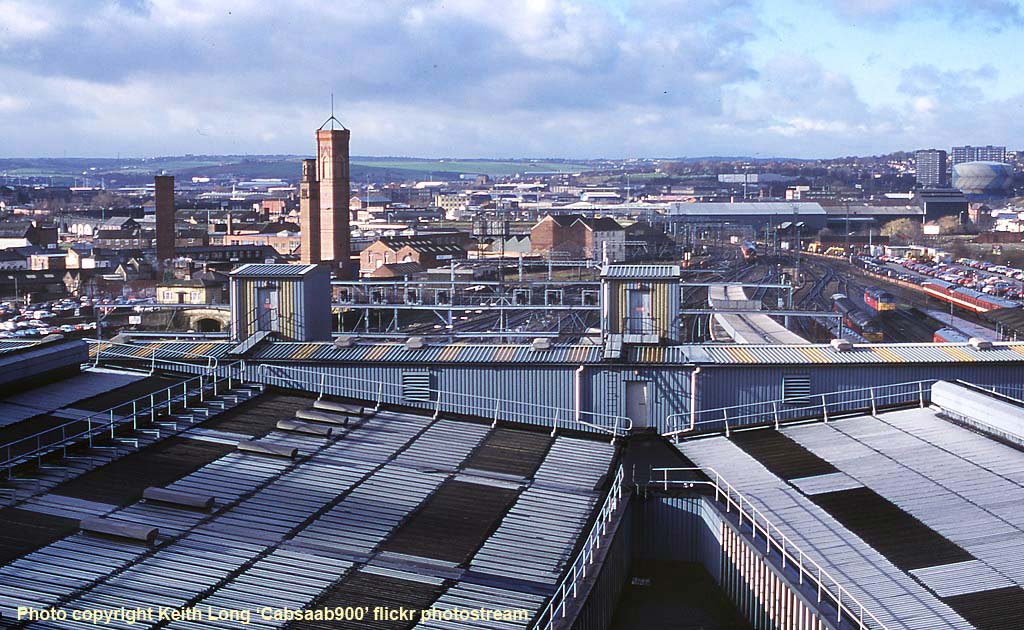 here I am stuck in the middle - singled out by some young upstart of a jobsworthy who adjudges me to be a dead ringer for an undercover terrorist operative.
here I am stuck in the middle - singled out by some young upstart of a jobsworthy who adjudges me to be a dead ringer for an undercover terrorist operative.
Okay, I made the last paragraph up - it adds drama to the story, and you might be forgiven thinking I'm turning into a right old miserable so-and-so - and you're right! I'm fed up of today's second-rate celebrity culture, the legion of greedy bankers and their bonuses, the brass neck of self-serving MPs 'fiddling' their expenses and alternative comedians cracking unfunny jokes about tampons.
Most of all, I'm concerned about the public's perception of train spotters...a topic that needs seriously addressing, and one I'll never tire of defending. That's why the ban on spotters should be lifted. After all, the Government can't have it both ways; human rights legislation should work equally for everyone and the heavy-handed treatment of train spotters is a breach of our civil liberties, is it not? This, surely, is the crux of all that is wrong in this barking-mad world...
(Details for above photos inset right) 91030 awaiting departure from Leeds at the rear of the 18.40 to London Kings Cross on 4th April 1998...a view from the signalbox roof of the new Leeds station on 17th February 1995. Both photos taken by Keith Long...click here to visit Keith's 'Rail Cameraman' page.
For the macabre, click here for tongue-in-cheek link to Greenfield Creations (coffins).
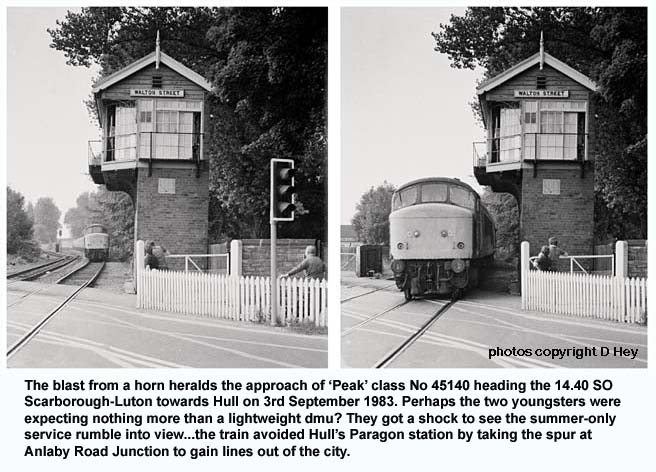
![]() I have received an email from ex-spotter Craig Duncan, now living in South Africa. He writes - 'Hi David, to provide a memory jog I have been researching the times that the 'Thames-Clyde' and the 'Thames-Forth' came through Skipton in the mid-to-late 1940's. As an aside I started train spotting in north-east Lancashire in 1944 (yes I am that old).
I have received an email from ex-spotter Craig Duncan, now living in South Africa. He writes - 'Hi David, to provide a memory jog I have been researching the times that the 'Thames-Clyde' and the 'Thames-Forth' came through Skipton in the mid-to-late 1940's. As an aside I started train spotting in north-east Lancashire in 1944 (yes I am that old).
Anyway purely by chance I came across your site. I can fully appreciate the dedication applied in its development and the pleasure derived in being able to share it with others. It will certainly keep me going for a long, long time.
An interesting article worthy of comment is your 'Trainspotters 1 - The True Story'. I offer my support to your comment about the cynical view of the British media not only towards locospotters (which I was unaware) but also for any group or individual that comes within their cross-hairs and without fear of redress. Towards the end of the article you appear to highlight a decline in moral and ethical standards over the years; again my full endorsement.
That said, I too used to put a penny on the track at Preston station so that I could brag - 'This was flattened by Queen Mary' (the streamliner, that is).
On 1st of January 1969 I arrived in South Africa to witness a new steam scene, and its eventual demise. At 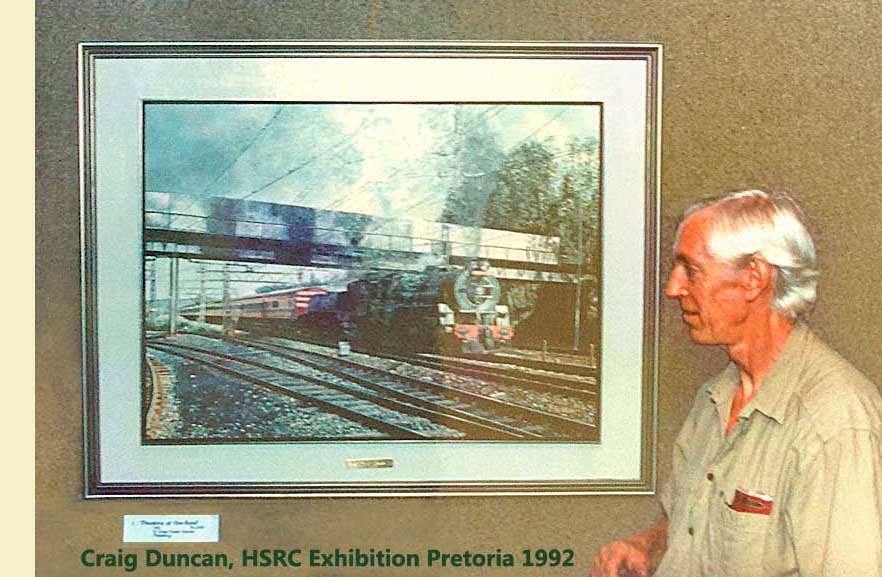 the time I could not visualize that trainspotting would continue into the diesel era. Yes I too remember the Billy Bremner era and my visits to Headingley, being also a Rugby League fan. Ah well, c'est la vie.
the time I could not visualize that trainspotting would continue into the diesel era. Yes I too remember the Billy Bremner era and my visits to Headingley, being also a Rugby League fan. Ah well, c'est la vie.
Kind regards…'
Craig is also a dab hand with a paintbrush! See inset right. I'm hoping he'll send a few pics to feature on the site; it may inspire others to do the same. The marvel of the Internet allows enthusiasts to communicate instantaneously across the world.
Craig adds - 'Yes the WWW is a lot faster than the Union Castle mail ships of yesteryear, which reminds me...you have posted an excellent photo of Paarden Eiland locomotive depot (see Trevor Ermel's South African railtour featured on P70).
Apart from Table Mountain the depot was my main focal point from Table Bay on the early morning of New Years Day 1969 upon our arrival.
We had a memorable 10 day voyage from Southampton aboard the Pendennis Castle and a very smoky Paarden Eiland was my 'Welcome to South Africa'. Coincidentally the tugs took our ship into the berth at Duncan Dock (!) in Cape Town.
It is good to see your Yorkshire humour punctuate the pages. Certainly you may post my oil paintings on the 'Spotting' page in part or in whole, your call. It is right that we locospotters (or in my case, ex) should band together since we are gradually becoming an endangered species, n'est pas?
Best regards, Craig...'
Footnote...check out Craig's paintings on Page One.
![]() My thanks also to Keith Browning for contacting the site. He writes - 'Hi David, I have just spent a wonderful hour looking through your website, and how it brings back memories. My family lived on the Eastern Region, Colchester and Peterborough in the 50s and the Western Region, Cardiff in the early 60s before moving to Woking in 1964, where I commuted as a schoolboy to Guildford every day during the final years of steam. I was Secretary and Chairman of the RGS Guildford School Railway Society, and we took every opportunity to chase steam all over the country from 1965-68. Little did we know that many of the cross country routes we took were soon to close? One or two of the older boys used to 'bunk off' school on days when a particularly significant line closed.
My thanks also to Keith Browning for contacting the site. He writes - 'Hi David, I have just spent a wonderful hour looking through your website, and how it brings back memories. My family lived on the Eastern Region, Colchester and Peterborough in the 50s and the Western Region, Cardiff in the early 60s before moving to Woking in 1964, where I commuted as a schoolboy to Guildford every day during the final years of steam. I was Secretary and Chairman of the RGS Guildford School Railway Society, and we took every opportunity to chase steam all over the country from 1965-68. Little did we know that many of the cross country routes we took were soon to close? One or two of the older boys used to 'bunk off' school on days when a particularly significant line closed.
One of the last steam trips must have been Easter 1967, when we searched the outposts of the Southern Region looking for the last few locos at Eastleigh, Southampton, Weymouth and ending up at Salisbury, where there were still a couple of locos in steam. Our train back up the main line to Woking arrived behind a 'Warship' class diesel with a smashed windscreen. The only suitable loco to get us home was a West Country idling in the shed. Our hopes were quickly dashed when the Warship was detached and turned on the shed turntable and we went home behind the diesel.
One supposedly non-railway school trip was our school scout troop camp to North Wales in 1966. We caught the 'Cambrian Coast Express' from Paddington via Princes Risborough and Birmingham Snow Hill, and on reaching Shrewsbury this turned into a feast of steam, with no signs of a diesel all the way to the Welsh coast, however the term 'express' was really a misnomer as it became a stopping local once we reached Wales.
When steam was all gone I organised one of the first ever visits to Barry, where we marvelled at seeing all the locos missing from our spotters book. I wish I had had the foresight to buy one! I also wish I had kept the letter sent to me by Dai Woodham, saying he would be delighted for the school to organise a trip. I think that was probably 1968. I particularly remember seeing 'Duke of Gloucester' - a loco I had long wanted to add to my abc book.
There were also many days spent around London stations and sheds, and on the end of Reading station. My mother was a protective soul, but in 1965 was quite happy for me to wander around London on my own or with a friend from the age of 13. Reading often brought newly-outshopped diesels from Swindon, gleaming and finished to the traditional high standards of the old GWR.
Later there were some wonderful 'Day Return' fares, which meant my 'paper round money' was enough to get me to Crewe and Nottingham…£1 return to Crewe rings a bell! The Nottingham trip was to visit Toton shed and its 200 plus diesels. On Sunday they were all there just lined up waiting to be 'copped'. One of the other 'spotters' suggested we catch a bus to Colwick in east Nottingham, where despite our scepticism we were rewarded with a collection of Eastern Region locos, some still in steam. Officially they should all have been sent to the breakers by then.
I also caught what I believe was the last active steam loco on the Western Region, moving carriages at Paddington Station. Again officially it didn't exist.
However, the main reason for writing is your photo of the track north of Peterborough North Station on your 'BR Eastern Region page'. I am convinced the reason I've had a lifelong love affair with railways was because my mother took me to stand on that bridge in 1958. She held me up to see trains and called out the names of the locomotives and the destination boards. There are people standing on the bridge in the photo, and I actually might be one of them. To see those wonderful sights and sounds as a six year old was very informative. With New England shed in the background this had to be one of the top three trainspotting places in the UK and I was taken there by a mother who knew nothing about railways. I am presently writing my autobiography and have been searching for a photo of Peterborough North in that period. Your photo exceeds my wildest expectations; thank you for sending it.
We travelled to most places by train and I do recall our late 50s cross country journeys to Colchester via March and Ely. This route lacked any of the glamour of the main line and was rather tedious for a young boy with his nose stuck firmly to the window. Catching the train from Colchester St Botolph's to Clacton was also an abiding memory. The aged rolling stock was crammed with families, laden with everything needed for a 50's family outing to the seaside. My grandpa always wore his second best suit for the day. The queue at Clacton station on the way home seemed to go on forever.
The other vivid memories was a couple of years later standing on the small platform at Pilning waiting for the car shuttle under the Severn Tunnel, and being blasted by the Castles and Kings that hammered through the station at about 80mph. I seem to remember everyone pinned against the back of the platform because of the rush of soot and steam.
The final memories were standing on West Byfleet station every morning at 7.55 as a Bournemouth express flew through the station behind a West Country. As the months passed the quantity of ash and cinders thrown out from every orifice of the locos increased, and frequently all the commuters on the station were sprayed with dust. One morning we had to run for cover to avoid the red hot cinders being ejected from a hole in the loco somewhere.
Anyway, happy days and memories all brought back by your website
Thank you, Keith Browning
PS. I forgot to mention 'Spam Cans'. I only heard the phrase for the first time 4 or 5 years ago. It was not a term I ever heard during my train spotting days, when I had a daily association with the unmodified WCs and BBS. We called them 'flat tops'. Perhaps the phrase might have been used outside the Southern Region by 'northerners' as a derogatory term for these unusual looking locomotives?![]() My thanks to Phil Quantock for contacting the site. He writes - 'Hi, just spent an enjoyable hour or two on your website. I was just old enough to see the final years of steam on the Cheshire Lines route from Northwich. Our back garden looked over the railway at Plumley, and my earliest memories are of steam freight trains - mostly 8F or 9F locos. However as my dad worked on the 1500v DC trains at Altrincham Carriage Shed as a cleaner, my interest in electric traction came early as he took me to the shed every pay day.
My thanks to Phil Quantock for contacting the site. He writes - 'Hi, just spent an enjoyable hour or two on your website. I was just old enough to see the final years of steam on the Cheshire Lines route from Northwich. Our back garden looked over the railway at Plumley, and my earliest memories are of steam freight trains - mostly 8F or 9F locos. However as my dad worked on the 1500v DC trains at Altrincham Carriage Shed as a cleaner, my interest in electric traction came early as he took me to the shed every pay day.
Thankfully in the north of England (Stafford and Doncaster northwards) the problem of railway photography is largely a thing of the past nowadays, as the staff are okay with us hanging around, though down south it can still be a real pain which is such a shame.
Over the years I have been called every name under the sun, had lumps of concrete, tin cans, and other assorted missles thrown at me while standing on a bridge minding my own business waiting to photograph a train.
I forget which newspaper it was that started it off. I think it was in the early 80's that one of the rags had a middle page spread with the header 'Trains Spotters, a national joke' or similar. I don't object to folk going fishing, watching footie, or other hobbies, so why should mine be so mocked, and why should those of us who follow it be made out to be a penny short of a pound?
Best wishes, Phil…'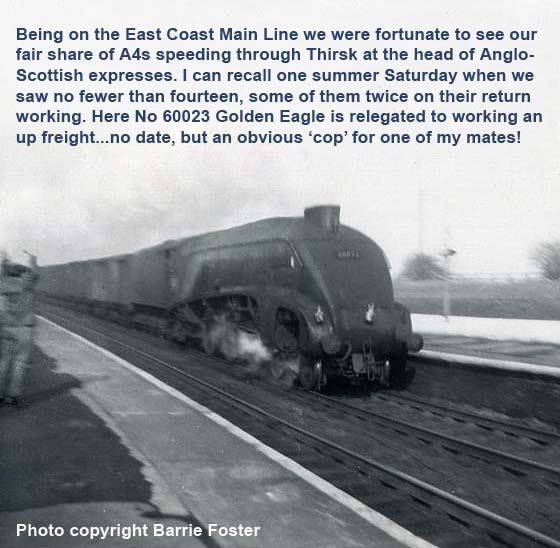

Polite notice: All text and photographs are protected by copyright and reproduction is prohibited without the prior consent of the © owners.
If you wish to discuss the contents of this page the email address is below. Please note - this is not a 'clickable mail-to link via Outlook Express:
dheycollection@ntlworld.com

Great Central Railwayana Auctions....click here.
GW Railwayana Auctions.....................click here.

